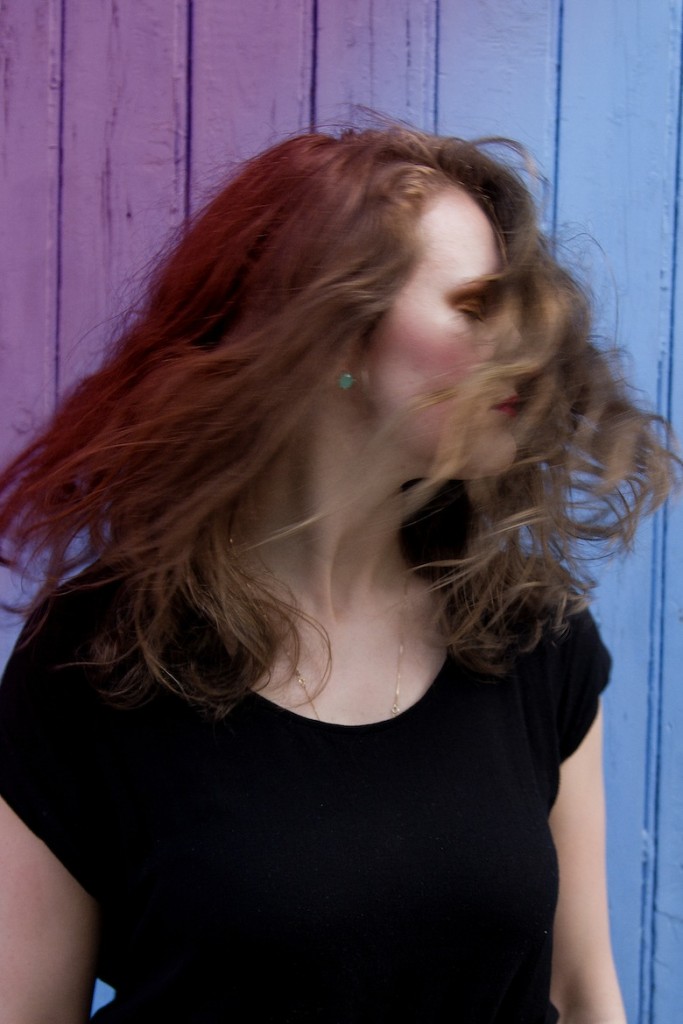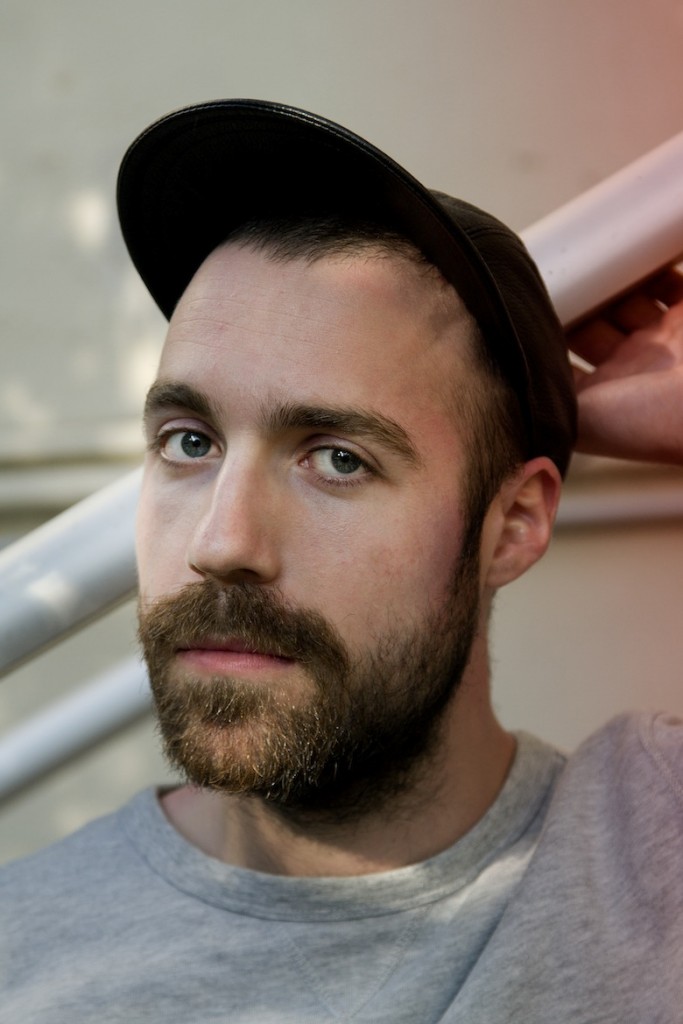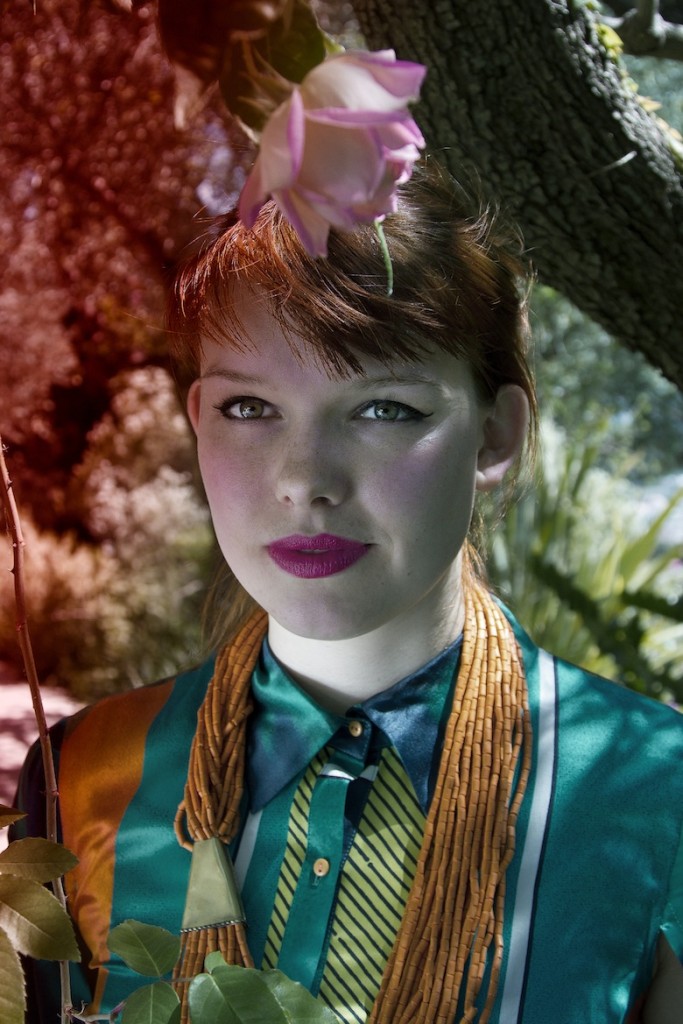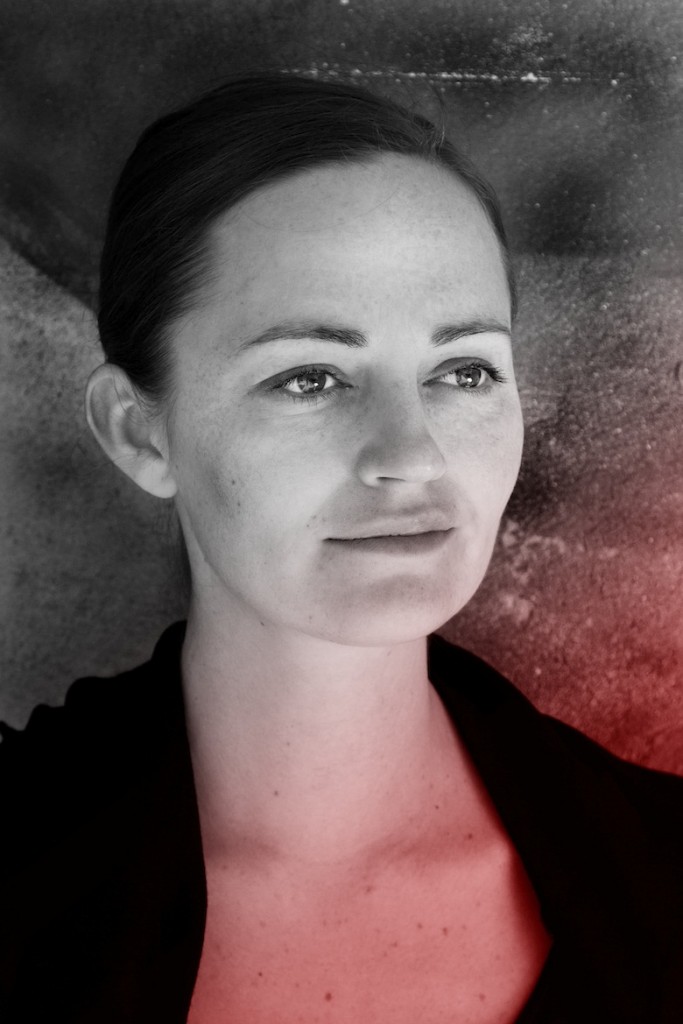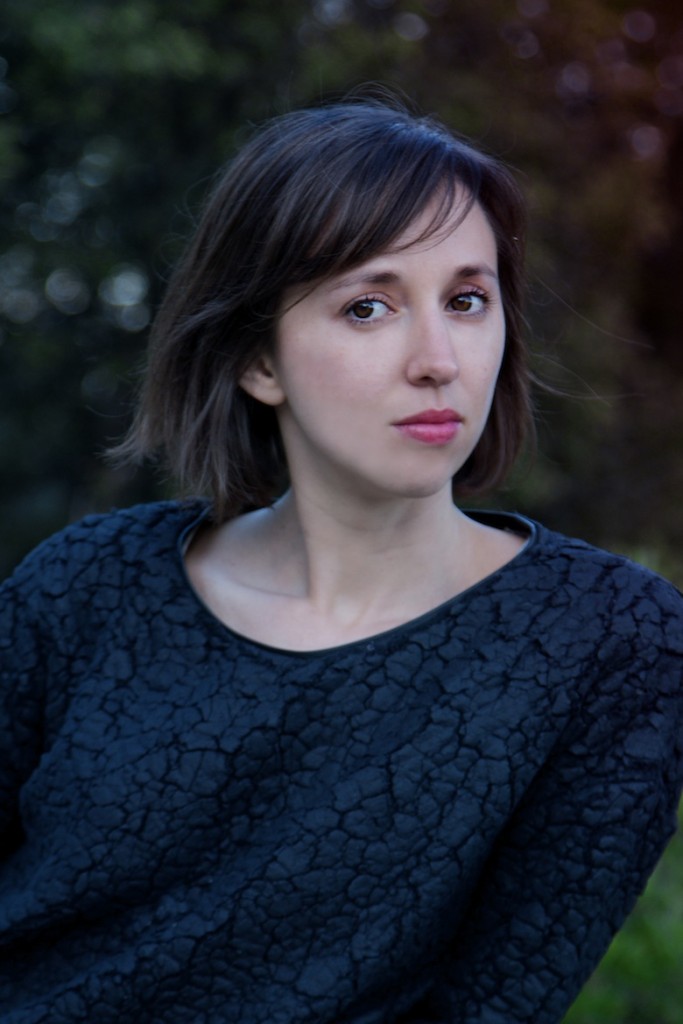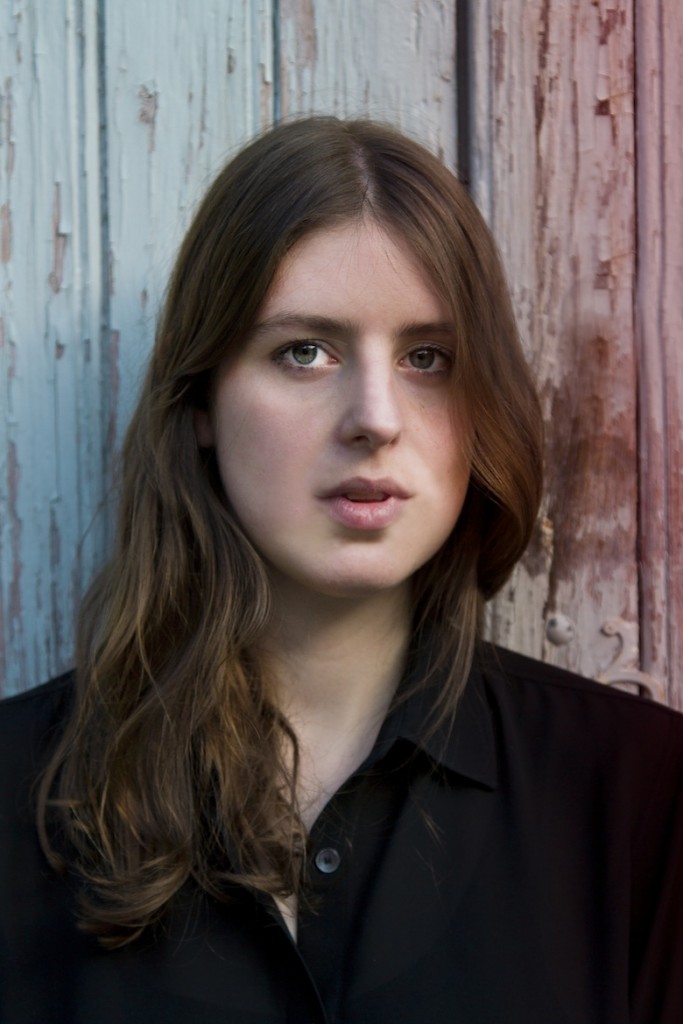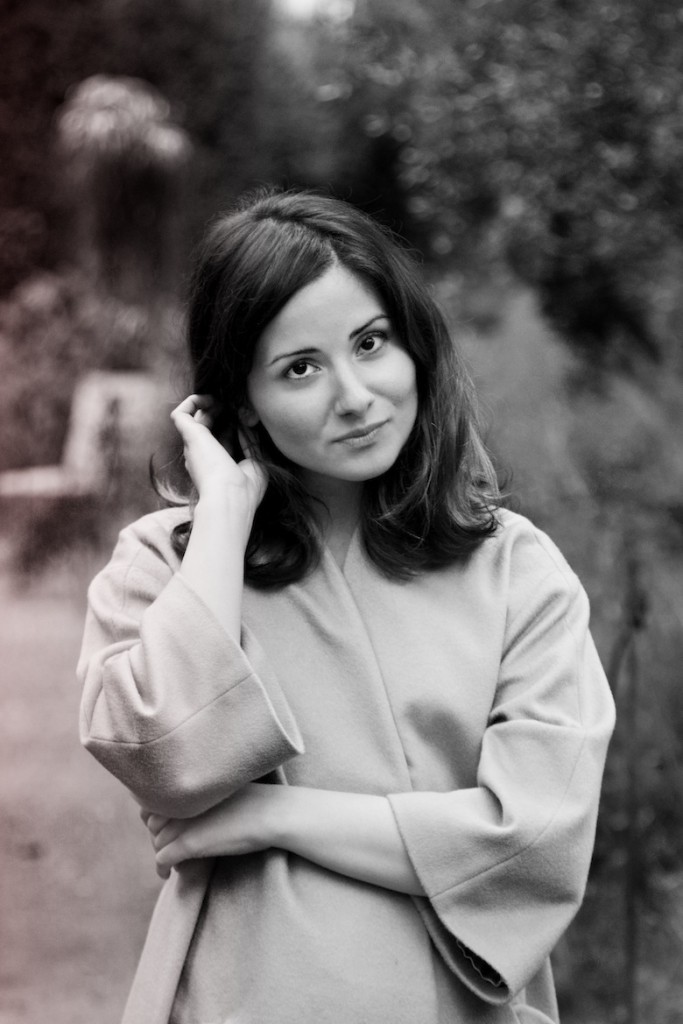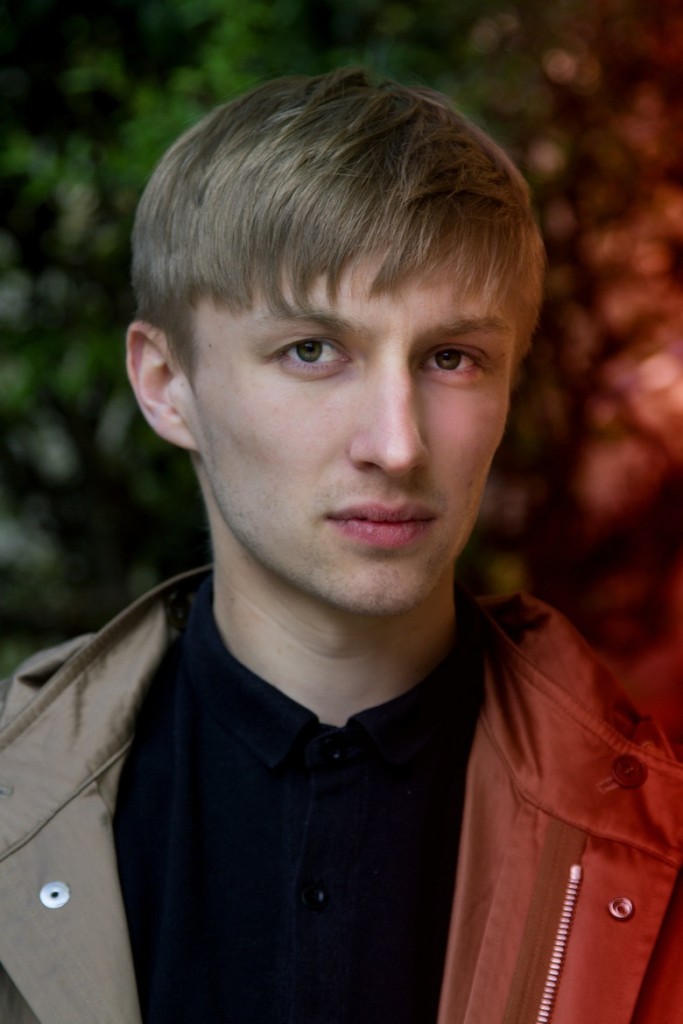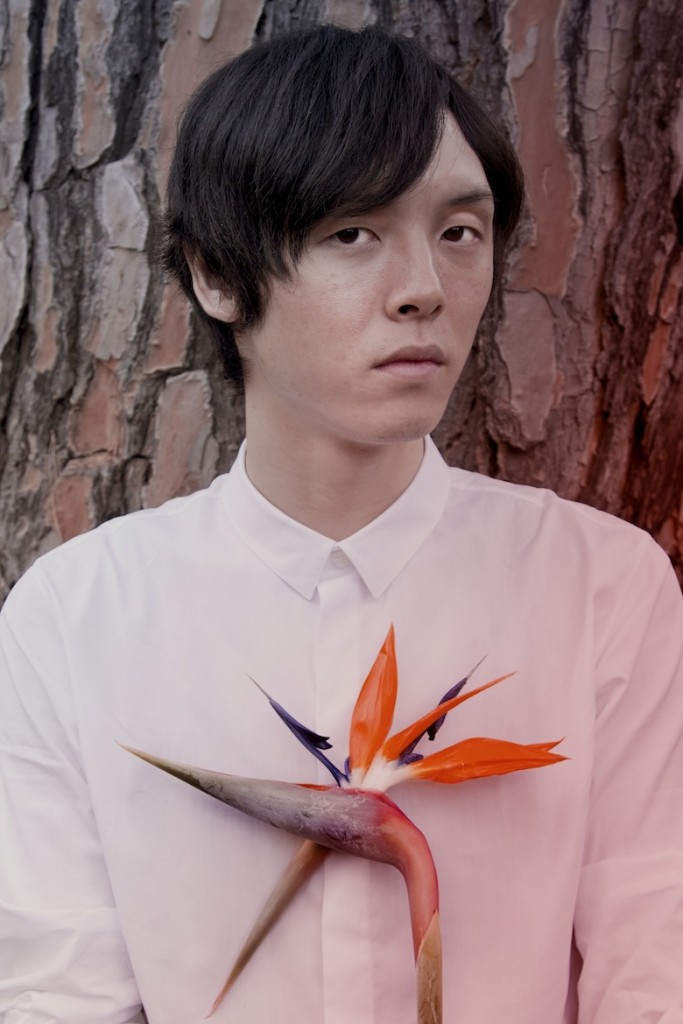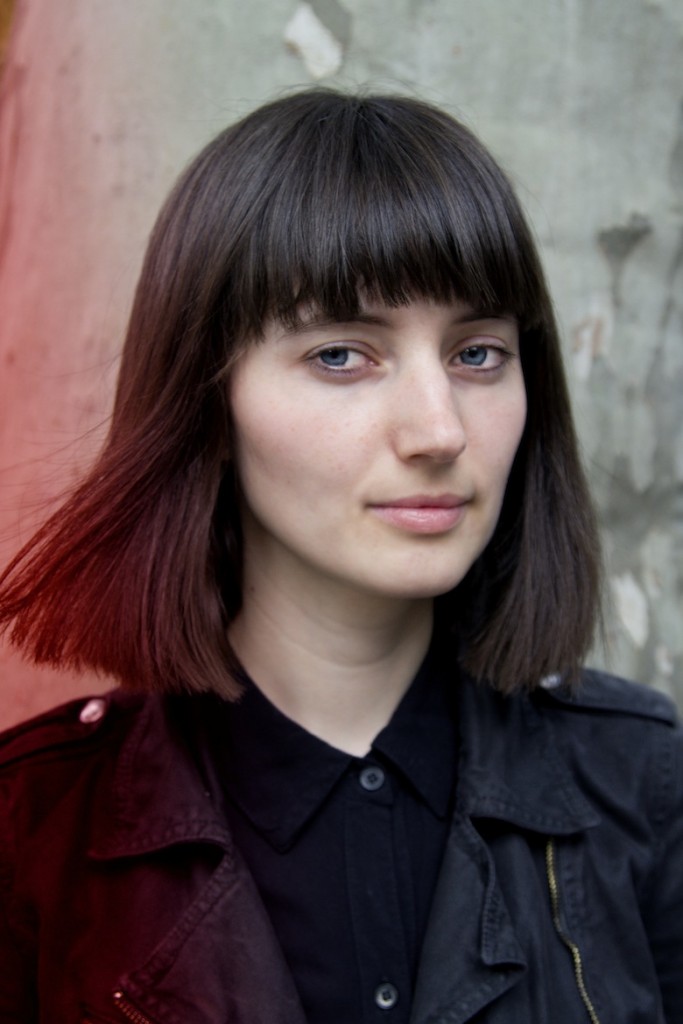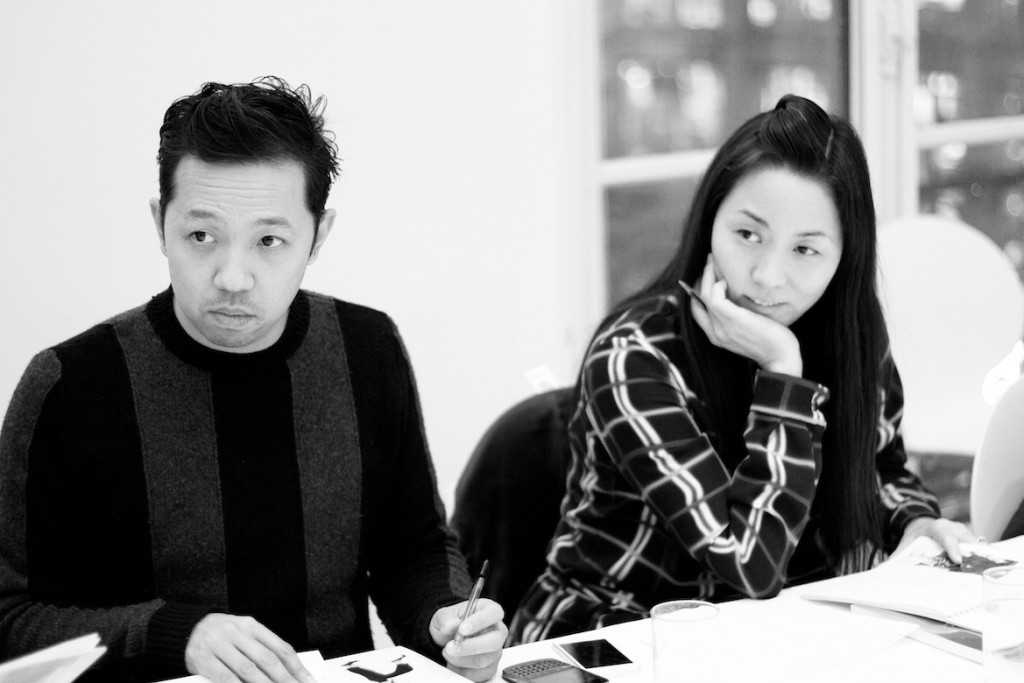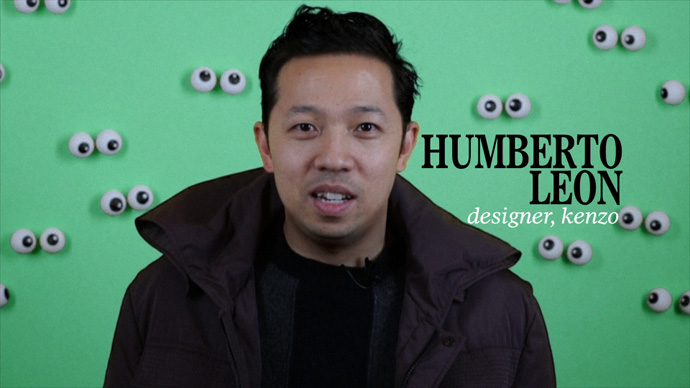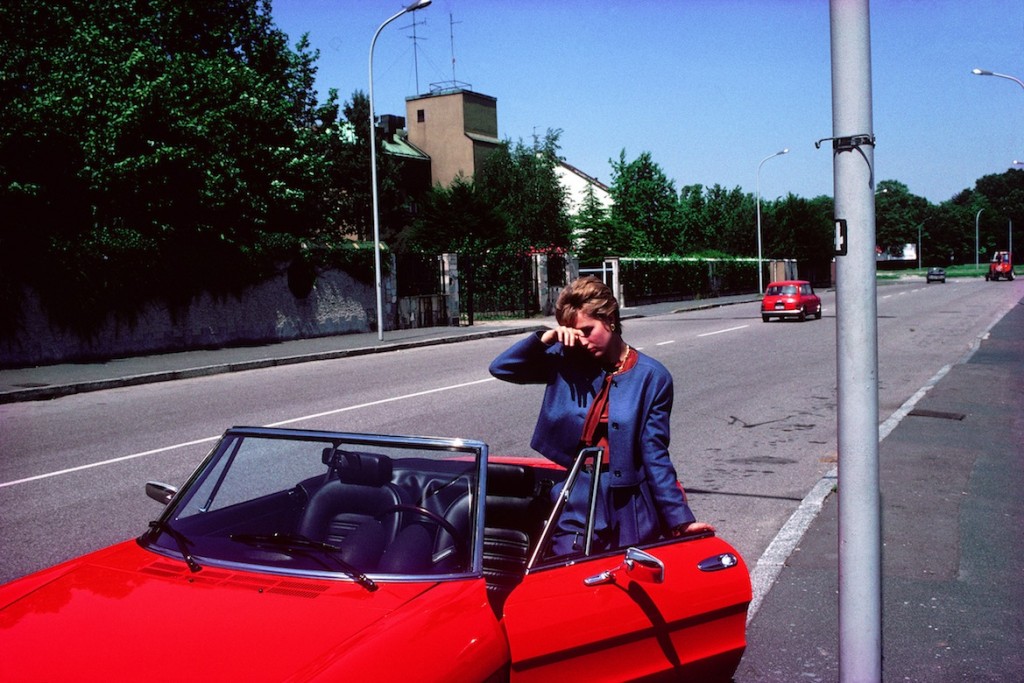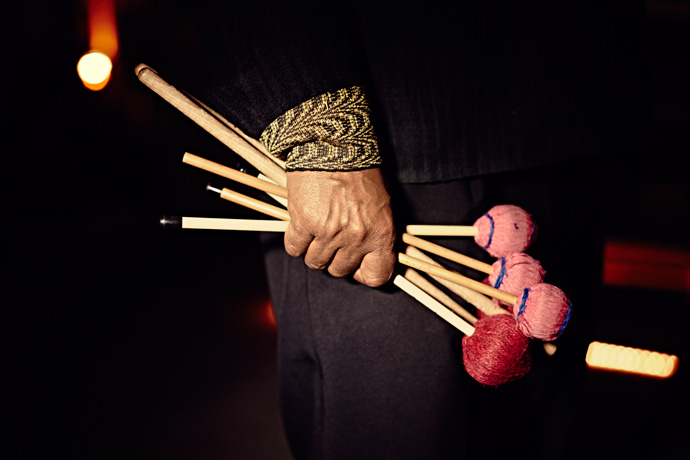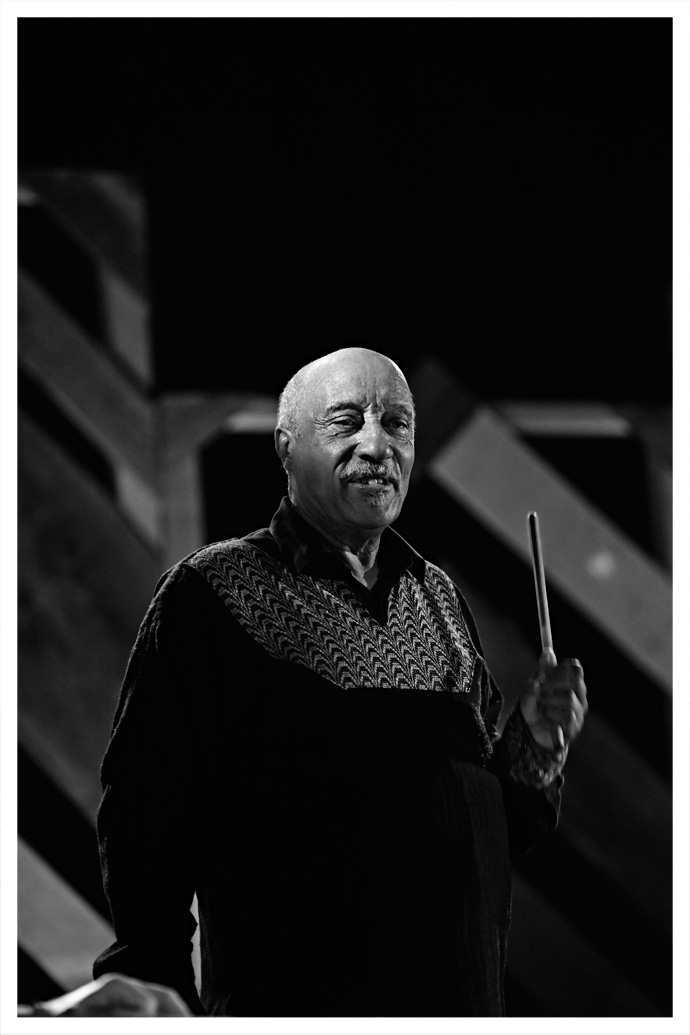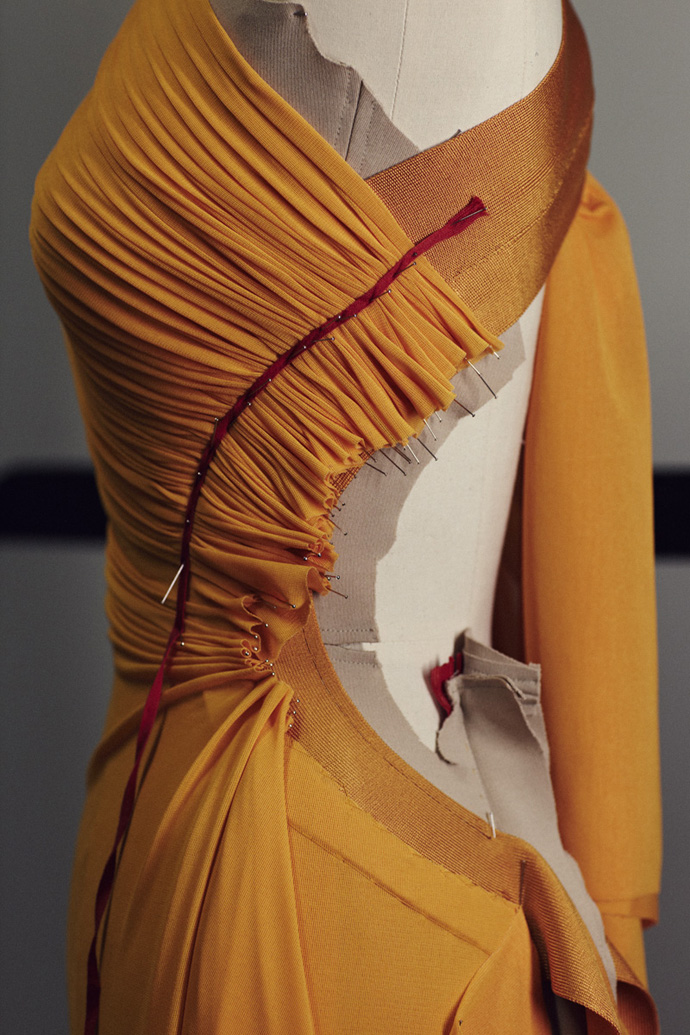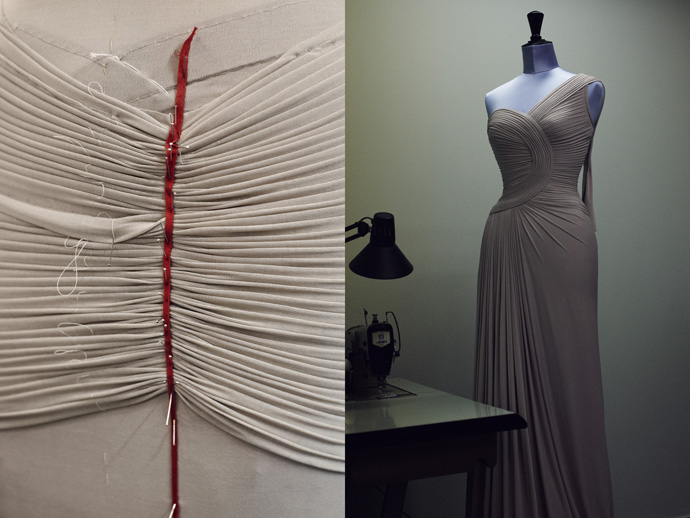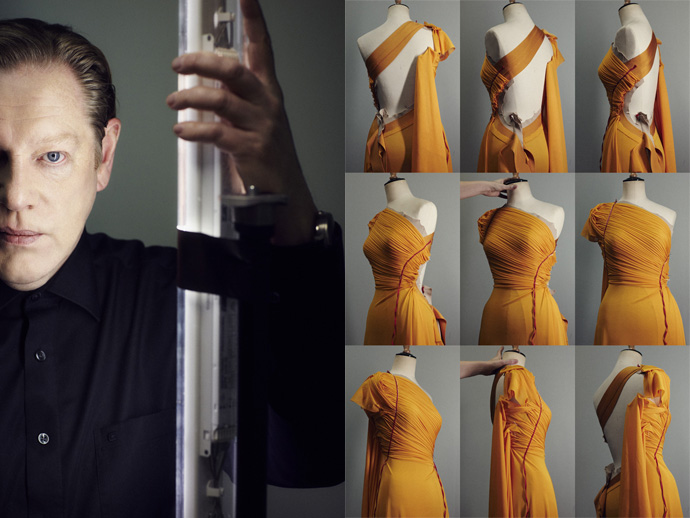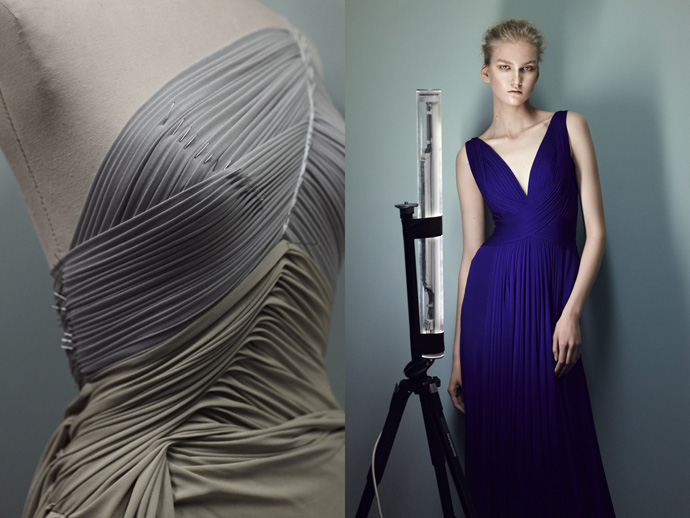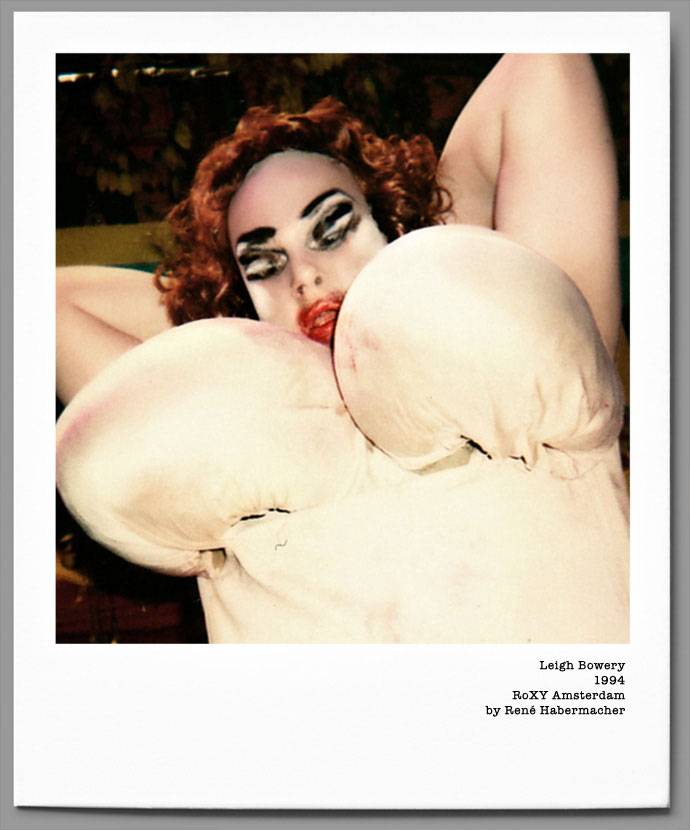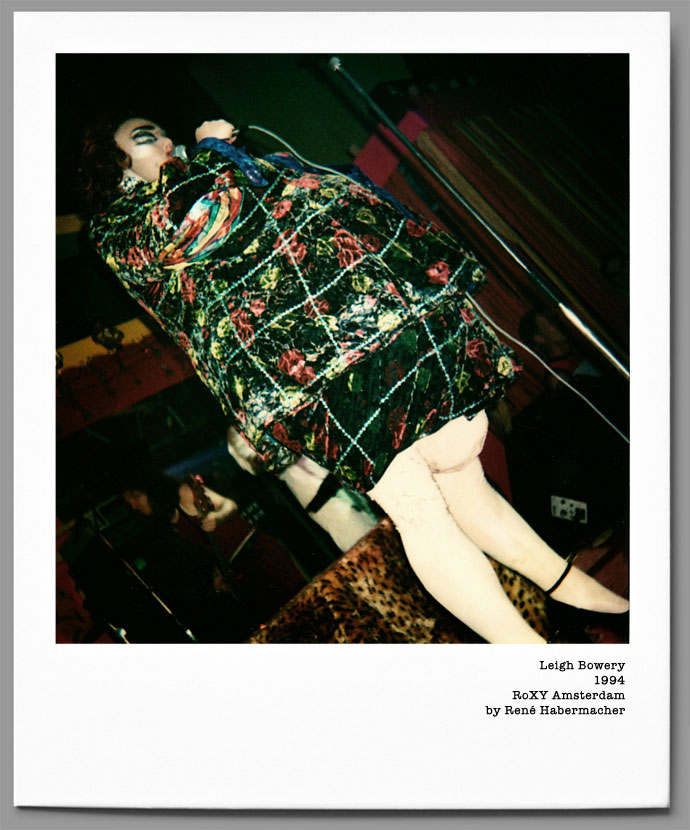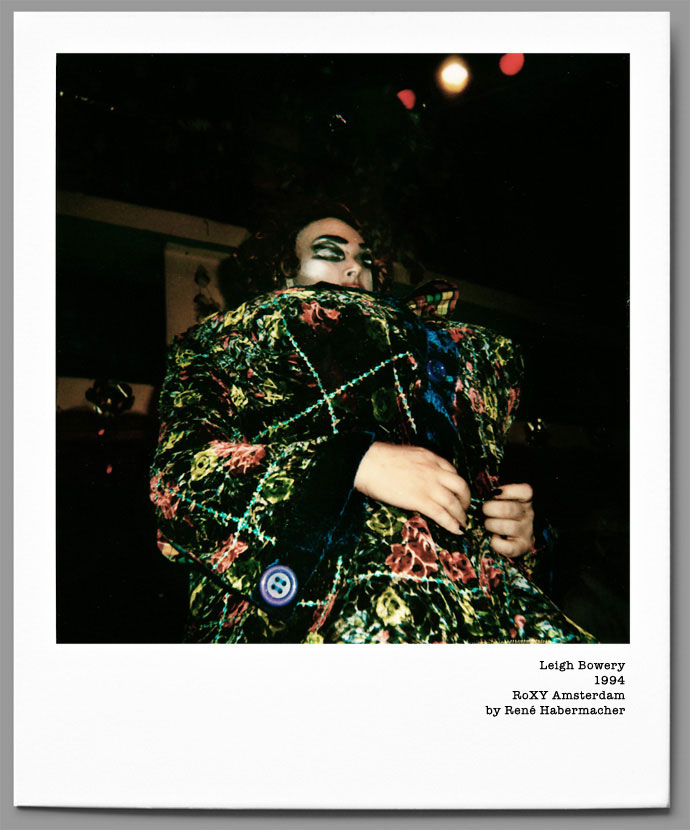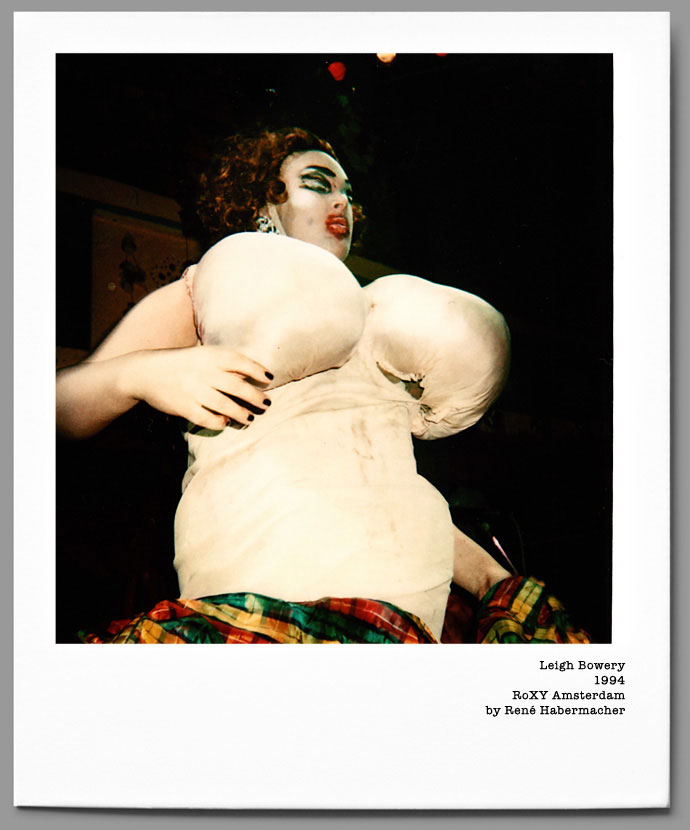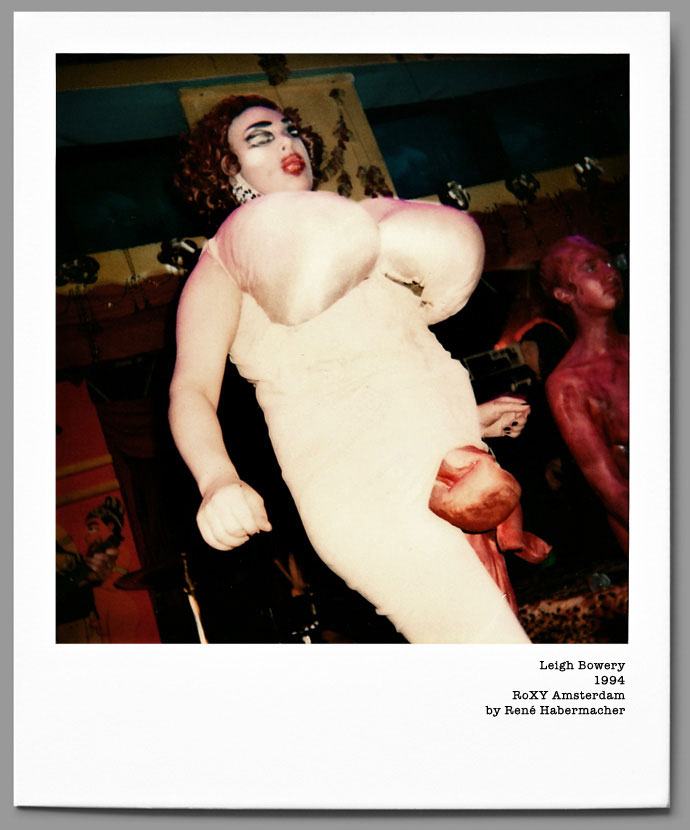-

#AllEyesOnHyeres2014: Meet the 10 Competing Designers
-In preparation for their meeting with the Design Jury, the 10 Competing Designers hurried around making last-minute adjustments and consulting with stylists, while The Stimuleye spent some time getting to know each candidate.
Herewith, a selection of video, photography, and text that offer brief introductions to each of these talented young designers.
All Photos by Filep Motwary
Marit Ilison
Who are you? Your age, your origin, your background, type of collection?
My name is Marit Ilison, I’m 29 years old and live and work in Tallinn, Estonia. I have a diploma in pattern making and I studied one year as an exchange student at Danish Design School before receiving my MA degree in Fashion Design from the Estonian Academy of Arts in 2008. Since then I have been working as a freelance artist and designer, creating in the fields of conceptual art, fashion, costume design, site-specific installations, perceptional experiences and exhibition design. I also teach and play drums in a psychedelic band.How would you describe Hyères in three words?
Palms, unreal, friendly.What has been your favorite part of the process so far?
Meeting like-minded people and collaborating with small local artisans in Tallinn. It is so wonderful how so many people have believed in my work and helped me to execute it.What is your collection about? Please explain your inspiration and starting point, and how it has evolved in the process.
Regardless of the discipline, my main goal is always to create memorable experiences and I always start from a feeling I want to create or an idea I want to express. Longing for Sleep is inspired by my haunting wish to sleep during the dark wintery time called kaamos. Kaamos is a word only know in Estonian and Finnish and it’s referring to the time from November to January when the days are very short and it barely gets light. On one side I would only like to stay in bed and daydream at that time, but on the other side I feel conscience pricking me, which reminds that I should actually be working instead of sleeping. To materialize the feeling I’ve created a collection using original vintage Soviet woolen blankets.In what ways you think participating in a Festival like Hyeres will help you in the future?
It is a truly unique chance to present my work to wider audience and get the spotlight on it. I am looking forward to meet like-minded people and find exciting future collaborations in fashion design, site-specific installations and experiences.Louis Gabriel Nouchi
Who are you? Your age, your origin, your background, type of collection?
My name is Louis Gabriel Nouchi. Im french, I’m 26 years old. I live in Brussels. I’m studying at La Cambre.How would you describe Hyères in three words?
Intense, exciting, sunny.What has been your favorite part of the process so far?
To see my clothes worn by a real model.What is your collection about? Please explain your inspiration and starting point, and how it has evolved in the process.
I’ve made a collection about the movie Princess Mononoke from Hayao Miyasaki and the notion of balance between opposite forces that have to live together in harmony.In what ways you think participating in a Festival like Hyeres will help you in the future?
I hope it will help me to meet professionals and create contacts for whatever is going to happen after school.Liselore Frowjin
Who are you? Your age, your origin, your background, type of collection?
My name is Liselore Frowijn, I am 22 years old and I come from the Netherlands. I graduated Cum Laude less then a year ago at ArtEZ Institute of the Arts in Arnhem, the Netherlands, on my bachelor fashion design. I designed a collection womenswear which is about the contrast between sportswear and luxury with the use of self designed fabrics.How would you describe Hyeres in three words?
I would describe Hyères as exciting, energetic, and a creative meltingpot.What has been your favorite part of the process so far?
Regarding to the festival I think my favorite part of the process so far is to meet all the other designers and creatives, being together in the villa and working hard to create a beautiful festival.What is your collection about? Your inspiration and starting point and how it has evolved in the process.
My collection ‘’Afternoon Of A Replicant’’ is about the clash between sportswear and luxury, which is based on the cut-outs of Matisse. By cutting and pasting with paper, I created cut out-suits for women of my time. Above these suits are pieces of artisanal fabrics with self-designed prints, hand-painted or embroidered. The silhouettes are voluminous and layered. The transparency of fabrics causes an eclectic play-a-long between background and foreground: a fresh kind of luxury is the result.In what ways you think participating in a Festival like Hyeres will help you in the future?
I hope that Hyeres will bring me the right connections to help my career a level up in the fashion industry. I would like to work as a fashion designer womenswear in a house in for example Milan or Paris to gain more experience. Later on, I would like to have my own brand. By being part of this Festival all ten finalist are really put on the radar, a lot of people will notify our work, which can be very helpful.Agnese Narnicka
Who are you? Your age, your origin, your background, type of collection?
My name is Agnese Narnicka, I am from Latvia, Riga city. I received an M.A. from the Art Academy of Latvia in 2009. I have enriched my knowledge and experience in Accademia di Belle Arti di Brera, Italy, Milano. After graduating I started to work on my own label One Wolf. I will present menswear collection “Repair man.” Collection has urban shapes and multi layered look.How would you describe Hyeres in three words?
Bloom, Team, FutureWhat has been your favorite part of the process so far?
My speech rehearsal :}What is your collection about? Your inspiration and starting point and how it has evolved in the procedure.
The Inspiration for collection “Repair man” comes from my personal experience in 2012 when I was doing repair-works in my apartment. During this period I met several craftsmen whose personalities influenced the making of collection and are reflected in its characters. By taking off the old paint, by coating walls, painting, grinding and applying tiles I discovered many textures, colours and combinations of different materials.In what ways you think participating in a Festival like Hyeres will help you in the future?
The Hyères festival provides an opportunity to show my creations to a wider audience and to get new contacts. I really appreciate this opportunity!Coralie Marabelle
Who are you? Your age, your origin, your background, type of collection?
My name is Coralie Marabelle, I am French and I am from Paris. I am presenting a womenswear collection for the Hyères Festival.How would you describe Hyeres in three words?
Exciting, surprising, promising.What has been your favorite part of the process so far?
So far i have really enjoy discovering the Villa Noailles. It’s an amazing place full of history. I feel super excited to work in this place where so many amazing artists have come before.What is your collection about? Your inspiration and starting point and how it has evolved in the process.
My collection is inspired from a picture of persian sheep shearers in 1952. Inspired by a very masculine outfit, I dreamt of a very feminine woman.In what ways you think participating in a Festival like Hyères will help you in the future?
I think the Hyères festival gives us a lot of visibility which is amazing. It also give us the opportunity to meet a lot of people from the fashion industry.Anne Kluytenaar
Who are you? Your age, your origin, your background, type of collection?
My name is Anne Kluytenaar, I am 27 years old and I am from the Netherlands. My collection is menswear.How would you describe Hyères in three words?
Inspiring, exceptional, fun!What has been your favorite part of the process so far?
My favourite part so far was making the fabrics and creating embroidery.What is your collection about? Please explain your inspiration and starting point, and how it has evolved in the process.
I was inspired for my concept when my father told me one evening that he would continue to live life as a woman. She was not aware of the physical difference between women and men and would wear all the volume on the shoulders and wear a slim pencil skirt with it which augmented her masculine shape. To me the house of Chanel is a perfect example of luxurious elegance with a clear silhouette. Also their rich fabric and details were very inspiring.In what ways you think participating in a Festival like Hyeres will help you in the future?
It has opened me up to broader possibilities in the international fashion scene, allowing me to showcase my work to a wide audience and connect with industry professionals as well as like minded designers.Roshi Porkar
Who are you? Your age, your origin, your background, type of collection?
Roshi Porkar, 25, Vienna, women’s wear.What is your collection about? Please explain your inspiration and starting point, and how it has evolved in the process.
Feminine, fancy. fancy. The theme of the collection is based on a series of little statutes of stone, known as the Bactrian Princesses. I worked around the woman’s body, exaggerating the conventionally desired form for a woman’s body.
How would you describe Hyères in three words?
Exciting, emotional, exhausting.What has been your favorite part of the process so far?
Getting to know all the talented contestants and the jury members.In what ways you think participating in a Festival like Hyeres will help you in the future?
I just hope to be busy for the next few years.Pablo Henrard
Who are you? Your age, your origin, your background, type of collection?
My name is Pablo Henrad, I’m belgian and I just finished studying at La Cambre. I am presenting a menswear collection called Maelstrom.How would you describe Hyeres in three words?
Exciting, exhausting, and crazy.What has been your favorite part of the process so far?
To meet and to get to know all the contestants.What is your collection about? Your inspiration and starting point and how it has evolved in the process.
I worked on the darkness and the mystery of the untouched oceanic abyss. I questioned the notion of elegance, sensuality and sophistication in the masculine wardrobe.In what ways you think participating in a Festival like Hyères will help you in the future?
It surely helps because of all the interesting people we met here, the new connections and all the professionals.Kenta Matsushige
Who are you? Your age, your origin, your background, type of collection?
My name is Kenta Matsushige, I’m 25 years old, I’m from Yamaguchi in Japan. I studied fashion 2 years in Osaka and 2 years in Paris. Now I working as a freelance designer and modelist (pattern maker) in Paris. My collection is a womenswear collection.How would you describe Hyères in three words?
Nature, meeting people, collaborations.What has been your favorite part of the process so far?
All the process is really important for me, to create my own universe and work on volumes, fabrics, and find technical details or construction.What is your collection about? Your inspiration and starting point and how it has evolved in the process?
My collection was inspired by minimal structure, nature serenity, and traditional elements. I tried to find a balance between their confrontations.In what ways you think participating in a Festival like Hyères will help you in the future?
Hyeres gives me opportunities to collaborate with professionals and meet people who understand me and help me to create my universe. It will help me to create my own brand in the future.
Yulia Yefimtchuk
00 -

#AllEyesOnHyeres: Humberto Leon and Carol Lim of KENZO, presidents of the fashion jury
-American designers Humberto Leon and Carol Lim surged into the global spotlight in 2002, as the co-founders of New York City’s preeminent boutique, Opening Ceremony. With its keenly curated selection of luxury brands, the shop quickly attracted the attention of the fashion world at large, and in July 2011, Leon and Lim were appointed as the creative directors of Parisian label KENZO.
Humberto Leon and Carol Lim, by Filep Motwary.
The strong friendship shared by this creative duo dates back to their years at UC Berkeley in California, where they met as students in early 2000. After a decade of successful project launches and hotly anticipated collaborations with other labels and designers, they continue to challenge fashion habits and to conceive new methods of design.
Today, both are enthralled by the KENZO spirit, which they perceive as a lifestyle all its own, and the label is shaped by the singular creativity born of their partnership. The originality and diversity of patterns and prints, the bright colours, music and rhythms of disparate cultures from around the world are all inspirations behind KENZO’s revival: under the guidance of Leon and Lim, it strives to achieve a universality which will seduce men and women of all ages.
Fashion has been a catalyst and playground for socio-cultural movements. Today’s trends are tracked from street to runway and back again at such speed that subcultures can barely exist beyond the brands. In what way do you feel today’s fashion is relevant?
Fashion has and always will be one of the easiest ways people can express themselves. We love drawing inspiration from everything around us: culture, art, music, food, travel, and from seeing what people are wearing on the streets. Today’s fashion, the product of a more connected world, is extremely relevant for what KENZO stands for today. That connectivity is what brings people together: streetwear melding with tailoring, night and day, comfort and style. All of these elements and more make fashion right now an extremely exciting place to be.
Do you think that something originally pegged as a luxury fashion brand could evolve into something that ends up being a mainstream feature? Is it a good thing being mainstream or not?
What some people seem to forget is that KENZO as a brand was never intended to be “luxury.” Kenzo Takada, when he founded the brand, dreamt of creating collections accessible to the street. We feel that mainstream isn’t a negative word and that mainstream fashion can still be heavily design oriented. KENZO has always been democratic, and since joining the company in 2011, we wanted people to remember this. Mainstream usually means something collectively appreciated and that is something we like to celebrate. We would love for KENZO to be a household name around the world.
Carol Lim, by The Stimuleye.
Do you think it’s always advisable for designers to be very visible, seemingly available to and engaged with their audience? Should relatability, especially in this age of social media and hyper connectivity, always be a goal? How should a designer understand himself or herself in relation to the consumer?
It really depends on the brand. For us at KENZO we love engaging with the customer because that is where you see if your collections are something people will want to buy and wear. We want people to understand who we are as a company, and in order to do that, we have to understand who they are as clients. Social media gives us a direct link to our customers and we love being able to have a dialogue with them. They can ask questions, discover more about our world and become a part of the KENZO community.
Humberto Leon, by The Stimuleye.
You’re surrounded by collaborators coming from very different directions. For KENZO, how important is the idea of “family,” and the creative exchange with its members?
It’s super important for us. Both at KENZO and Opening Ceremony we work with our friends. It creates an open dialogue and brings out the best ideas. Working with collaborators such as Spike Jonze or Chloe Sevigny, people we have known for such a long time, is a joy. It’s important to love what you do, and what could be better than brainstorming or working on projects with people you admire and respect on both a personal and professional level?
Talent is an obvious thing to look for in a contestant, but what other qualities do you think will be important to look for in a designer, right now, in 2014?
We will look for a strong point of view as well as for someone who understands the importance of the whole process of design. It is important to be able to understand the business aspects as well as all the creative ones. Also, we will look for someone who has both drive and a sense of humility.
What is the last thing you saw, read, heard or felt that stimulated you?
Carol: Nausicaa and the Valley of the Wind, an animated film by Miyazaki.
Humberto: Seeing The XX perform an 40 person intimate show in New York.
NOTE: Interview questions were put together by this year’s Hyères Festival Blog Partners:
Malibongwe Tyilo, Filep Motwary, Branko Popovic, The Stimuleye, Sean Santiago, The Kinsky. -

#AllEyesOnHyeres: Steve Hiett, president of the photo jury
-Steve Hiett pursued a Masters Degree from the Royal College of Art Graphic Design before his Swinging London years, which saw him travelling the world as the lead guitarist of Britain’s psych/pop group The Pyramid.
But it was not until an unfortunate accident on stage deprived him temporarily of his Fender—namely, electrocution from an ungrounded microphone—that he turned back toward his roots in the visual arts, and picked up a camera. Initially documenting his own group while on tour, he was soon photographing the international rock scene at large.
Steve Hiett, by The Stimuleye.
Over the past four decades, Hiett has pioneered a signature style that has become instrumental to the global world of fashion photography. Favoringover-saturated images, off-centre framing, unconventional compositions, and dazzling flash work, his work has been featured regularly in renowned magazines worldwide—from Nova and Queen to British Vogue, Vogue Paris, Elle, and Marie Claire.
The Hyères festival 2014 will present the first major exhibition of Hiett’s oeuvre, emphasizing the unsung aspects of his images and re-establishing him as a figurehead in the history of contemporary photography.
Steve Hiett lives in Paris, where he continues to work as a photographer for renowned fashion publications (notably for Vogue Italy), as well as a musician, graphic designer, and art director.
What was the process behind selecting the images for your exhibition at Hyeres? What will the visitors see?
Steve Hiett: Raphaëlle Stopin came to my place and looked through everything I could find. She selected the images.
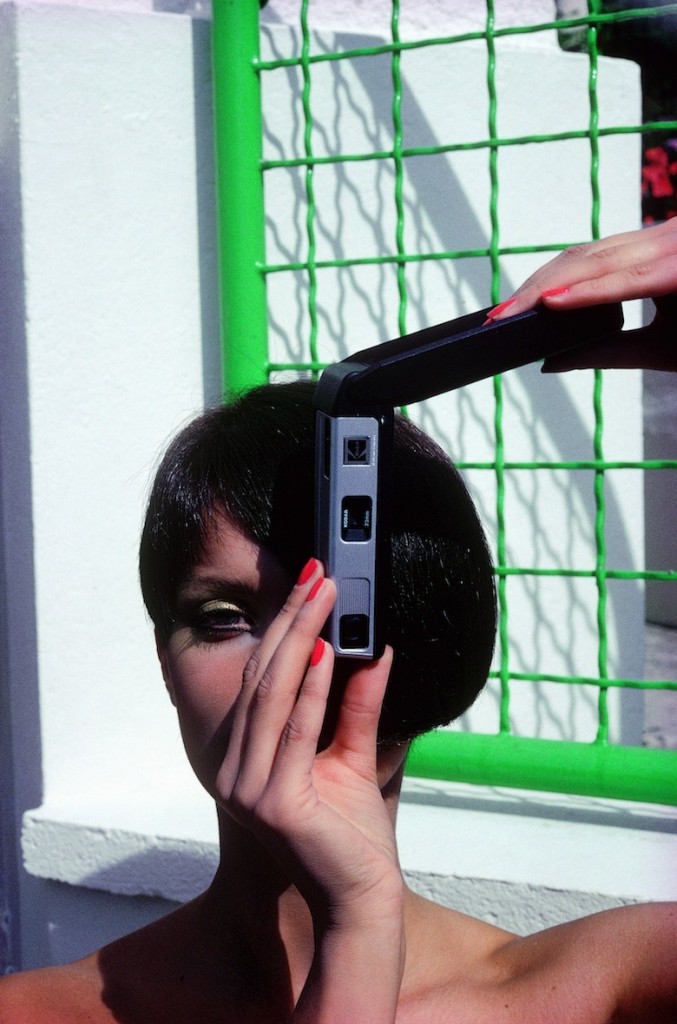
Steve Hiett, Vogue, 1979.
You didn’t plan to become a photographer, and it seems that your early photography was informed by your circumstances while you were on tour. Considering how digital and technological developments throughout media have changed the landscape of photography, what kind of career path do you think you would find yourself upon if you were only beginning your career in the present day? How would a young Steve Hiett go about his business in 2014?
SH: Starting today? I have no idea. Fashion photography is such a complex thing now; lots of politics and all the digital processes, which makes doing a photo so long and complicated. When I started, you just walked into a magazine and the art director would give you a job. I don’t think you can do that now. Also, to take a photo, you took a light reading, pressed the button and that was it; what you got back from the lab was it—end of story. Now you are dealing with all sorts of choices and the new world of retouching, which can go on for days. I worked for 30 years and never retouched anything. It never entered my head (or any other fashion photographer) as even a possibility.
Steve Hiett, 1979.
Looking back over your career as fashion photographer, is there a certain period in time that stands out for you in particular?
SH:Starting. I knew nothing, but it didn’t matter.
Having worked through the last few decades of fashion photography, what kinds of major aesthetic shifts have you noticed?
SH: Now the boss is the fashion editor. They decide who works and who doesn’t, but before it was the art director.
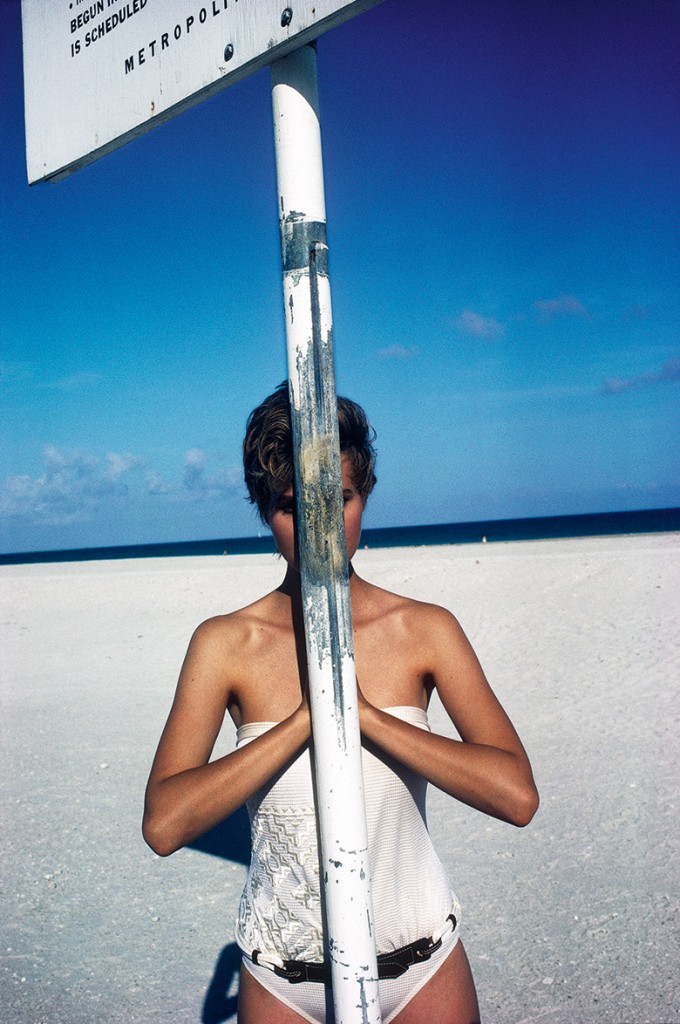
Steve Hiett, 1979.
There is always some sort of tension in your photography. How do you achieve it?
SH: Tension in my pictures? That must be subconscious: I never look for tension. I look for the right feeling.
What is the last thing that stimulated you?
SH:The last thing that stimulated me? Steve Cropper’s guitar solo on “Green Onions,” which I have listened to 1000 times. I listened to it again last night; still has that magic. OK, I know the notes he plays, but it goes way beyond that—it’s a magic thing.
NOTE: Interview questions were put together by this year’s Hyères Festival Blog Partners:
Malibongwe Tyilo, Filep Motwary, Branko Popovic, The Stimuleye, Sean Santiago, The Kinsky. -

Merry Xmas, Mister Sakamoto.
-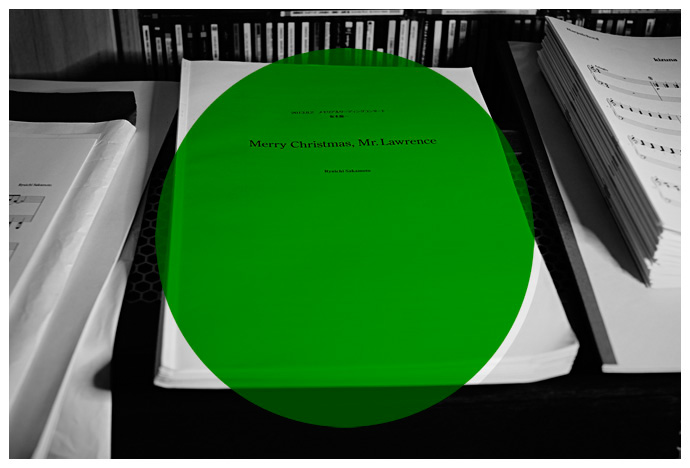 Manuscript to the score of "Furyo" by Ryuichi Sakamoto. Photography René Habermacher.
Manuscript to the score of "Furyo" by Ryuichi Sakamoto. Photography René Habermacher.It doesn’t quite add up.
There are the many facets of Ryuichi Sakamoto, but putting them together, you still wouldn’t get a sense of who the man is.
He is both an icon of Japan’s 1980’s Bubble Era, and the one who moved beyond Japan and away from the spotlight, a consistent experimentalist and accidental sex-symbol.
Founding member of the influential band Yellow Magic Orchestra, Japan’s answer to Kraftwerk.
Musical innovator for over 30 years, mixing synthpop, Okinawan traditions, sampling, bossa nova….
Screen-mate of David Bowie in the cult film “Merry Christmas, Mr. Lawrence” / “Furyo.”
Film composer for Almodovar, Oshima, Bertolucci, Oliver Stone and Brian de Palma.
Collaborating with David Byrne, Brian Wilson, Youssou N’Dour and the Dalai Lama.
Appearing in Madonna’s “Rain” music video.
Sampled by Afrika Bambaataa…and Mariah Carey.And last but not least, well before the Fukushima accident, a prominent activist in Japan’s anti-nuclear effort.
It doesn’t quite add up, and that’s really for the best, as we found out after spending an afternoon with him in New York City
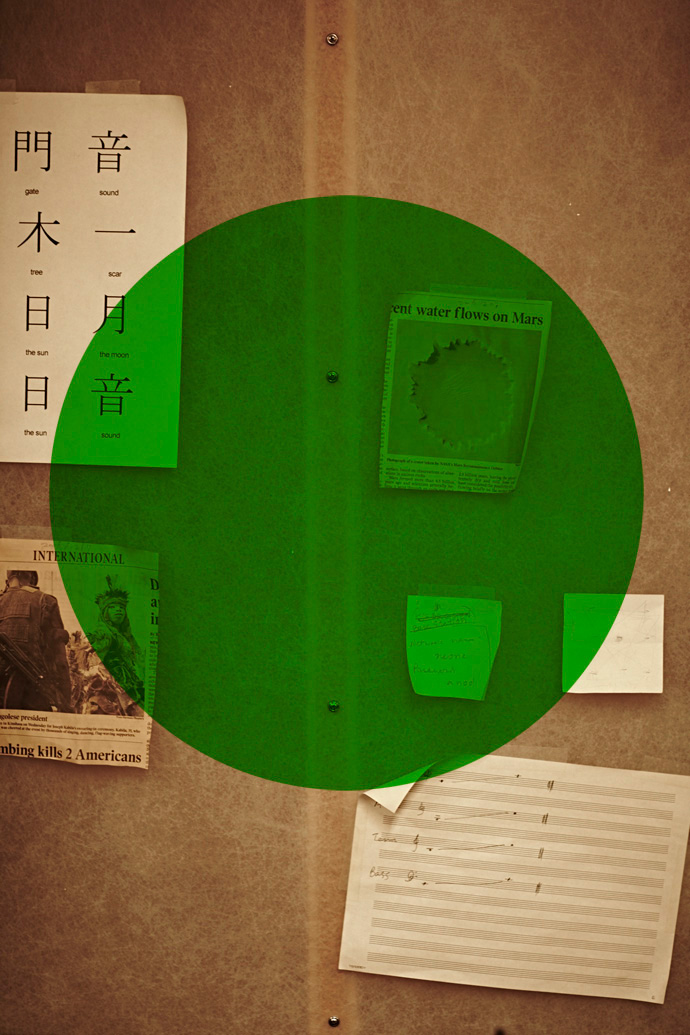
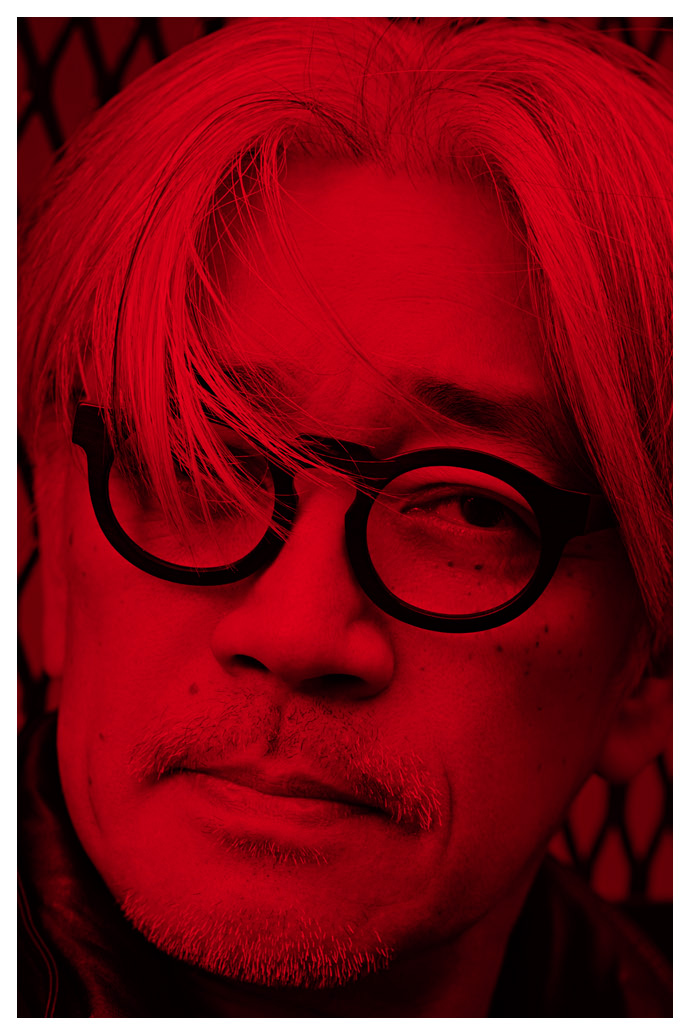 Left: inspiration board. Right: Ryuichi Sakamoto. Photography by René Habermacher.
Left: inspiration board. Right: Ryuichi Sakamoto. Photography by René Habermacher.The Stimuleye: When did you first feel personally concerned with the nuclear issue?
Ryuchi Sakamoto: Probably I started feeling anxious about it around the time of Chernobyl. Then I encountered the facts about the nuclear reprocessing plant in the northern part of Japan called Rokkasho. It was 7 years ago, pretty recent.
It’s not a usual nuclear plant, it’s to re-use, re-process used radioactive wastes. Through the processing, you emit hundreds of time more radioactive materials than the usual nuclear plant does. You get 365 nuclear plants in 1 village. Very dangerous.
So I started a web campaign, called Stop Rokkasho, I asked Kraftwerk to give us a sound logo, and they did actually ! The pretty famous graphic designer Jonathan Barnbrook had his assistant design the webpage, which was very neat.
As a web campaign it succeeded, my friends – photographers, musicians, stylists, creative people got to know about this plant. We decided to make a Stop Rokkasho tshirt, we asked more than 50 designers to make a tshirt. They needed phrases, so I gave them “No Nukes. More Trees.”
Everybody loved it, especially the second line.
It’s very easy to understand, and no one can resist.So, I decided to form a company called “More Trees”, it’s been 6 years, and we’ve been doing mainly conservation of Japanese forests. We have now 11 forests in Japan and 1 in Philippines.
(more…) -

MULATU ASTATKE: the bushes vs Debussy
-It may have taken decades, but the Ethio-Jazz sounds of Mulatu Astatke are now traveling throughout the world, through Kanye West samples and Jim Jarmusch films, reaching unlikely destinations such as the ecstatic crowds of Calvi On The Rocks in Corsica.
‘Doctor’ Mulatu Astatke as he likes to remind us, is not only a jazzman, but a doctor in musicology, who is eager to add to the lists of achievements of his home country, Ethiopia: coffee, inspiration to the Rastafarian faith, the invention of the musical scale, and it would seem, music conducting.
The bushes. Debussy. In the the mouth of Mulatu Astatke, it’s hard to hear the difference between the two.
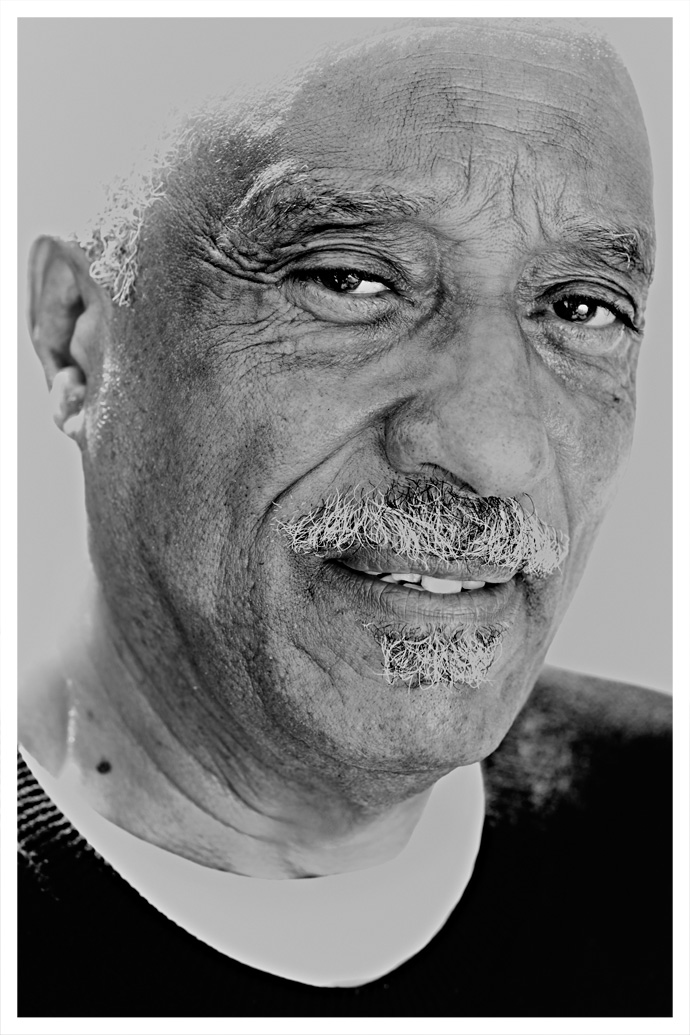
Doctor Mulatu Astatke, "Father of Ethio-Jazz" as his business Card states. Calvi 2013. Photography by René Habermacher.
René Habermacher: How did you come to be part of this festival that is very electronic music related?
Mulatu Astatke: Well, you know, I’ve travelled to Europe a lot in the last 3-4 years. The band became very popular, very busy and we did also a completely beautiful cd which will be coming out in October for the Jazz Village. People seem to ask for my band everywhere.
I used to be involved with electronic music a few years back with Heliocentrics on the album “Inspiration Information” (2009). But I really love acoustic sounds very much: real sounds, real music, everything. It’s good for the people to be able to get both sides, they can hear the acoustic but also the electronic music. I think it’s a very good idea to bring me to this type of festival. It’s great.
RH: How do you feel about the younger generation of pop musicians referring to your sound or even sampling, as in the case of Kanye West and other heavyweights of the contemporary pop generation?
MA: I remember the film “The Broken Flowers” by Jim Jarmusch, with Sharon Stone and Bill Murray. (NB- The soundtrack to the film features an eclectic mix of music, chiefly using instrumentals by Mulatu Astatke as the main score mixed with garage rock, metal and reggae.) The film really made a push and brought different crowds to my audience.
Then people started sampling my music. So my audience keeps on growing. I love it, I have no objection to sampling my music, because every time they sample, the crowds come too.I see all kind of people in London, in Paris, in Australia, everywhere, middle-aged, young, old ages, all kinds of crowd. It helps Ethio-jazz, and also for people to see different directions of music. So it helps so much. I enjoy it. Its beautiful.
Mulatu with drum sticks shortly before going on stage. The composer’s own signature instrument is the vibraphone, a set of graduated aluminum percussion bars that resemble a marimba or a xylophone. Photography by René Habermacher
RH: Ethiopian culture pioneered a lot of different things in music. Your work is part of that tradition.
Do you think because you were so pioneering it took quite some time for the deserved recognition to come in?MA: I put myself as an example and always say: never give up, just keep on pushing!
It’s so great when reality reaches what I always dreamed for this music to reach. If you just get to this point… it took me around 43 years!
The thing which takes time always give great results. It is what it is: as a musician you come to Paris, play Ethio-jazz, you go to NYC, to Germany, Denmark, Sweden, England: playing Ethio jazz.
And then suddenly this music just develops. Its a great recognition.I got my PhD from Berklee (NB – Boston, USA) and lectured in different universities all the time. It’s a great achievement for Ethio-jazz to be accepted at Berklee, a recognition of what we have given to the development of modern music, to dance and everything to the world. So I said: it’s not only for Mulatu, but this is a recognition of Africa, which is so great. So this is what we fight for.
Now I also do a lot of research at Harvard, at MIT and also lecturing for National Geography last month at the Royal Albert hall in London about Ethiopian contribution to culture and music.
I talk about African achievements and what it has given to the worldRH: So the theoretical reflection is very important for you.
MA: Very much! If you don’t know the historical aspect and the contribution of your country’s music, you can’t go any further.
The more you know, the more you do research, the more you enjoy.And the more you can develop the music and show to the world your own contribution.
So research is very important. For example in Ethiopia I go to the rural areas, to the bushes.
There’s one tribe, the Dirashe, who plays a diminishing scale in the middle of a pentatonic five tone scale country like Ethiopia.
In Ethiopia we play only five notes, that’s how Ethio-jazz developed: five notes against the twelve tone scale of American Jazz, you know what I mean. When I studied at Berklee, they were teaching us how Charlie Parker created the modern jazz through diminished scale. But this tribe plays a diminished scale. And great composers like Debussy are on a diminished scale. So what is really very interesting is these tribes have been there for centuries and centuries, so what I want to know is: is it Charlie Parker, was it Debussy, or this tribe ?Who was first? This is the question. These tribes people knew nothing, no painting, nothing, and they play diminished scale. I don’t know how they got it, because they are in the middle of a five note country. How did they manage to get this?
So I raised this question at Berklee and they were so surprised. What they said is: “Oh Mulatu- you got us!”
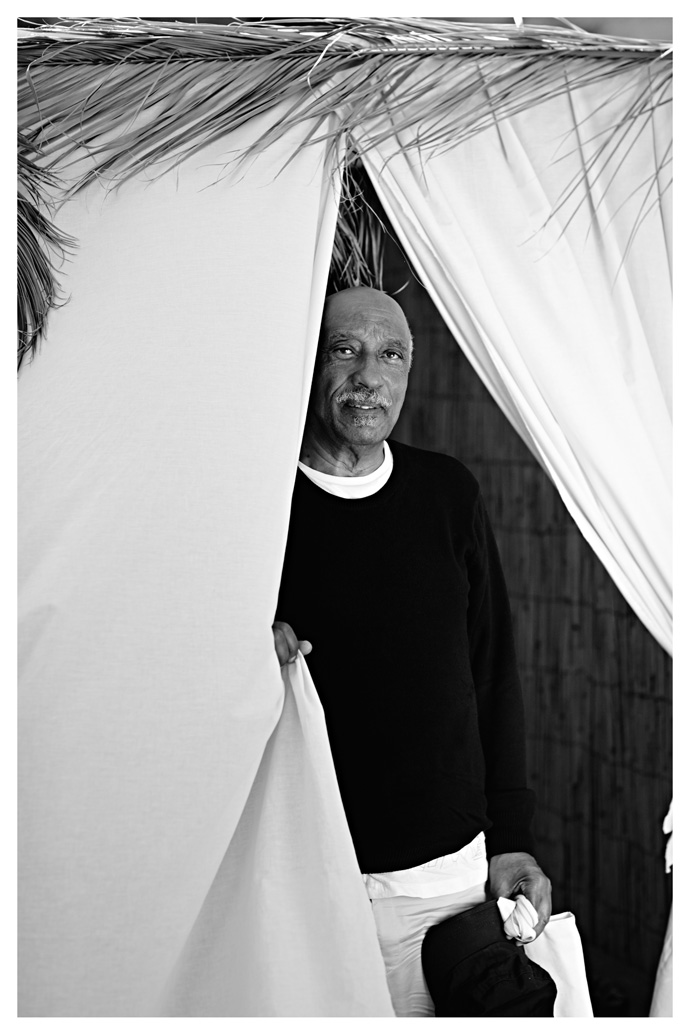 Mulatu Astatke received late recognition: Originally supposed to become an aeronautical engineer he was
the first African student in the late 1950s at Berklee College of Music — “the only place in that time,”
he said, to study jazz. Photography by René Habermacher.
Mulatu Astatke received late recognition: Originally supposed to become an aeronautical engineer he was
the first African student in the late 1950s at Berklee College of Music — “the only place in that time,”
he said, to study jazz. Photography by René Habermacher.RH: Is there a point where you thought the recognition is starting to come?
where you though somebody starts to understand what you were trying to do with Ethio-jazz?MA: In Europe and America, they understand and love my composition all the same. But when I went back from NY to Ethiopia, they didn’t like it at all, because they were used to this musical form that we call the current form: malalala…dalala (sings) I remember a long time ago there was a town that told me to get off stage. It was too complicated to them. They could not understand: “is this a joke or what is it?” Playing around: wabadawadawa?” – they don’t dig it. So I finished the piece and went off.
But now, after 10-15, 20 years they go crazy. The whole town of Addis is Ethio-jazz now.
Finally it’s Ethiopians! So I always say: keep on fighting, never stop. That’s the result.RH: When you worked with those tribes on interpretations, did they have any rejection?
MA: No. You know, I don’t touch them. I just work behind whatever is going on. I can write beautiful counterpoints and harmonies and they do their thing. I just tell them how good they are. What they’ve done to modern music, their contribution to the world. So they love it.
I do a lot of experimental work with this people. I do beautiful jazz fusions with them.
(NB- Mulatu once brought musicians from four different tribes together in an Addis Ababa television studio and orchestrated a cross-tribal fusion performance. This giving traditional musicians, many of them farmers, an artistic exposure beyond their tribes)
The ideal way to explore multiple forms of music is through jazz.
In fact there is a Dirashe track is on my new album, and another one with the Surma tribe.
It’s so interesting, I did an experiment with Fatou (NB- Fatoumata Diawara), the Malian singer who is featured in one song,
a fusion of their music with Ethiopian: east meet west. It’s so beautiful, its on my new album called “Sketches of Ethiopia”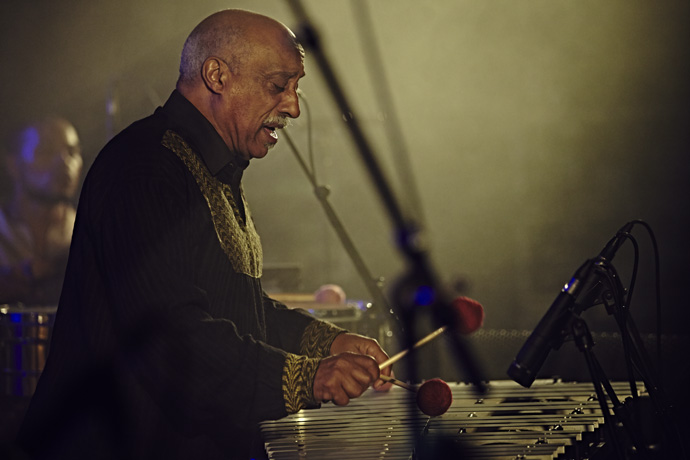
Mulatu in action at Calvi On The Rocks, Corsica 2013. Photography by René Habermacher
RH: Another culture that strongly relates to Ethiopian heritage is the reggae culture, yet in a very different way.
How is your relationship to this?MA: I really respect them for introducing the Ethiopian, the flags and their love to Ethiopia.
But even though musically we’re in different modes, different scales, different things. When you hear Bob (Marley) and the other ones they use mostly their own stuff.
So actually its not like Ethiopian culture or Ethiopian music, but this is their own way of appreciating music. I like them for promoting our country, for promoting our flag in this world, and for it to become like part of national art. We enjoy them, we love them so much! And now, you see they are adding a lot of Ethiopian modes, Ethiopian scales to reggae currently. There are rastas living in Ethiopia in a place called Shashamane.
Hailee Selassie gave them the land in 1948, so they stay there. And now they start to come into our music: Ethio reggae you know.
But now there are more young Ethiopian musicians, they do a lot of reggae. It’s great I think.RH: In 2008 you premiered a portion of the Saint Yared opera at Harvard.
Are you continuing on that project?(NB- The Saint Yared Opera is a project on Saint Yared who is regarded as a saint of the Ethiopian Orthodox Church and credited founder of the Ethiopian Coptic Church Music. He is believed to have been the first to write musical notes, centuries ahead of Western civilisation, and use an ancient form of conducting stick. The composition of the opera will blend the old and the new, and incorporate traditional chant texts in Ge’ez, the Ethiopian liturgical language, but as well electronic elements)
MA: Oh yeah. Thats very interesting. It’s gona be completed very soon. It’s already done actually.
The problem is that l am so busy travelling with other projects: I write for films, I do my experimental works.
I need two to three months to finally put the opera on a stage.This is a work I’ve done at Harvard.
My paper was about conducting being an Ethiopian contribution to the world.
We used to conduct music in the 6th century, with a stick called a mekwamia.Mulatu at Calvi On The Rocks, Corsica 2013. Photography by René Habermacher
So I studied the movement. If you look at the military band march, and the man in front waving sticks and things — 80-90% of that movement is from the mekwamia in Ethiopia.
But where did they get this from? This was before existence of symphony or conducting a symphony — and we have it. If you look inside the Encyclopedia, were there symphony orchestrae in the 6th century? There weren’t.So I said “OK, there were no symphonies, so then the conducting movement is taken from us.” Of course there were a lot of conducting, there were choirs in Europe of all kind.
But the most of the movement is what they use for the military also. If you use in the symphony a stick like this, the way you move it is exactly the same how we move it.
So they are telling us “you can do your reggae, you can do your jazz, you can do your rap.”
But they say classic music is purely European culture, which Africa has nothing to do with.
They are musicologists for Harvard, Yale, Princeton – so I said:
“look, I am open minded. This is what I found. If i am wrong, tell me, I am learning from you.”They couldn’t answer me.
So I say: “one for Ethiopia”. They said: “we’ll see.”[In the opera] there are two great conductors in the symphony, one european with a bow tie, conducting the symphony behind, and a church guy that conducts the choirs.
My dream is to do it in Lalibela (NB- one of Ethiopia’s holiest cities, famous for its monolithic rock-cut churches), the cave.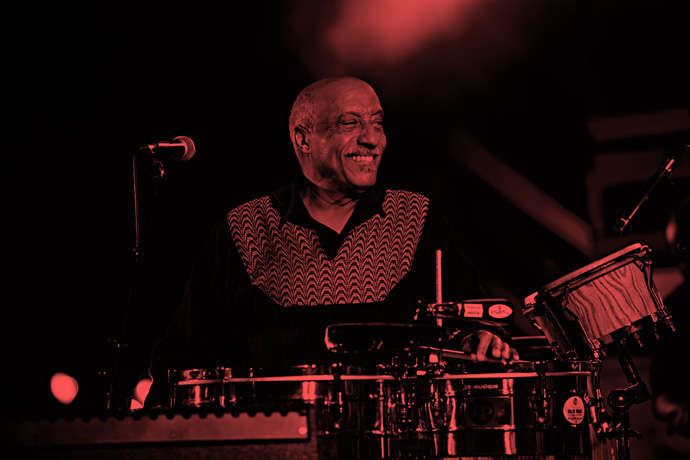
Mulatu at Calvi On The Rocks, Corsica 2013. In the late 1960s he had returned to Ethiopia with the first Hammond Organ and Vibraphones. Photography by René Habermacher
RH: What is the last thing that stimulated you?
MA: That’s really these people in the bushes. They inspire me so much. I have very great respect for them. The more you go closer to them the more you find them so interesting. They have created so many great musical instruments.
Now there are instruments in the bushes they sound like trumpets but made from bamboo. Strings, sound like violins, cellos, that kind of thing.
So I was wondering, let’s do a research – who inspired who ?
When you see these people never had a chance to go anywhere, they have no television, they have no radio, – they have nothing.So I always think they inspire the developing world. Those are the people that inspire me. The more you go everyday, you learn something.
New ideas, something interesting from those people. They inspire me.We call them backwards. But they’re not backwards people to me, they are advanced people.
They are ahead. So this this is my life now. I listen to them.
Whenever I have the chance I am in the bushes, I go close to them.
It’s so interesting, so beautiful. That is what inspires me truly.
Upcoming concert dates:
AUGUST 10 – Paris, Trianon -

undercover (and inside out)
-Japanese designer Jun Takahashi, the creative force behind the cult label Undercover has been a major influence in Japan’s fashion scene for more than a decade.
After vanishing for two years from the Parisian catwalk, he returned with a vengeance and presented his new collection to an audience that awaited his return, with mix of patience and restlessness.
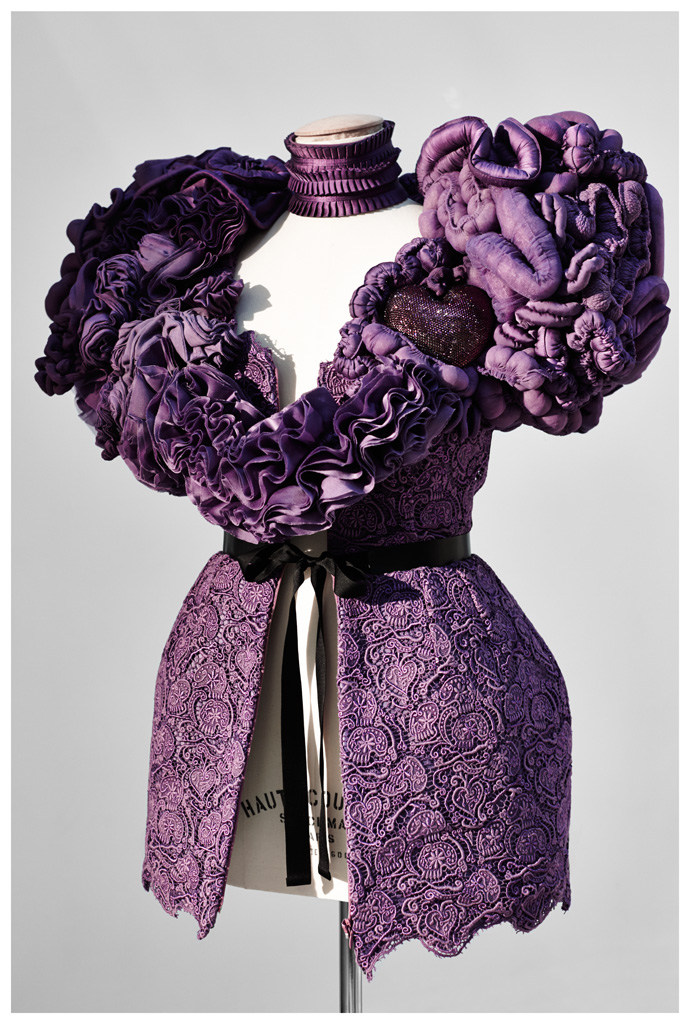
Inside out: Undercover dress with entrails, bone and skull lace, a heart on the right spot for the scary cute. Photo by René Habermacher.
The show at the intimate venue of the Institute Pasteur started with much delay, yet the undercover flock of disciples, among them the devoted Grace Coddington, awaited patiently what was to come from behind the antique glass-panelled doors: scary kittens with bunny masks on ponytailed shoes, wearing their insides out, ribcages and organs on outer display. Skeletal hands grasping waist lines, vintage lingerie elaborately piled-on to sleeveless evening jackets. Little dresses with what seemed to be ruffles at first glance, turned to be a romantic interpretation of entrails slung around the décolleté and a sparkling crystal studded heart.
Surprising,- or in the case of Jun Takahashi actually not- the arch from the drama of the unique pieces to the extremely wearable parts of the collection: googly eyes on a waxed trench coat, or the return of Undercover’s signature pieces, the perfecto, and the trench, with double collar and worn as a dress.
This is where the strength of Jun’s subversive vision lays: there is no friction between the everyday pieces and the elaborate constructed parts of his universe. Seamlessly he migrates between outfitter to the urban hipster to action art performer creating his giant Grace dolls from vintage plush toys in front of a bedazzled audience. The Graces, creatures from outer space were originally created for the presentation of the Undercover collection SS09 became somewhat of the labels mascot.
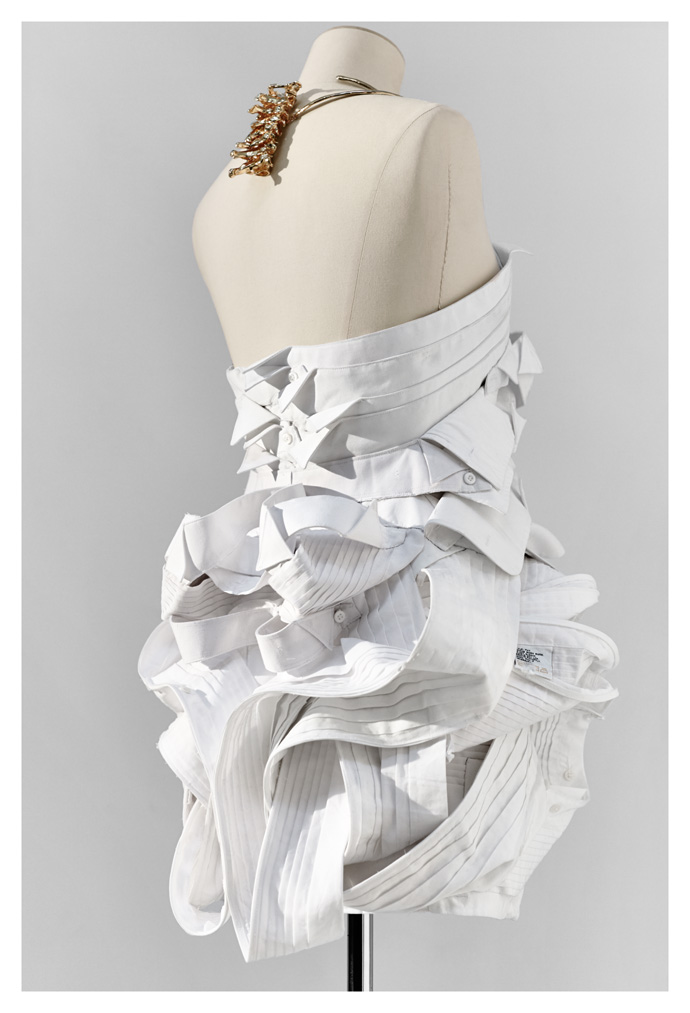
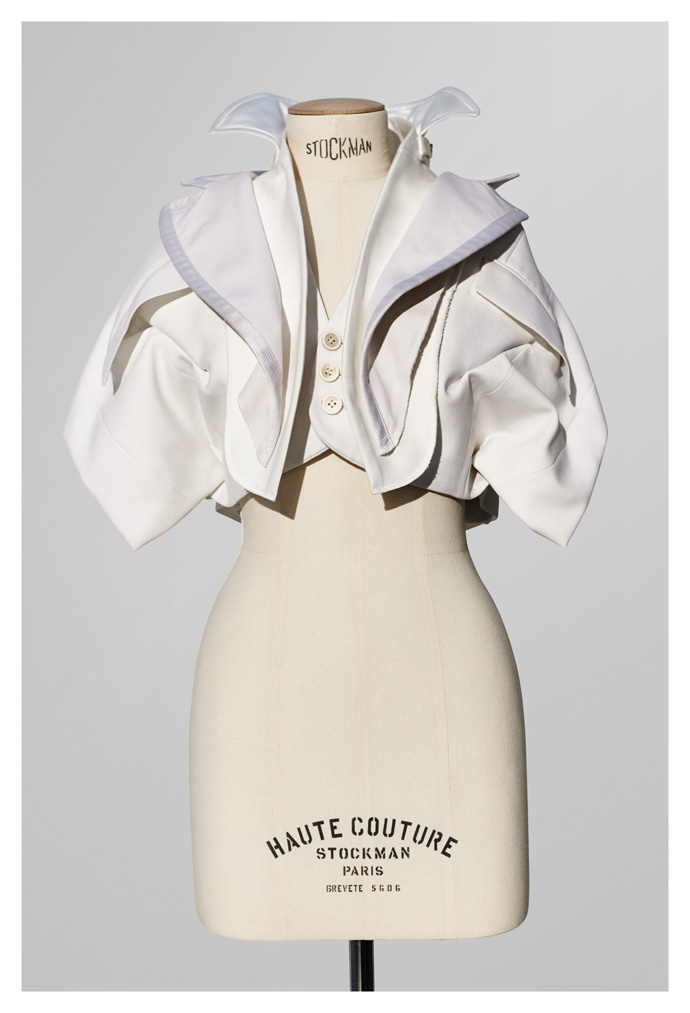
Starch undercover: special pieces made from deconstructed men's white shirt collars. Photo by René Habermacher.
René Habermacher: How is it to be back in Paris?
Jun Takahashi: It’s very exciting! Its been two years since we had the last show, so I am so happy!
You received well deserved great critics for this show of return.
how did you start with this collection, and how did it evolve and what is the narration?Last season when we came back to paris having just the showroom, I made seven special crafted pieces. It’s been a while since I’ve made such a creation and enjoyed it a lot.
It was just for the showroom, but this season i wanted to present a collection on the runway to show it to a broader audience. That’s how I started this collection.
The theme of the collection is about internal organs and bones, showing something from the inside exposed to the outside. Like lingerie that is usually hidden underneath, I used to make dresses and so expose them to the outside. That’s kind of the theme of the collection.Why did you decide at this moment to take the inside to outside?
I don’t know why (laughs). It’s been a while I wanted to show the “inside”. This is very undercover. It’s easy to express “Undercover”.
The motifs of organs and bones have something grotesque and scary in peoples minds. I take this and make it cute. It’s about both sides: not just scary, not just cute. we have both sides in the brand.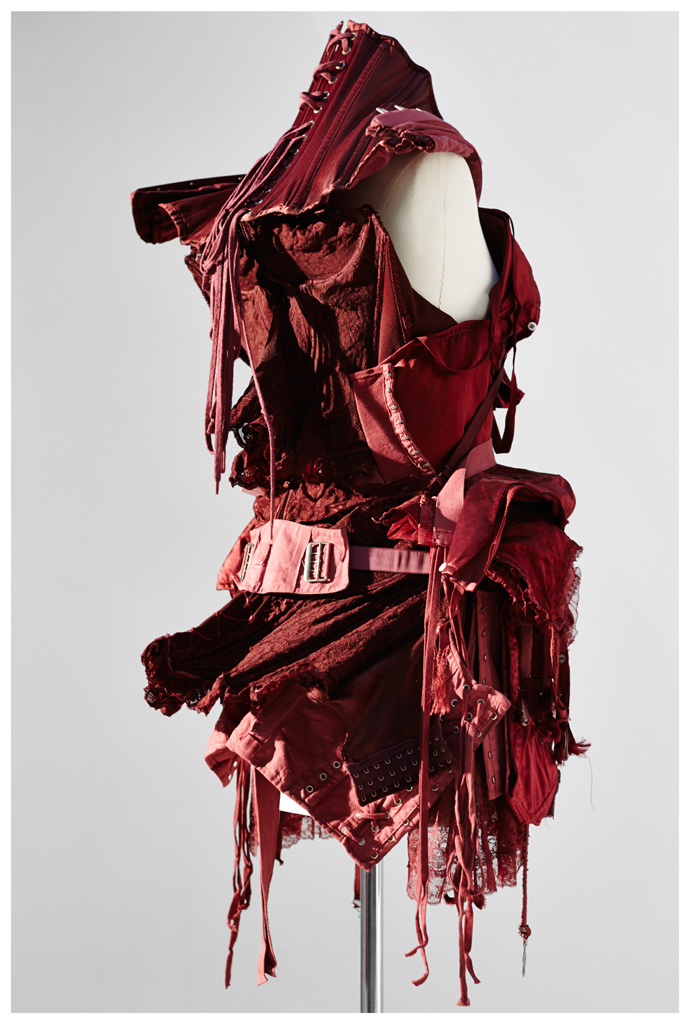
Pile-on vintage lingerie evening jacket. Photo by René Habermacher.
Are you a story teller?
(laughs) To me show is one big story, one drama, one stage. In a way I am not just making clothes, but one big tale, a story.
Since I was little I preferred the scary stories. I like Hitchcock movies. I am not necessarily into the ghostly but prefer the mental story.Another aspect is a strong sense of subculture evident in your work.
It is very different today then when you started off. What is subculture for you today?Most of he people surrounding me in Tokyo come from subculture, its a normal thing for me – its music, movies etc. not the mainstream. People in subculture are not specifically specialized in something – they don’t have mass-apeal. I like that. I source from this and then present my version in the “mass-area” like Paris.
Do you think exposure is dangerous for subculture?
The dark side of sub-culture! (laughs)
I take this positive. We always want to have information very quick- and I find this bloggers taking snapshots in the street very interesting, it’s really like I use the internet. How quick they are, it’s impossible for the print to catch up. Myself I like to post on Facebook and use the internet as a communication tool.Is the “season” still relevant to you?
When I design i don’t really think of the season. But when it comes to selling, we have to take this into consideration. For example in Japan we start selling FW collection in July, which is very difficult to sell Winter clothes because its still very hot for another 3 months until October. So we have to think about the balance between the creation and the business. So that’s difficult. We cannot completely ignore the seasons but not only thinking about seasons.
The runway shows’ timing are getting earlier and earlier and it takes time to actually get in the store.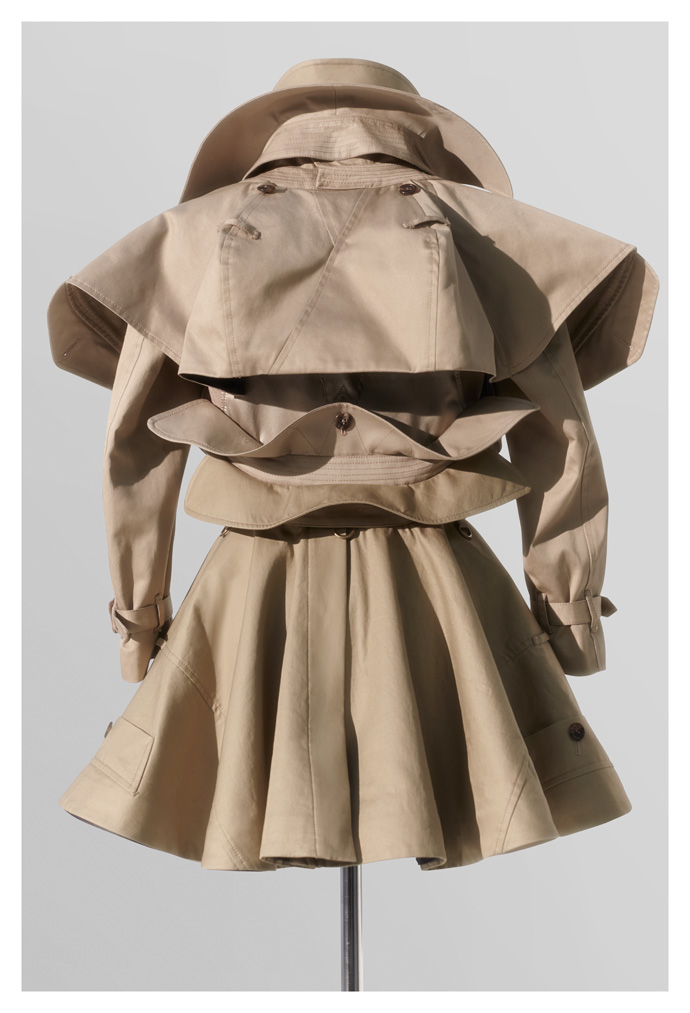
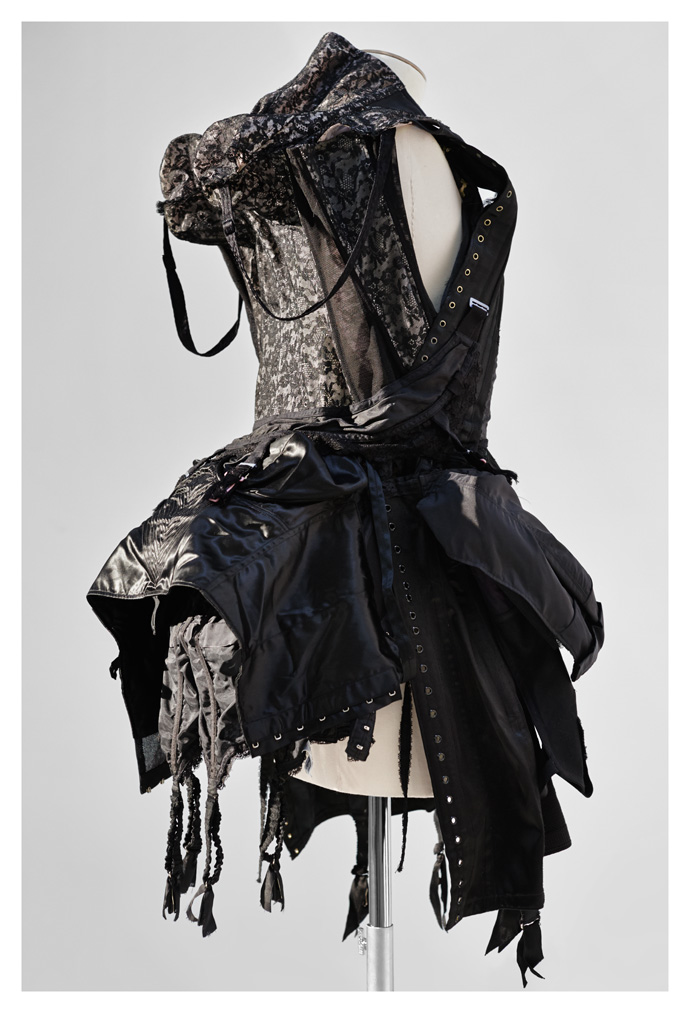
Undercover signature: the trench. Right: Pile-on vintage lingerie evening jacket. Photo by René Habermacher.
How is Japan to you today with the changes the country had been affected with the tsunami and the Fukushima incident especially?
Since the disaster was such a big thing and with the economical situation everybody’s feeling was like “hit the bottom.” We cannot be worse anymore. But now the people are actually trying to go up to be positive, they step back and reflect what can we do to recover from such a disaster. Maybe the government is not helping us that much, but people are trying to do something themselves, try to get the economy back and be positive.
How do you imagine the future your kids are growing up into?
They are little kids right now, but they are starting to have their own will where they wanna go. I am not so worried about them because they will find a way by themselves. We’re concerned about the future and the nuclear problem in fukushima, the earthquakes and what kind of effect this will have on us, but my kids will find their own way so I am not too much worried.
Are you still telling your kids stories of Grace? How is Grace, will we hear again from your creature?
I will continue with Grace- but Grace is not for little kids. They get a little scared… with one eye and all that.
I have a Grace doll in my house but at the beginning the kids were a little scared.But if you were a kid you would not be scared…
It’s scary – but there is an attraction too!
What’s next?
Showing the next collection in Paris again!
What is the last thing that stimulated you?
So many various things! conversations with friends – it’s not just one – it’s many different things.
I absorb everything. Family and friends are important. It’s important to have close friends that are straightforward in their opinion what they think about me, instead of just hiding things. It’s important to me to listen to them. A lot of my friends are creators, photographers doing their own thing. Their opinion is very important to me.
As I get older I get inspired and stimulated by more and more things. I can accept anything like a bus ticket.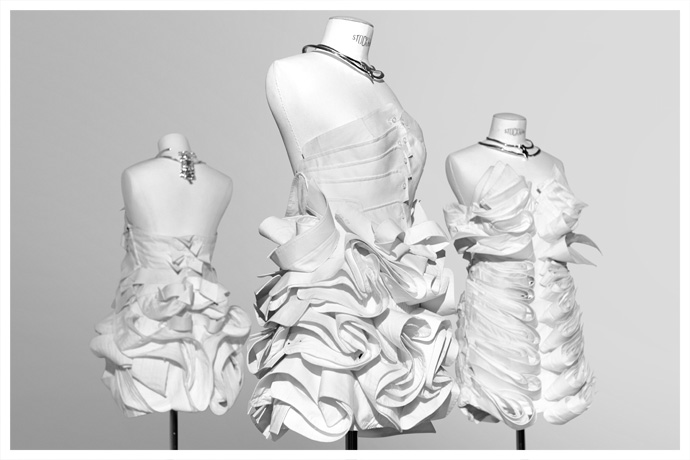
Trilogy in white starch: dresses from deconstructed men's white shirt collars. Photo by René Habermacher.
http://www.undercoverism.com
-

MONSIEUR HERVÉ
-What’s in a name ?
You can ask Kenzo Takada, Martin Margiela, John Galliano, Valentino Garavani or Helmut Lang – designers who, for various reasons, left the company which bears their name, and then had to make themselves a new name, in fashion or elsewhere.
Or you can ask Monsieur Hervé Léger, the legendary French designer who took fashion by storm with his body-conscious designs, ultimately embodied by the “bandage” dresses. Monsieur Hervé Léger does not design for Hervé Léger, the company. Monsieur Hervé Léger designs for Hervé L.Leroux, a nom de mode suggested by Karl Lagerfeld.

Photography by René Habermacher
Filep Motwary, who met Monsieur Hervé through model and muse Suzanne Von Aichinger, talked with the designer as he prepared his new couture collection for Summer 2013, now on display in Paris in Colette and on presentation in Monsieur Léger’s new but history-laden atelier.
Filep Motwary: So, how is your day so far?
Mr. Hervé Léger: Well it’s cool. I am peaceful today. Yesterday I was not, but today I am.F.M: You are getting ready for your Couture collection ?
Mr.HL: Yes, you see I am a professional, I try to do everything in the right context and I do not like to keep my people working at night and we are trying to be efficient and of course we will be ready on time. You know I’ve been creating for a long time, but because I didn’t want to make shows, my comeback is under new conditions. And it figures that some people always followed me and now I sell worldwide. Business is good now finally again and I am pleased.(As we speak, Suzanne Von Aichinger and René Habermacher are working in the showroom photographing the garments),
F.M: I understand. Do you mind if you help me fill some gaps of your life’s storyline, because it’s out there, but not fully completed… So, it was during the late 1970’s that you started-off your career as a hat maker and hairdresser?
Mr.HL: (Laughs) It’s a crazy story, but… I’ll try to make it short. I had done some studies like everyone, I went as a young man to the Beaux Arts in France though I only stayed for one year as it was the 70’s and France was all about manifestations at the time and intense political changes. As students, we were on the streets demonstrating and I wasn’t learning a lot since everything was on strike.
I also wanted to be independent from my parents and wanted to do something by myself, to work. I am very good with my hands; I am a craftsman and can do everything with them in terms of creation so I decided to be a hairdresser. Although I didn’t study hair, I learnt the job very quickly by opening the door of a hair-salon telling them I wanted to learn. They took me and stayed there for a while. Then I started to make hats, after finding a book at my grandmother’s house, which was full of illustrations on how to make them. The first customers arrived and I was working at home. So there goes the “hat story”.
Then one day someone who was famous in the 1970’s asked me to do a very particular hat, a-giant-sort of “Belle Époque” hat with a lobster on it (laughs). The guy’s name was Tan Guidicelli, whom you probably might know. It wasn’t long enough until he asked me to make three dresses for his show because his atelier was very busy and his show was in three days. Although I had never designed any dresses before, I said “Ok, I’ll do them” and when he saw them he said “ you got a real sense of fashion and you should stop hairdressing and come work with me”. So that was my first fashion encounter.
Of course I dropped hairdressing and started to learn sewing. Later I went into design. My second big encounter was Karl Lagerfeld.
The 1980’s were an easy time. You could easily meet someone. People were more open. Even during my days as a hairdresser, with my friends, you could end up having dinner with Claude Montana, Mugler, Lagerfeld etc. It was not such a big deal as it is today. It was proper dinners you know, not charities. So at the time I met Karl at the house of a journalist friend and something happened immediately. We started talking about corsets (at the time I was fascinated by corsets). So that was on Saturday and on Monday my friend from “Woman’s Wear Daily” called to say “Karl wants to see you.” So I went with a few sketches and he said, “ Well, I don’t care about your sketches, I’m looking for an assistant at Fendi in Rome” and I said “Yes!”.
So by next Friday I was on the plane flying to Italy.Then I went to Chanel for one year and worked for him until I was fired.
I created my own label in 1985 but the bandage dresses came out only in early 1990’s. I don’t consider the beginning of my career started in the 80’s. My career, as I see it started in the 90’s.F.M: Tell me about the bandage dress…
Mr.HL: The real story of the bandage dress is important as a fact of my work storyline. I was having a show at Angelina Tea Salon in Paris, and I wanted something glamorous for the finale. I didn’t have the fabrics. A few days later, I went to a factory and found some bands of metallic yarn, sort of lurex. I asked, “What is this?” and I was told “its for the garbage”. So I took that and I started to put one yarn next to the other and started molding the bands on the dummy, exactly like you do hats. And that’s how the first bandage dress was born. I did the show and it was a success.
I was hooked on these new for me materials and started to experiment. In the beginning, I did not want to put any zippers because I wanted to create a dress with no seams. The problem was that I did make the dress with no seams but when one of my clients got herself in, she couldn’t get out (Laughs).
Then came the presentation of nine dresses in the office of my press attaché at the time. The fashion journalists from American Elle made pictures and became a success very quickly.
F.M: This technique you are working on, the way you make your garments is really one of its kind. Allow me to say that I see them as dresses for women to please men…
Mr.HL: It’s true! Its because they make women look great. The fit is great because it shapes the body. For example, the body of a young girl is not my cup of tea. I like bodies with a bosom, with a waist, curves…
My dresses can give a shape even to bodies that are not perfect. This is why I think men love them the same that women who wear them. They seem almost like a modern corset with no bones. The fit that a woman experiences at Herve L.Leroux is the fit I invented at Hervé Leger. Even in my couture dresses today, I use the bands and my own technique, the one I invented then.
F.M: Hervé, I want to ask you about the true story about what happened. How did you lose control of Hervé Léger in 1999.
Mr.HL: People say that I sold it. That’s a lie, I mean I wish I would have sold it.When the bandage dresses started to be famous, a man that was fascinated by them approached me. He said to me “I went to a party in Caracas and a woman arrived in one of your dresses and everybody went crazy.” He “chased” and sent me some bankers asking to be my partner. Of course I said “Yes” because I wanted to develop this business and I didn’t have to run after any partner anymore…
It was a nice combination and it was Seagram, a very powerful group who invested money and soon Hervé Léger became a major house.
Though I had to be very conscious about the number of sales, otherwise they would drop me. The story is that the guy from Seagram decided to get rid of a few companies they had in order to invest on a bigger French company called Vivendi. At the end he sold everything, including me, although he assured me before that he would find me a new partner and he would help to finance the changes.I had someone who wanted to buy the company from Seagram, they put the dossier in the bank’s hands and then they sold it to Max Azria. So he bought it, though I tried to make it work but it fact it didn’t. At the time I was only left with 5% of the company…
When people invest in a company, especially in the fashion industry, the designer or the name behind the company, has to stay part of it otherwise it won’t invest.Some people like Donna Karan, did it in a very clever way for example.
I guess it didn’t work for me because I didn’t have good lawyers at the time…I didn’t agree with the strategy and they fired me from the house I had created. The worst of it all was that he didn’t know what to do with the house of Léger for a long time. In 2007, which is quite recent I may say, at the same moment when I decided to do ready-to-wear again, he opened the archives he started to re-do my dresses from back then for Hollywood stars and the bandage dresses were successful again.
F.M: And what did you do?
Mr.HL: Wolford contacted me and they asked me to work for them… Then came my shop. The problem was I couldn’t use my name anymore. It’s Karl Lagerfeld who came up with the idea of Hervé Leroux. He said “you’ve got red hair” so it has to be called Hervé Leroux and put the “L.” in the middle, who knows one day you can do again “Hervé Léger Leroux.”F.M: So, back to your collection. How did you start again?
Mr.HL: In 2000 I did a comeback with ready-to-wear and I had immediately lots of customers coming, especially from America. Then came another incident, 9/11. No one came after that.It affected everyone and the business went downhill. That’s when I decided to stop ready-to-wear as it was very expensive to create, have production control, distribution etc… So since then, I focused on Couture until 2007, only for private customers and some shops that wanted to buy a few of my pieces. It was a difficult time but I survived.
It was in 2007 when my customers wanted my ready-to-wear again and it went very good. We are in Colette and so many other prestigious boutiques around the world now. I am very satisfied.
F.M: You are a designer that works with couture methods, a real artisan. How do you see the use of “future” references and approach in fashion in combination with technology?
Mr.HL: I think moving towards the future is good for this business, generally speaking..Sewing a dress is always sewing a dress.
For me what is more important is that the clothes look good and made with good materials. I know nothing about technology whatsoever. I know that my clothes are very true; I use very particular techniques to make them. I am more of a couturier rather than a stylist. I don’t go scouting for old clothes to re-do them, I don’t search for ideas around. Even at moments when I wanted to copy someone, I just couldn’t do it you know?Other’s people’s clothes don’t inspire me. I am obsessed by my own ways of creation and I feel lucky to have customers starting from 16 to 70. I am never about trends; I see no use in them. Today I have the feeling that it is all about money. Designers today don’t spend hours fitting a dress on a body. They do it on dummies. I feel comfortable with the way I work.
F.M: How were the 1980’s and 1990’s fashion scene compared to what we see today?
Mr.HL: Oh my God, things were so happy back then, so happy. The 70’s, the 80’s and the 90’s. People were passionate and they could make money from that passion. Bankers, investors or whatever you call them didn’t really exist then so designers were freer. Only one thing Filep, the aesthetic of the girls then is what is missing from today.Or the power the shows had back then. Think of Montana and Mugler!! Oh my God, the girls were so beautiful, the way they walked. I feel lucky for living through that era working with all of them; from Linda to Cindy… I had them all.
And they were so full compared to today that everyone is so skinny. And all my models loved the clothes; you know a lot of clothes would disappear after the show (laughs). Even during fittings those girls would feel the clothes, they were posing.
Today my favorite show is Victoria’s Secret because it’s a happy one. I am not saying girls are not beautiful today, I just think shows today have become boring and less inspiring. They look like robots and there is no charm. I really wonder if I was to do a show today how I should do it and not look ridiculous and dated.
And sometimes I speak with journalists and they are bored of the current situation too.
Anyway, I am not ready to do a show now also because I am not a kid. If I do a show it has to be made the right way as a good show also costs a lot of money.F.M: Maybe you could do a little show in a Hotel Suite like couturiers used to do back in the 50’s.
Mr.HL: Hmm, yes. For this season I just wanted to show the work the way it is. Starting on Monday, Colette will have 5 of my dresses in the window and on Thursday I am showing another 12 pieces in my showroom as I have been invited by the Chamber of Haute Couture and it feels wonderful.F.M: What is this collection about?
Mr.HL: You know I never start saying “I’m going to do this and that”. I just grab my fabric and start working. All I can say is that 80% of the collection is done and it looks like a walk in a Japanese garden. The drapes are very graphic in the sense of Japanese design…F.M: Why does couture still breath? Is it merely a question of tradition? Why does it still interest people?
Mr.HL: It’s exceptional I would say with an excellence. Although the world has changed and we are in the middle of a crisis, luxury is always surviving. What is luxury about today is another story than what it used to be. There are a lot of luxury houses that produce clothes or bags in Taiwan etc. but, there are still women who want to dream. I see my clients… And the movie stars I dress – of course they don’t buy the clothes (laughs).There are still women who are not in the spotlight, not in the newspapers yet they prefer couture because it is special. They are in search of the perfect fit and for me the fit is something important.
F.M: Why is couture so personal as it requires the customer and the designer in a very private session?
Mr.HL: There are less and less couture houses as time goes by. Chanel is a real Couture house for example because they have the right hands to do the artisanship, Gaultier also as well as Dior. Couture has a certain way of doing it, it has its own rules, and also the fabrics are richer. Everything is on made on perfect scale. There are more and more rich people and the opposite, which I find very depressing. We can say there are people who are rich today and they are richer than what the term “rich” meant 20 years ago..
Those who spend, really spend…F.M: What provokes the strongest emotions in you nowadays, compared to what made you emotional in the past?
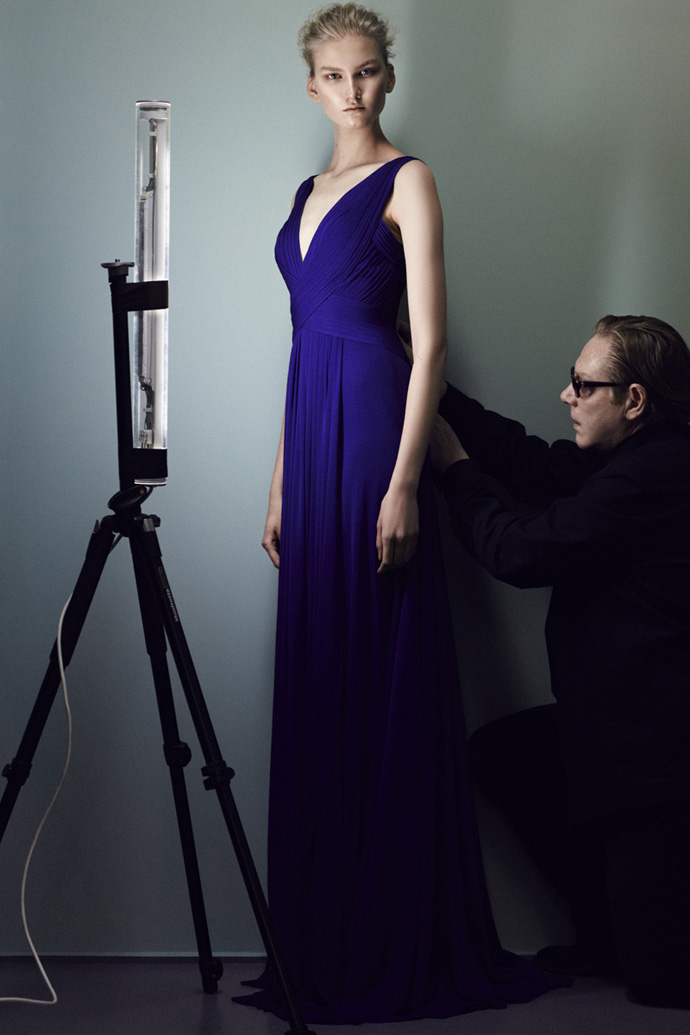
Mr.HL: When I was “Hervé Léger” I was never satisfied. Nothing was good enough and I always thought I could do better. Today, although I still want to do better I become emotional by looking at my own dresses, a feeling I never had before.
I am happier today because I don’t have anybody else involved in my business; I have a great team of loyal people working with me. Also what is very emotional for me is when I see women trying my clothes on.F.M: What is next for you?
Mr.HL: I’m working on developing my business. A perfume that I am working on. I want to start doing accessories, shoes, lingerie and swimsuits. Also my customers locked me in my atelier designing dresses – at least I am famous for something (laughs)- but you know I am very good in designing suits, coats, pants and blouses…Basically when you are wearing Herve L.Leroux, is for the evening. I want to make day-wear too. Although every time I do they never buy it, but I’m going to push.
The interview is a collaboration project between Un nouVeau iDEAL and The Stimuleye.
interview FILEP MOTWARY
photography RENE HABERMACHER
fashion editor SUZANNE VON AICHINGER
hair PANOS PAPANDRIANOS
make up YIANNIS SISKOS
model ANNA MARTYNOVA@ NEXT MODELSthank you VERSAE VANNI @ NEXT PARIS
-

i am a very lazy man : yohji yamamoto
-“i am a very lazy man.”
That’s not really the first thing that comes to mind when you think about Japanese designer Yohji Yamamoto.
Film costume designer, Hyères jury president, Y-3 sportswear line creator, musician and soon film director, not to mention one of the people who revolutionized fashion aesthetics, Yamamoto has done his share.I had the pleasure of spending an evening backstage at his fashion show to get an exclusive peek for the new Joyce.com website.
Antoine Asseraf for Joyce.com, interview by Lucienne Leung.
Thanks: Coralie Gaultier, Filep Motwary.
-

The perfect muse: François Sagat
-In Carlo Collodi’s 1883 children’s novel “The Adventures of Pinocchio” it is the wooden puppet that possesses sentience prior to its transformation; it is the puppet and not its creator, the woodcarver who triggers the miracle of the doll coming alive.
With François one never knows who pulls the strings. It is him who invokes the sentiment for a story to become alive. Yet he hands himself over unconditionally to his collaborators, like an “instrument to be played”, as he likes to call it.
Film director Christopher Honoré once expressed that François Sagat “redefines the notion of masculinity”. François, the humble boy from Cognac has moulded himself to unattainable iconic status. Gilded with his blue inked crane, he is to conquer his righteous spot in the pantheon of pop culture…
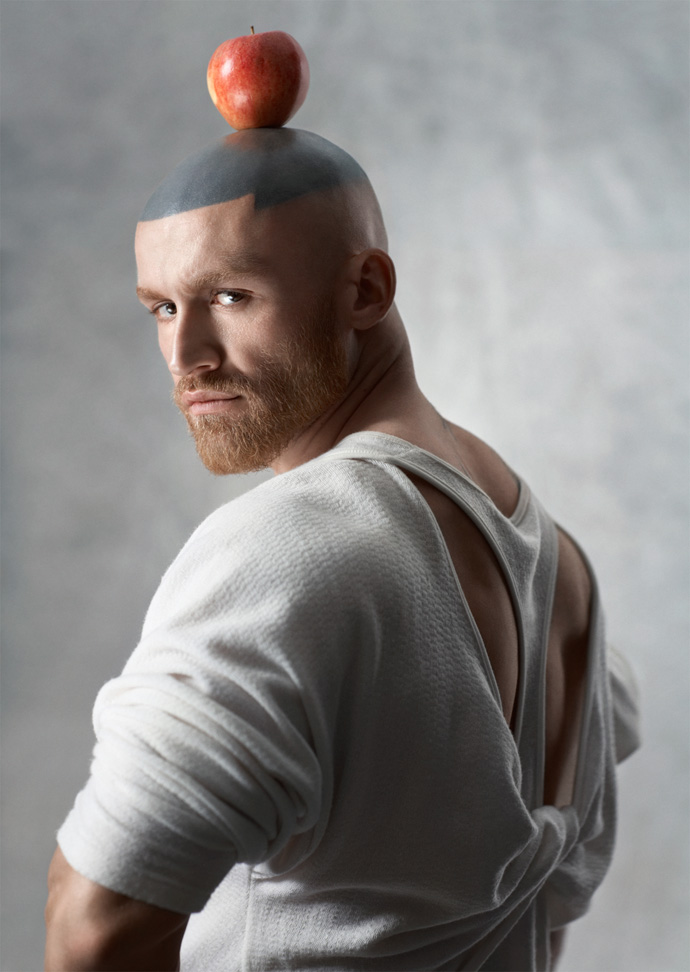 "François Sagat with Apple" Exhibition SPECTRE, Hyères 2010. Photography by René Habermacher
"François Sagat with Apple" Exhibition SPECTRE, Hyères 2010. Photography by René HabermacherRené Habermacher : you recently played alongside Chiara Mastroianni in HOMME AU BAIN by Christophe Honoré, and as well the lead in Bruce LaBruce L.A. ZOMBIE – how were your experiences?
François Sagat: L.A ZOMBIE was an experience which had very little to do with HOMME AU BAIN… The shoot for LA ZOMBIE was like a real porno shoot, scene by scene, it was mostly fucking, except that of course the porno version was censored for festivals…Beyond the sex scenes, LA ZOMBIE was a chaotic shoot, without a script, hasardous… but I’m still to this day satisfied with this participation and collaboration with Bruce LaBruce, from whom I still have much to learn, and who possesses a huge cinema and litterary culture… Despite what his critics say, I think Bruce has a real style.
During the shoot I really tested my capacity to resist “obstacles”, it was at times very difficult, I didn’t know where I was going, no direction, it was like being thrown in the lion’s den.
There was no script, the storytelling was weak and the whole plan was turned on its head by last minute changes and many cancelations, but that can be said about a lot of “cinema” projects.L'HOMME AU BAIN by Christophe Honoré, starring Chiara Mastroianni and François Sagat.
Regarding HOMME AU BAIN, the shooting was a lot more structured, but energetic nevertheless. It’s on this project that I realized that my abilities as an actor were limited, weak even, and felt like I was a big challenge for Christophe Honoré because of my “heavy” image, of the luggage I was carrying.
There were moments when I thought I terrified him, being everything except malleable. The project was constantly evolving due to the fact that we had planned it as a short, and that a lot of questions arose towards the end of shooting. It was finally released as a full feature film, and I have the feeling it wasn’t the right place for the film.It was an intimate project which to me, with hindsight, would have had a strong impact as a short. But I am neither director nor the creator of my own character. Rather than control the situation, I felt the blowback. But surely the imperfection of the final result makes it a real film, that can be remarked and criticized. I chose to shoot it and live the collaboration for the moment rather than think of the finished product.
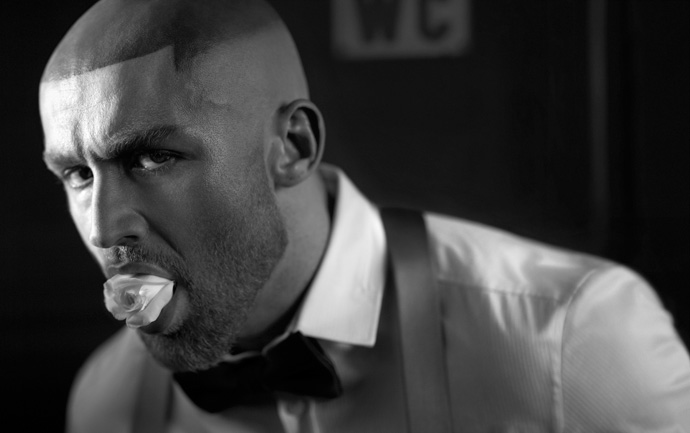 François Sagat for QVEST magazine. Photography by René Habermacher.
François Sagat for QVEST magazine. Photography by René Habermacher.What is the difference to you between acting in a porn movie or a feature film?
The difference ? Of course there are differences.
When you’re a porno actor, you’re in constant control of your carnal envelope and your physical aspect, whether you learn it or you have it from the start.
I didn’t know it as first but I am someone who has that ability. Porn is often an activity for people who are shy orally.
As a performer, you never really have to carry the more or less artistic responsabilities of a porn film, because there is no artistic issue to start with. You just have to be a good soldier fitting what the consumer desires to watch and what the production has decided, and that’s it.
I think also that I am someone who’s very sexual and exhibitiionist, but that’s not really giving you a scoop. Porn is like military service, it’s “my way or the highway”, and in my case, I’ve been and continue to be a good soldier.
The main difference is that you need a capacity to adapt and to lose who you really are, physically as well as morally. I created for myself a character in porn as in life, it’s difficult to let it go.
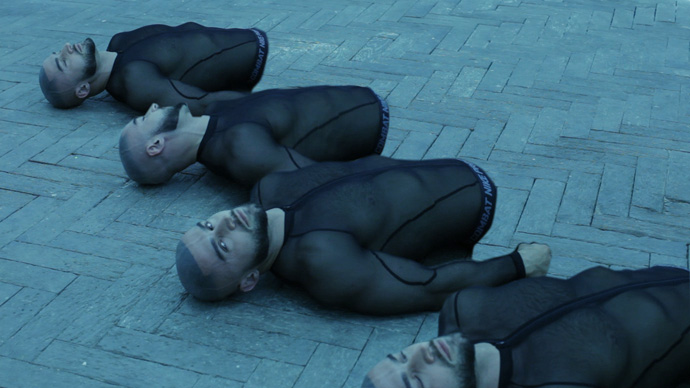 Video still from PILORI installation by Lynsey Peisinger & The Stimuleye. Villa Noailles, Hyères 2012.
Video still from PILORI installation by Lynsey Peisinger & The Stimuleye. Villa Noailles, Hyères 2012. -

comme des garçons white drama
-A few weeks before the Hyères madness, I had the incredible opportunity to once again spend a few days with Galliera curator Olivier Saillard as he put together not 1 but 2 special exhibitions in a brand new space dedicated to fashion in Paris : Les Docks / Cité de la Mode et du Design.
Alongside a special Cristobal Balenciaga Collector exhibition contrasting the 20th Century designer’s creations with unseen objects in his personal collection, Saillard was putting together a second exhibition more anchored in the present, and even in the future:
WHITE DRAMA, an exhibition of Comme Des Garçons’ current SS 2012 collection, with an eye-popping scenography by Rei Kawakubo herself…
a PREMICES FILMS production
Directed by: Antoine Asseraf
Assisted by: Thibault Della Gaspera
Sound by: Pierre Emmanuel MartinetCOMME DES GARÇONS WHITE DRAMA /
CRISTOBAL BALENCIAGA COLLECTORCité de la Mode & du Design / Les Docks
34 Quai d’Austerlitz, Paris,
Until October 7, 2012. -

films of the season 2: My Garden starring Kiko Mizuhara
-Part 2 of our spring fashion film series takes us to Vietnam, a land of mysterious fruits and exotic flowers.
Norwegian Wood actress, Towai Tei-singer, and model Kiko Mizuhara lets us into her garden,
for Vivienne Tam. -

the end of summer hypernation
-The Stimuleye is back from summer hyper-hybernation.
After a galloping transatlantic spiral of frenzy, we lay exhausted for days on various shores around the globe. Meanwhile, not entirely lazy, some of the Stimuleyes danced away in Watermill or invented a bookclub of a new, performative kind, shuffling readings of MANHUNT, STILETTO and Jackie Collins’ masterpiece THE STUD into a new, exciting bootleg. But more about that later.
During this hot days another Stimuleye project rushed through printers rotation: a collaboration with Marina Abramović featuring Freja Beha Erichsen photographed by René Habermacher for POP magazine.

 Freja Beha Erichsen and Marina Abramović, both posing with Marinas "mini-me" and wearing GIORGIO ARMANI
Photography by René Habermacher
Freja Beha Erichsen and Marina Abramović, both posing with Marinas "mini-me" and wearing GIORGIO ARMANI
Photography by René HabermacherThe Fall Issue will feature 2 covers with Marina and Freja and an inside story with exclusive interview, plus a limited edition hardback showing Marina’s death mask. Some of our fellow readers might recognise another co-star: yes, it’s Daisy the Boa which we met in Manchester, in an attempt to strangle the alter ego of Marina, her “mini-me”.
Coming soon to the newstands, the new POP is investigating this time THE REDEFINITION OF THE LADY. As Ashley Heath, its publisher puts it:
“POP has been exploring the notion of a very particular kind of modern fashionable woman. But it’s shifting all the time in such an interesting way. There’s a very liberated, new-world perspective to it and I think Marina Abramovic taps into that. She’s a figure who will only continue to grow in influence I believe. You hesitate to use the word ‘icon’ these days, but Marina and Freja are both resonant female role models at a time when lowest common denominator so often rules the day”
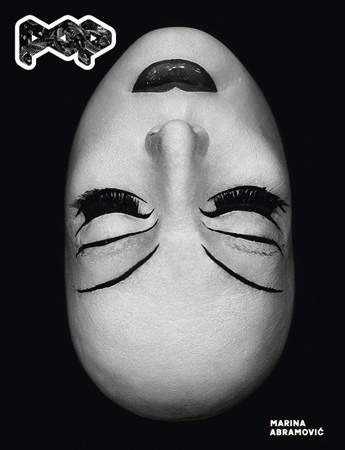
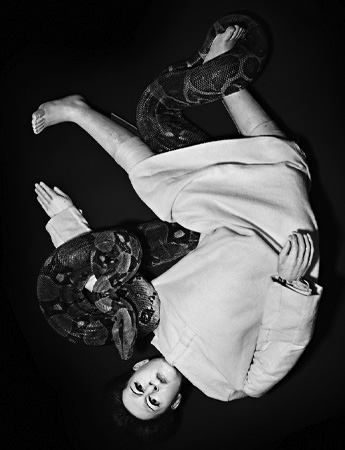 POP's Special edition Hardcover with Marina Abramović's death mask and "mini-me" wrestling with Daisy.
Photography by René Habermacher
POP's Special edition Hardcover with Marina Abramović's death mask and "mini-me" wrestling with Daisy.
Photography by René HabermacherMARINA CREDITS: Styling Isabelle Kountoure , Hair by Chi Wong at Julian Watson Agency using Shu Uemura Art of Hair, Make-up Yannis Siskos at Effex using Giorgio Armani Cosmetics, Photography Assistance Jonathan Flanders & Hannan Jones, Digital Remastering The Stimuleye, Snake Wrangler David Steward for Creature Feature, Production Lynsey Peisinger for The Stimuleye
FREJA CREDITS: Styling Isabelle Kountoure, Hair Peter Gray at The Collective using Shu Uemura Art of Hair, Make up Romy Soleimani at Management Artists, Manicure Tracelee Percival at Vue using Priti NYC, Model Freja Beha Erichsen at IMG New York, Casting Angus Munro at AM Casting, Streeters NY, Photography Assistance Cesar Rebollar, Fashion Assistance Jodie Latham, Stephanie Waknine, Rebecca Sammon & Michaela Dosamantes, Digital Technician Dilek Islidak, Digital Remastering The Stimuleye, Set Design Anne Koch at CLM NY, Production John Engstrom at Scheimpflüg Digital, Shot at Eagles Nest Daylight Studios NYC
-

SIREN SUZANNE von AICHINGER
-Suzanne von Aichinger is a modern archetype of the Parisian muse, in spite of the fact that she was born in Germany, and grew up in Canada.
She was discovered by the legendary illustrator Antonio Lopez, whom she considers to be one of the great influences in her life, as well as a very close friend. She inspired and collaborated closely in the design studios, with Christian Lacroix, John Galliano and Jean Paul Gaultier. Suzanne von Aichinger posed for iconic photographers Serge Lutens, Paolo Roversi, Mario Testino, Jean Loup Sieff, Ali Madhavi, David Seidner, and strutted down the catwalks of Yves St Laurent, Thierry Mugler, Claude Montana, Gianni Versace, Christian Dior (Galliano) , Hermes, Martin Margiela, John Galliano, Jean Paul Gaultier.
In Greek mythology, the Sirens with the irresistible charm of their song, lured mariners to their destruction on the rocks surrounding their island..
In modern mythology, Sirens are dressed in Rick Owens, pose for photographer René Habermacher and share their secrets and thoughts on current and past affairs with Stimuleye Filep Motwary…
SUZANNE VON AICHINGER feature, is a collaboration between Un nouVeau iDEAL and THE STIMULEYE Fashion Editor : Ines Fendri ⎜ Make Up : Akiko Sakamoto ⎜ Hair : Karin Bigler Production : Lynsey Peisinger for THE STIMULEYE Special Thanks to Mr Rick Owens and Anne van den Bosche @ Rick Owens Press Office
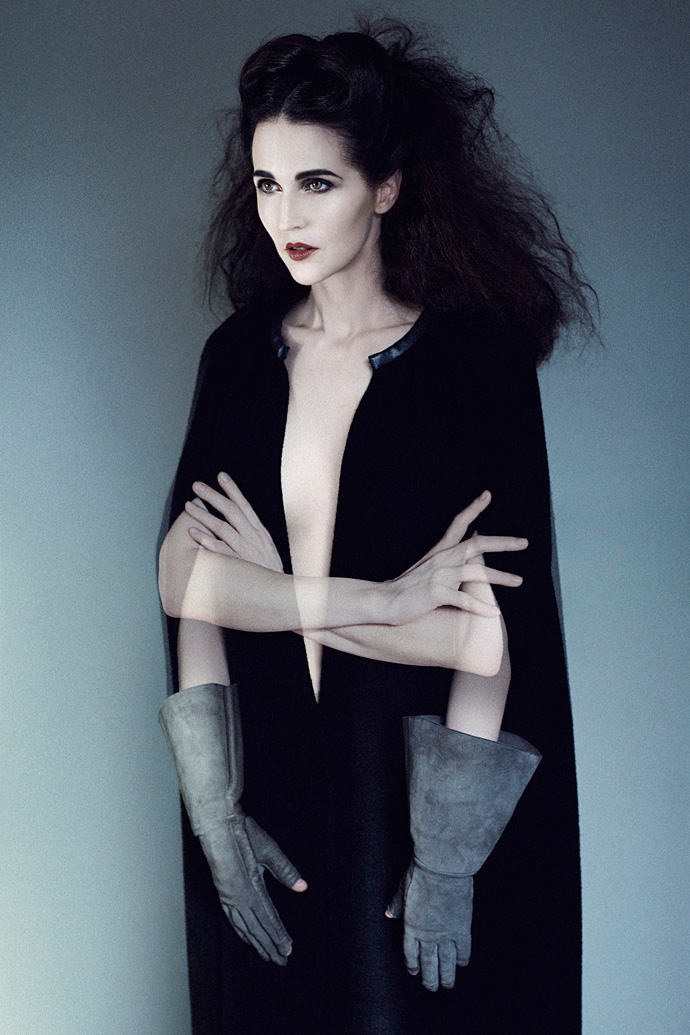 KALI, Suzanne von Aichinger wears a Rick Owens cape and gloves, all FW2011. Photography by René Habermacher
KALI, Suzanne von Aichinger wears a Rick Owens cape and gloves, all FW2011. Photography by René HabermacherI always liked her and when we finally became friends, I liked her even more. In the following conversation Suzanne shares her thoughts on fashion, music, talent, the water, mythology and other obscurities. You are about to discover the muse, the model, the artist, the stylist..
I caught her leg on her daybreak between styling for a Vogue photo shoot and organizing a major project.
FILEP MOTWARY: Hi beautiful? So it was very difficult to catch you in the past two months. What have you been up to?
SUZANNE von AICHINGER: I know Filep. I’ve been a little like Houdini…escaping. But for a good reason. I had plenty of work and styling projects
Tell me more about it please. It seems you work non-stop.
It’s been good for me lately. I’ve been styling some perfume campaigns, editorials for Russian Vogue, Italian Vanity Fair, doing photos with Dita, and now I’m preparing another perfume campaign, and a major photo shoot with one of the MOST gorgeous women on the planet.
Oh Gosh, indeed its a lot. You mean the actress, Elisa Sednaoui? Ali posted a shot of her on twitter…
Oh what a beauty Elisa is!!! But, I’m referring to another lady…very iconic. I don’t know if I should say who it is. I don’t like to talk about things before they come out…
I understand. How easy it is for you to collaborate with people. What a concept needs to have in order to get you involved in it?
Collaborating with people is my ultimate way of creating. I find the dynamic of working with another or others, stimulating, and proven a successful way of expression for me.
How do you make your choices? Is money an important motive or not always?
There has to be an element that compels me, something that excites my imagination. I also have to feel that I have something relevant to bring to the story. Money is very often not a motive. But, sometimes it is an essential part of creation. We must also live, make a living, etc. You have to know when to give and when to sell!! There is no shame in being paid for a job well done. Andy Warhol considered making money the highest art form. I’m not sure that I adhere to this philosophy, but I don’t love being broke either. I like the freedom that having some cash on hand can procure you.
On the other hand there might be talented people, who would love your contribution but, lets say, cannot afford you. How would you react in such conditions?
I usually say YES to a project, which stimulates me. It’s not about the $$$. It’s about the action. I believe in working with people that I consider talented or kindred spirits. As people of great talent have wanted to work with me, when I had no money to pay them. Just for the sheer joy of seeing an idea become a reality.
I wanted to ask you about the photo shoot you just did with René Habermacher. It’s so iconic, yet in a very special way. How was working with René?
I loved it. We had a beautiful day together, with a great creative team. We wanted to express in this series, something that is based more on personality, than fashion. I feel that there are many stories to be told in my future with René. There is a quality in his vision that is very strong and appealing.
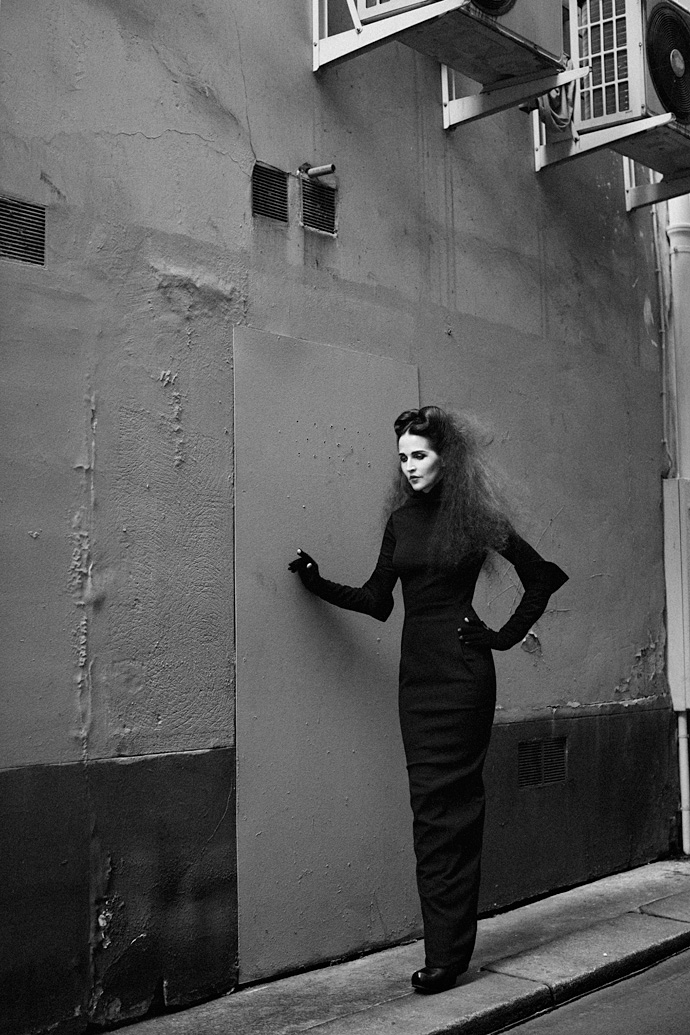 CASSANDRA, Suzanne von Aichinger wears a Rick Owens dress, boots and gloves, all FW2011.
Photography by René Habermacher
CASSANDRA, Suzanne von Aichinger wears a Rick Owens dress, boots and gloves, all FW2011.
Photography by René HabermacherExactly my point. The photographs serve our conversation so right! I’m very happy that Rick Owens was so positive when I contacted him for the garments. He is always so nice to me. Also for the fact that we shot his winter collection which is by far my favorite!
So am I! I LOVE Rick! He is one of my favorites. And, his fashion is timeless. I know that this can sound cliché, but if you have some pieces by Rick from 12 years ago, they are as relevant as pieces that he has made 2 days ago. They don’t go in and out of fashion. They have their own essence and place.
Having in mind that Rick’s clothes are so special, yet the 2000’s are the epitome of diversity. Each designer points out a different outline every season, there is so much choice. How do you see fashion now yourself, as a stylist?
It’s hard for me to answer this. I see many great things happening, no doubt. But, I see a lot of nonsense going on as well. There is not enough power any more in the hands of the creators. Now, big design houses change designers like they change their underwear. Just ridiculous. There is no time for the designer in place to create a brand identity, that he is fired. And very often, they find out that they’ve been fired, by reading about it in the papers.
It’s as if the financial/commercial people at the heads of some houses, envied the position of creator, and wished to usurp it. They believe that they are capable of being the creator. WRONG!!!!
(more…) -

TOO FUNKY to last: the mini decade
-The other day, Stimuleye Erotokritos Antoniadis swung by with a little treasure: when working as a stagiaire at Thierry Mugler, he was asked to snap some backstage pictures of George Michael’s TOO FUNKY video shoot.
And here they were – George, Thierry, the Lindas and Naomis, Shana, Eva, Rossy de Palma, Ivana Trump, Diane Brill, Lypsinka, Jeff Stryker and so on.
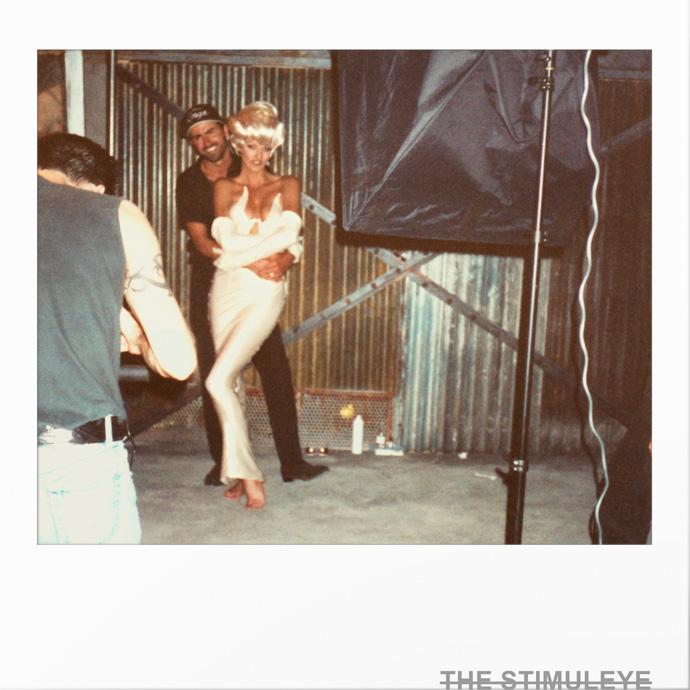 George Michael and Linda Evangelista on set of TOO FUNKY posing for the official picture. Photo by Erotokritos
George Michael and Linda Evangelista on set of TOO FUNKY posing for the official picture. Photo by ErotokritosThe song features a sample from The Graduate; Anne Bancroft’s line of “Would you like me to seduce you? Is that what you’re trying to tell me?” – and YES we were, then and now, instantly!
When this video was released in 1992, it was both the epitome of a glamorous era stretching from 1988 to 1992,
and a marker for the end of said era.An era that was no longer 80’s and yet not fully 90’s. What to call it ?
“80’s and a half” ? that would suggest that this era was an extension of the 80’s, when in fact it was more of a break…
We settled for the “Mini Decade,” a 4-year period with visual, musical and cultural codes so unique that they deserved a decade of their own.
As a teaser for our Mini-Decade series, here is a teaser, pictures which have been sitting in a box, unseen, for over 2 decades…
Stay tuned for more.
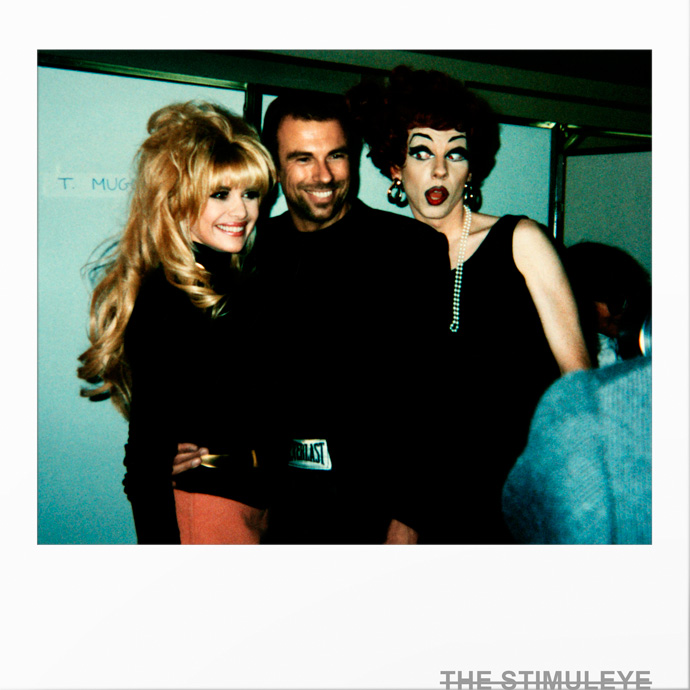
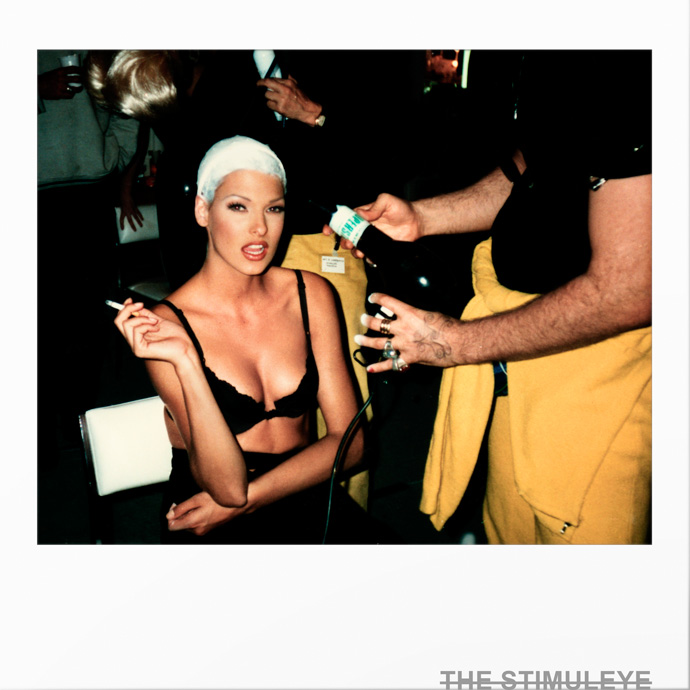 Left: Ivana Trump, Thierry Mugler and Lypsinka stand in for another snap
Right: Linda Evangelista, always ready for her 'look'. Photos by Erotokritos
Left: Ivana Trump, Thierry Mugler and Lypsinka stand in for another snap
Right: Linda Evangelista, always ready for her 'look'. Photos by Erotokritos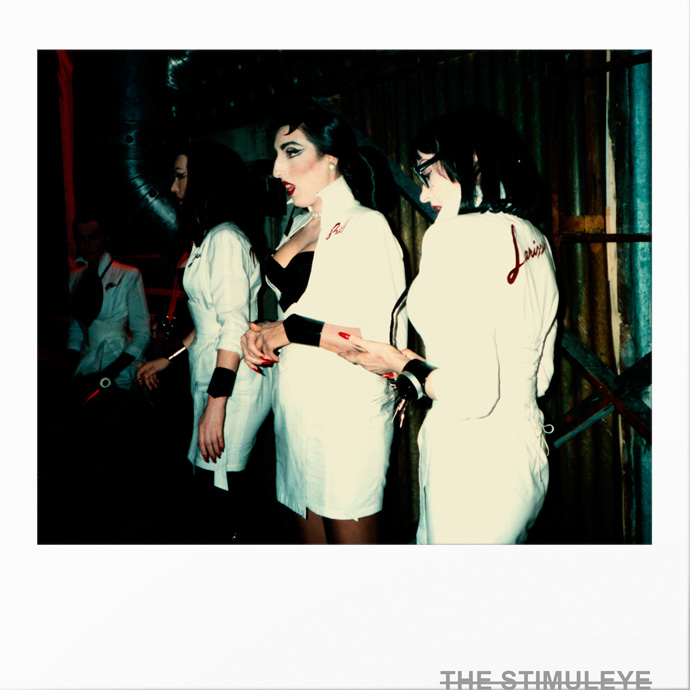
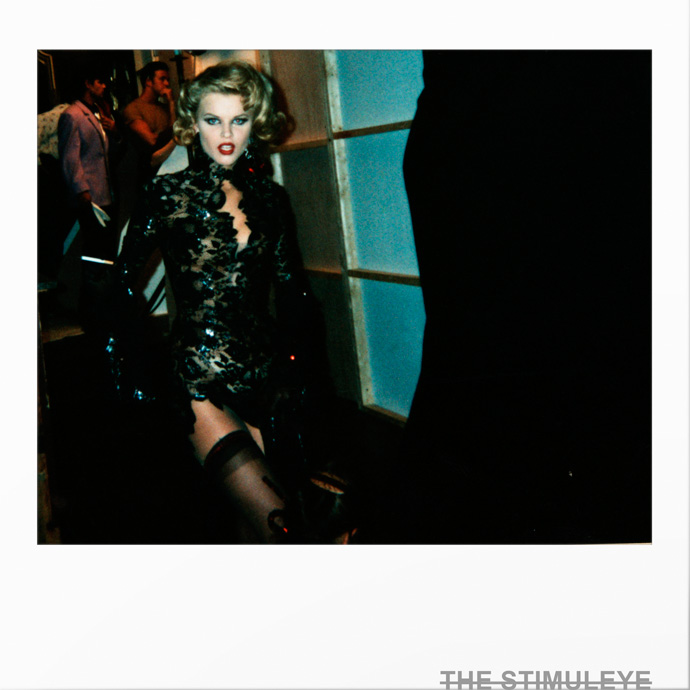 Left: Fierce Trio with Rossy de Palma, and Right: the very young Eva Herzigova. Photos by Erotokritos
Left: Fierce Trio with Rossy de Palma, and Right: the very young Eva Herzigova. Photos by Erotokritos -

MAX SCHELER: from Konrad A. to Jackie O.
-The exhibition “From Konrad A. to Jackie O.” at the Willy-Brandt Haus in Berlin will show for the first time a cross section of the work of Magnum photographer Max Scheler. On display throughout June and July are 140 images that document the distinct view of this artist who preferred to stay in the background. From this intimate eye-level position, he witnessed his time and documented its events with impeccable framing and allure.
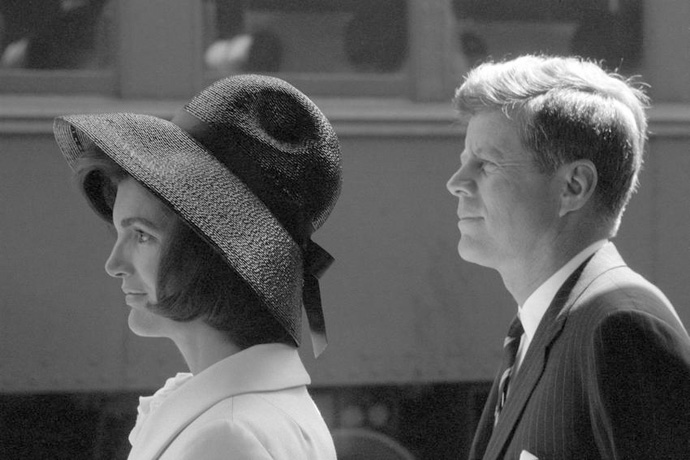 USA, 1963, Washington, John F. Kennedy and Jacqueline Bouvier Kennedy receive the Moroccan king Hassan II
© Max Scheler Estate, Hamburg Germany
USA, 1963, Washington, John F. Kennedy and Jacqueline Bouvier Kennedy receive the Moroccan king Hassan II
© Max Scheler Estate, Hamburg GermanyI remember Max Scheler with one of his beloved Davidoff cigarillos smoldering away nearby. He was an impressive character, with an elegant dryness that one would be tempted to account being Hamburgian, yet he was born a boy from Cologne. In his later years Max had dedicated his time entirely to taking care of the Herbert List estate – the iconic work of the photographer who shaped and mentored him. On one of my visits to the archives we went through folders and boxes of photographs and came so across prints of Max’ work for the first time, almost by accident. I had not been aware of his photography then, though i knew he had worked at Merian and founded the magazine GEO at Gruner & Jahr, introducing colour reportage to the wider audience.
I’ve talked with co-curator Olaf Richter, head of the estates of both Herbert List and Max Scheler about Max, his background and the relationship to Herbert List and the current exhibition
RENÉ HABERMACHER: How did this exhibition come together- and why right now?
PEER-OLAF RICHTER: The idea of this show was born in February 2003 – the month Max Scheler died. It took us about 6 years to finish this project. Why did it take so long? Max Scheler was humble if not neglecting his own work. He stopped working as a photographer in 1975 and since then had turned the tables. He rather worked to publish other photographers work, than his own.I took quite a bit of effort to rediscover what was going on in his life as a photographer. The negatives from the late 50s until the mid 70s were in a rough chronological order, but before that, the first 8 years, were all over the place. For us the first period was especially interesting, because it told us something of where he was coming from. He learnt photography from another photographer: Herbert List.
Herbert List printed the images that he considered important. The Estate had a rich base of vintage prints that covered all the projects he worked on in his life time. These prints were frequently titled on the back. The main books on List that had been on the market had all been made with these prints as a basis.
For Max Scheler things are very different. There is not that much vintage material, and it is hard to say if these old images reflect his personal choice or some editors preference. So we went back to the negative and contacts and researched there. Unfortunately the negative have only a rough labelling, and therefore it took a lot longer to make a selection, research locations and titles.
Max would always put Herbert’s work ahead of his own – which was something that I never understood. Why this hesitation?
I guess he felt that his work of that period, was the work of a pupil, while the work of his teacher, was really what was worth remembering. It is interesting how close the two worked together. After an initial year or two as an assistant on the road and in the darkroom, Scheler started getting his own assignments, gained some respect, moved from Munich to Paris, met Robert Capa and even became a junior member of Magnum.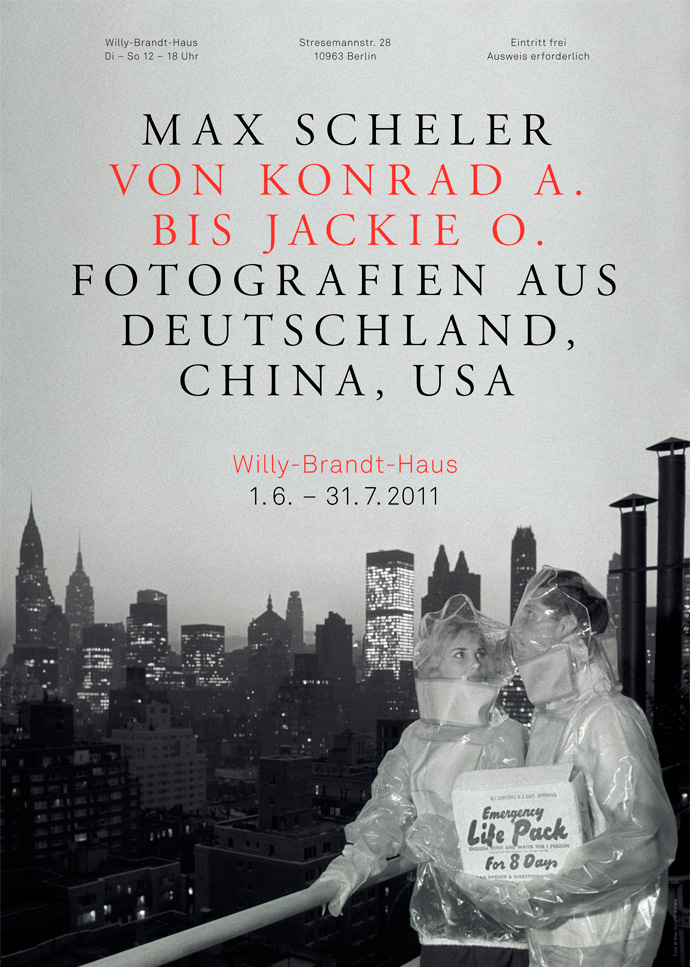
How did the relationship of the two evolve after the first meeting during war in Munich: personally and professionally? I am also asking that as I have a special interest in the idea of the “stimulating” mentor.
I guess stimulation needs at least to prerequisites. At first the receiver of the stimulus needs to be in a situation of wanting to open up, receive a certain change in her/his perception and possibly even her/his life. And the stimulus must also be desireable and fit the pattern of interest of the receiver. If the stimulus is too foreign or threatening it might be rejected. I think these things fell in place when Max Scheler met Herbert List.He was very young then- it must have been the shaping experience…
Max and his mother left Cologne in 1941, when Max was 13 or 14 years of age. Around the same time List left Athens, because Germany invaded Greece. He had tried to immigrate to the USA but failed and had to return to Germany. Max was raised without a father, since he died the year Max was born. The sudden presence of a male person of authority in the life of Max and his mother was quite welcome. Not to be misunderstood all three of them were very liberal, unconventional and forward thinking persons. None of them wanted to construct a classical family. It was more the realisation of his mother that this very sophisticated photographer in his forties did spark some certain interest and outlook in the young max’ life, that she possibly could not, because the was too close. She of course realized that he was gay and therefore no husband material. But she might have also understood that the conventional reaction of a mother to not allow her son to have contact to a 25 years-older gay man, would have been rather short-sighted.
So through the turmoil of the war they kept close contact.
The stimulation we talked about earlier, that caused Max Scheler to learn a craft, languages and a certain ‘savoir vivre’ from Herbert List, developed through that time.
And I think that it was manyfold. I am not sure if photography was really the most potent influence here. And I am not sure what was going on between the two of them emotionally. Did they fall in love? That is speculation, but I guess it safe to say that a certain amount of love and trust is necessary to allow oneself to be stimulated.
(more…) -

ERWIN BLUMENFELD: through the eyes of his son Henry.
-On the second day of the fashion and photography festival in Hyeres, I watched Henry Blumenfeld, elementary particle physicist and son of Erwin Blumenfeld, inconspicuously walking through the exhibit of his father’s work at the Villa Noailles. He was wearing a tan suit, sneakers and a baseball cap that was slightly crooked on his head. Before long, the spacious, bright room where the artist’s photographs and videos were being exhibited became empty and quiet. Only the slight hum of voices around the villa could be heard through the walls. Here, surrounded by a collection of stunning and rare examples of his father’s work — large-scale, restored prints — Henry sat down with us for an intimate conversation: Erwin Blumenfeld the artist, the father, the mentor and the man of perseverance.
by Lynsey Peisinger, Photography René Habermacher
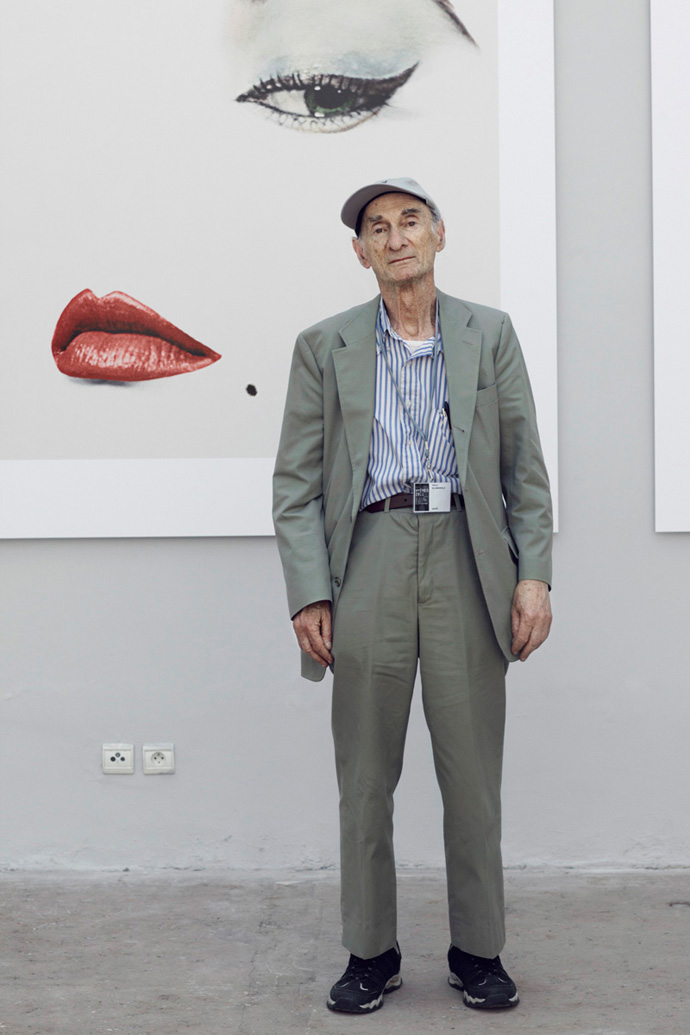 Son Henry Blumenfeld in front of his fathers DOE EYE with Jean Patchett for Vogue US 1950
Son Henry Blumenfeld in front of his fathers DOE EYE with Jean Patchett for Vogue US 1950LYNSEY PEISINGER: Where were you born?
HENRY BLUMENFELD: I was born in 1925 in Zandfoort near Amsterdam. My father had been an ambulance driver during the first World War. During the war, he had met my mother who was Dutch, Lena Citroen, who was a cousin of Pal Citroen, a German/Dutch artist. He grew up in Berlin with my father and they went to school together and they were very close friends. Through Pal, he met my mother and they corresponded during the war. My mother came to visit him in Germany when he was a soldier there. He tried to leave Germany, but he couldn’t. So, just after the war he came to Holland and then, a little bit later, married my mother in the early 20s. I guess, 1921. And because he was German and she was Dutch, she became German — that was the Dutch law at the time. I was born in Holland, but because I had a German father, I also became German.
LP: What was your father doing at that time?
HB: He was surviving. Leaving Germany at the end of the war, he tried to survive with the help of my mother and set up some kind of art dealing business with a friend, but that didn’t work very well. He was doing a lot of collage and kept in touch with other German Dadaists. After two years, he started to work as a clerk in a department store. Later, around the time I was born, he opened his own shop called the Fox Leather Company, selling ladies handbags and suitcases on the Kalvestraat. That went fairly well, but soon Hitler came to power and the business went badly and eventually bankrupt. That’s when he decided to become a photographer in 1934.
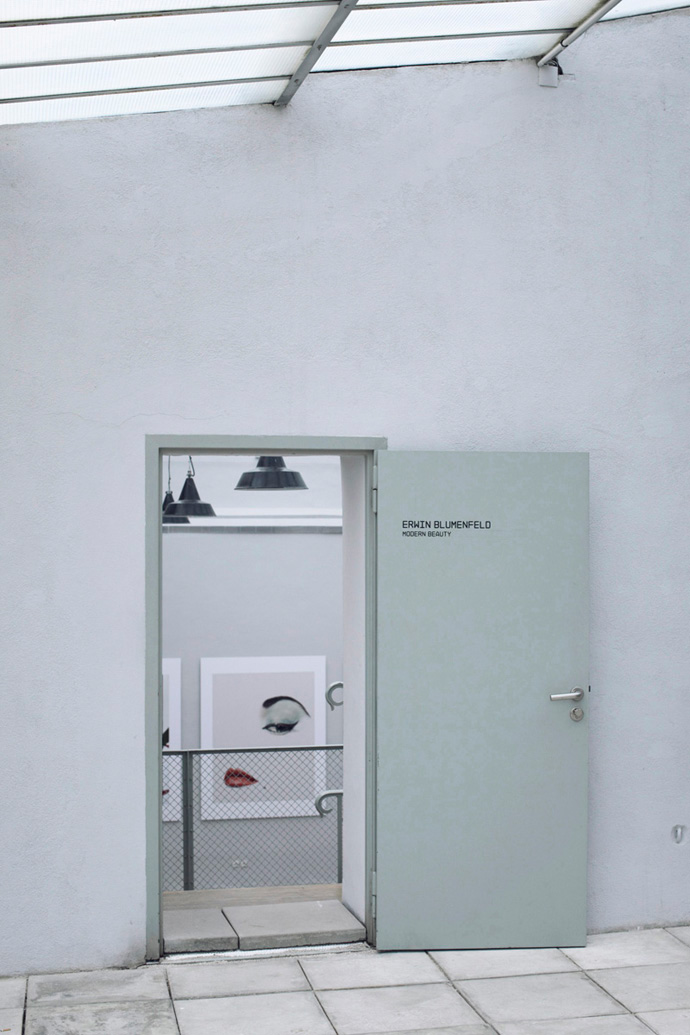
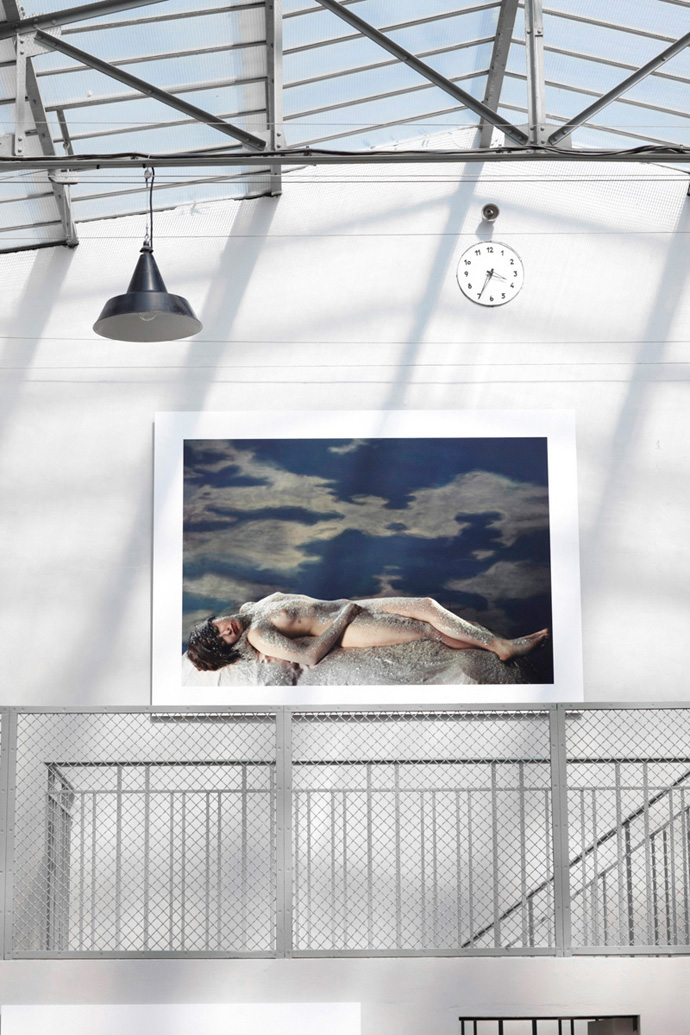 ERWIN BLUMENFELD Exhibition at the villa Noailles Squash Court. Right: Erwin Blumenfeld OPHELIA 1947
ERWIN BLUMENFELD Exhibition at the villa Noailles Squash Court. Right: Erwin Blumenfeld OPHELIA 1947RENE HABERMACHER: So your father’s first art oriented interest was collage and he was in the Dadaist movement?
HB: He was already interested in photography. He got his first camera when he was about 6 or 7. But his main interest was perhaps the theatre. That was something he was strongly attached to: the German language. His Dutch always remained a little bit feeble to say the least. He worked quite a lot, but with theatre in German language, he couldn’t make much of a living… With his collages he couldn’t make a living with that either but always kept in touch with the Germans — Grosz and Richard Huelsenbeck and other people of the Dadaist movement. Recently there was an exhibition in Berlin on this periods work of my father and a book has been published.
LP: Did he continue to do collage later on when he started doing photography?
HB: No. When he was doing collage, he was also painting — he was a Sunday painter: He did quite a bit of painting on Saturdays and Sundays. But he dropped doing his collage and the painting and started doing photography in Amsterdam. The business went rather poorly, he had health problems and more or less escaped to Paris around the 1st of January 1936. The first year it was very difficult for him to make a living. He got support from the family of his wife, of my mother. On his side he didn’t have much family left. His father had died before the first world war and his mother deceased shortly afterwards. He lost his brother in the war as a soldier in the German army and his sister died of Tuberculosis shortly after.
My father was friends with Walter Feilchenfeldt’s wife Marianne. He was a quite well known art dealer in Zurich. Mariane Feilchenfeldt helped him to rent his studio in Paris at 9 rue Delambre.
RH: So in Paris he got introduced to photography on a professional level?
HB: Already in Holland he was doing it on a professional level. He took many portraits and pictures there, but they didn’t sell much. He got in touch with some French people who came to Holland and they eventually supported him when he went to Paris — like Andre Girard the painter. Then, after about a year later, he started to sell photos to small photo magazines in the US and England, such as Lilliput. In 1937, he met british photographer Cecil Beaton who introduced him to Vogue. My father started to work for Paris Vogue in 1938.
When he was in Paris, he worked only in black and white. Color was not yet really developed for photography. It was very difficult for individuals to use color in their own studios, so he only did black and white while he was in Paris. I should mention that for his Paris period, his publications in Verve were very important. He had some of his striking black and white photos published in the first issues of that magazine. In the dark room, he experimented a lot, but only in black and white.
Then came the war and during the war, we were foreigners in france — we were not really refugees, but were without status, so it was quite difficult. In the beginning of the war, we were more or less exiled, we lived in a hotel in Vessely nine months, a sort of medieval town in Burgundy, France with a really nice cathedral. Then the Germans came and my father and sister were put in a camp. My mother and my brother and I, with the help of some Citroen cousins, managed to escape to the south of France. Our father was then in a rather horrible camp in France. We stayed in the Country until 1941, trying to get out. Then we managed to get a visa for the US — my father had been to the US already, in June of 1939. That was were, I think he took his first color photographs. He came back to France in July 1939 and he was stuck in France for two years. Then when we got to go to the US, he started working first with Harper’s Bazaar for two or three years, switched to Vogue and started doing color photography. At the time, he took his color pictures in the studio, using different color lights and so on — he was very experimental. But for the development and the printing, it was completely out of his hands. It was always done by Kodak. At the time, he couldn’t do anything in color on his own in the laboratory.
Most of these photos here were printed by Kodak. When I say printed, they weren’t really printed, they were large color transparencies. Like big negatives — 12 by 15 inches. I think that all of these photos here were taken in this large format and they were transparencies. The pictures were only printed for Vogue — working from the transparencies. Sometimes my father would give some direction on how they should be printed, but he was not generally involved in the printing itself. Only later, around 1956, they started to develop a new process called C-Prints. He bought the C-Print machine and he could start doing his own color. But C-Prints were very unstable as far as the color went — if they were exposed to light, in a few days they would essentially vanish. So all of his work in C-Print is essentially gone. Even the color transparencies that we have of his work have either faded or changed color a lot. Especially the reds, had faded. So, our doughtier Nadia has worked a lot with Olivier Berg at a laboratory in Lozère to try to restore the original colors. She is using the original publications because those prints have kept their color much better than the transparencies. So what you see in this exhibit is the result of the work that Olivier Berg and Nadia have done.
RH: Would you say that your father was somebody who was very progressive and pushing for new things in general?
HB: I don’t know about new things…. He was for the experimental, which is a little bit different. I don’t know if he was really striving for new things, but he tried to do do things differently and experimented. He was very much inspired by especially old painters like Goya and Renoir and much impressed by Picasso. I don’t know if he ever got to meet Picasso in Paris at the time. But he met quite a few artists as Dali and others.
 Erwin Blumenfeld advertising for PALL MALL circa 1957.
Erwin Blumenfeld advertising for PALL MALL circa 1957.RH: But he liked the experimental, so maybe that was something that remained with him from the Dadaist movement?
HB: Yes, that was important to him.
LP: I heard Michel Mallard talking earlier about how remarkable it is that there was no photoshop or digital editing at that time… this image, this one with the lips and the eye, DOE EYE, where the nose is missing and there is color separation, was this done in the retouching process?
HB: This was done in the process of retouching. It was an original black and white picture. It was colored afterwards by my father and by Vogue. They worked on it together. That was a special case because the others that you see were done in color and then reworked. This one did not originally have these colors.
RH: When your father was working, did you often witness his process and how he worked in his studio?
HB: No. When he was in Paris, working in black and white, I was somewhat present. But afterwards, in the States, I was not really present anymore. So I didn’t really witness him working in color.
RH: Was his approach as a photographer more controlled or more spontaneous?
HB: I think both. He was quite controlled — all of these pictures here were taken in a studio. But he also traveled quite a bit in America and in Europe and he took many 35 millimeter color slides. Incidentally, the color of those slides kept much better than the color on the transparencies. But, in the studio, he was very controlled and would take many pictures to get something specific in a sitting.
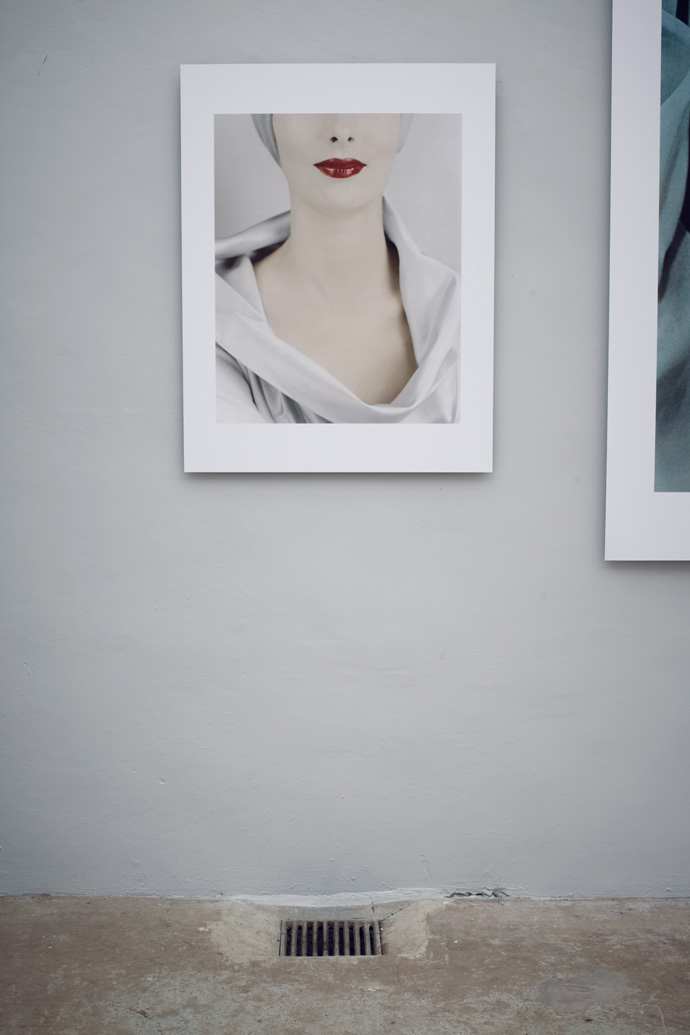
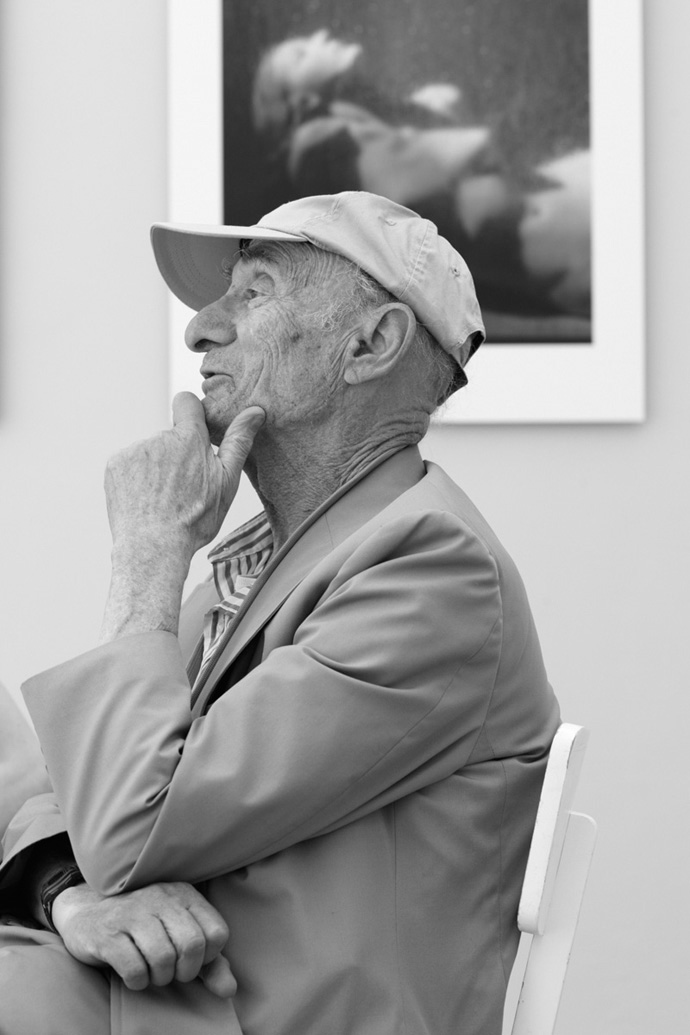 Left: Erwin Blumenfeld LE DECOLLETE 1952, RIGHT: Henry Blumenfeld in Conversation
Left: Erwin Blumenfeld LE DECOLLETE 1952, RIGHT: Henry Blumenfeld in ConversationLP: In Paris, were you present when he would shoot people in the studio?
HB: Sometimes, but not very often. I was more present when he was working in the dark room.
RH: I recently saw notes from Richard Avedon where he had a black and white print and he marked on it all of the places where he wanted the development to be darker or lighter using manipulation techniques in the dark room. Was your father working with these techniques too?
HB: Yes in the dark room, for black and white, he manipulated a lot. It would have been interesting to see what he would have done with color photography if he had been born fifty years later. At the time, the technology wasn’t there for him to do anything after a picture was taken in color.
RH: Where would your father have his intellectual and creative relationships — in other photography or painting etc?
HB: I would think painting. Very much painting, classical painting. Many of his photos were inspired by different painters. He was also inspired by modern life and by life in NY at the time, in the 40s and 50s. He liked jazz music very much, in the New Orleans style.
And he was quite interested in looking at television when it first came out. We got our first television set around 1950 or so. It was black and white at the time. I don’t think he ever saw color television. Maybe he saw it, but he never had one. He liked movies — but more for the content than for the photography. He liked Nanook of the North, about a Danish explorer. He was interested in movies — liked Erich Von Stroheim and he liked Sunset Boulevard and Billy WIlder.
RH: Was that love for cinema also what led to him making films?
HB: The filming was more in line with advertising. I think he was trying to see if he could use the filming for advertising, rather than to tell a story like in movies. Now you see everything mixed, advertising and movies. But at the time, it was an experiment.
RH: Do you think that your father really divided the things that he did for himself and the things that he was commissioned to do? The time after the war was quite commercial driven in America — was it easy for him to also do what he wanted to do?
HB: For one thing, the black and white and the color were two different things. In black and white, he could do what he wanted. In color, probably none of them were published in the exact way that they had been taken. They were made and developed specifically for Vogue. He did appreciate the possibility to work in color, but the whole fashion business and the way it worked was not very attractive for him. But still, when he had started out in Germany, he had started out working for a textile company and so, even then, he was interested in materials and fashion. Still, he didn’t really appreciate the fashion magazine business, but he knew that he could make his living there. So there were two sides to it for him — on one side, it was a place for him to make a living, on the other side, it gave him the opportunity to work in color, which he might not have had otherwise. He did have certain resentments, which is true for everyone in any job.
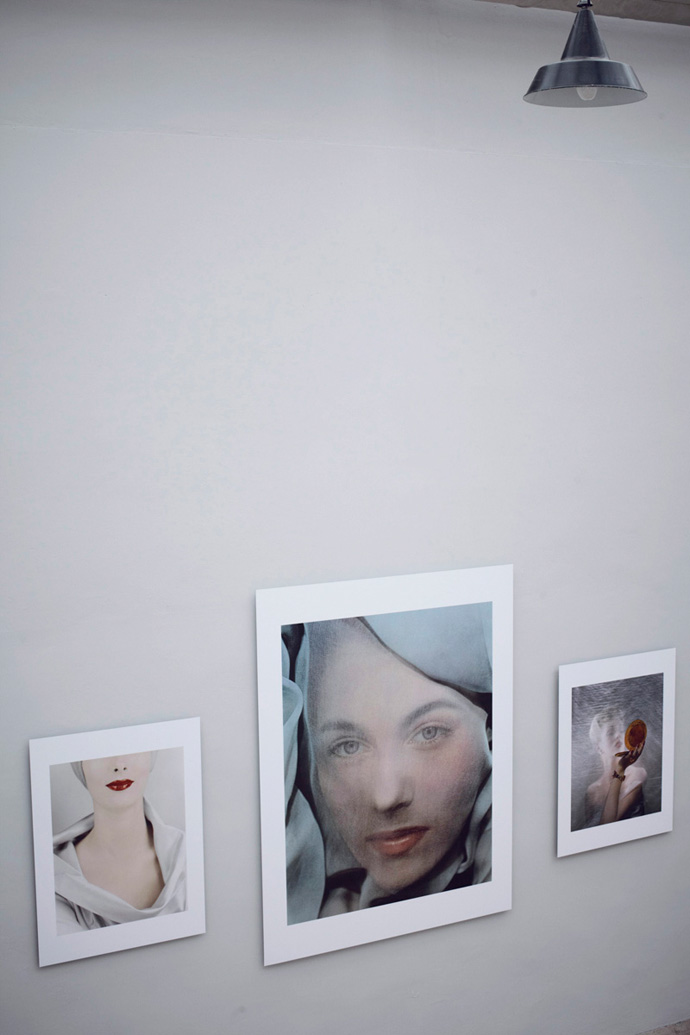 Erwin Blumenfeld DECOLLETEE and BLUE both 1952, and POWDER BOX 1944
Erwin Blumenfeld DECOLLETEE and BLUE both 1952, and POWDER BOX 1944RH: There are artists who suffer between the economical need to do something commercial and the desire to make the work that they are passionate about. They can feel torn…
HB: I don’t think that was his case. First of all, he did well financially in the 40s and 50s and he appreciated that. And then, because of that he was able to continue his work in black and white. You might have seen his book “My One Hundred Best Photos”. We have people comment on the fact that there is almost no fashion in that book–he did a little fashion photography in black and white for Vogue before the war, but later he didn’t do any fashion work in black and white. But, it gave him a lot of satisfaction to be able to do that book of his black and white work.
Still…he wasn’t always satisfied with everything. Becoming old for him was very difficult. It made him suffer a lot…some people accept it, but he accepted it quite badly.
LP: You said that he was experimental as a photographer. As a person and as a father, did he also have that type of attitude? And did he transmit that type of approach to his children?
HB: Well….I think he had his ups and downs. He was a very active father in many ways. He was involved with his children and either pleased or displeased with what they were doing. I don’t know….the children turned out very differently. I became an elementary particle physicist. My brother became a writer. He is not exactly politically minded… he is interested in art, sociology in many ways and in the way people behave. He was very rich in ideas my father, perhaps more so than his children.
LP: Did any of his children take an interest in photography?
HB: Interest yes, but not active in photography. Though, my wife became a photographer. She was born in Paris to an Algerian/Russian father and a British aristocratic mother. She survived the war in France — her father was Jewish, her mother was British, but anyway they would have liked to capture her. After the war she came to New York and worked for one year for the New York Times, one of the first women to work in a non-secretary position at the New York Times. Then she went back to France and when she came back to the States, the New York Times fired her because her vacation to France was more vacation than they were willing to give. Then she met the wife of Alex Liberman, the editor of Vogue, and became model editor at Vogue. Her job was to provide models for the photographers. Then she met my father and after a fews years, she started working for him. She started representing him. She never got any lessons from him in photography but she worked with him as an assistant– sending his photographs to different commercial companies. Then after we got married, she became a photographer herself and worked quite actively as a photographer. First a bit in Princeton where we lived. Then in Geneva for a few years. Then we came to Paris and she started working for Vogue and other magazines. She did mostly portraits of personalities and important political people and scientists etc. And other side projects, like children photography too. To a large extent inspired by my father. Of course, after we got married and had children, my father got another assistant, Marina Schinz. She became a photographer too — mostly garden photography and published a book on that.
LP: It is interesting that she worked with your father, who was doing a lot of fashion photography and then she became a garden photographer…
HB: She admired his work very much and when he died, she bought his studio on Central Park South. And she didn’t have a single photograph of his on the wall.
Both she and Kathleen, my wife, probably wouldn’t have become photographers without him. They were inspired by him, but they probably felt that they couldn’t really rival him, so they chose different styles.
LP: Do you think that he was a good teacher?
HB: He wasn’t really a teacher. But he was a big influence. My wife saw how he worked, but he never tried to give her lessons. Same with Marina Schinz.
When my father died, he let Marina handle his photographic inheritance. From the point of view of his will, it was never very clear…He left the photos with her and she tried to handle it the best possible way. So she divided all of the black and white photographs into four lots–one for each of his children and one for herself. Then she gave essentially all of the color transparencies to Nadia. Now Nadia has been quite active in promoting her grandfather’s work. She is now working on an exhibit for next year in Chalands sur Seine. There is a photography museum there and next year they will do an exhibit of my father’s work.
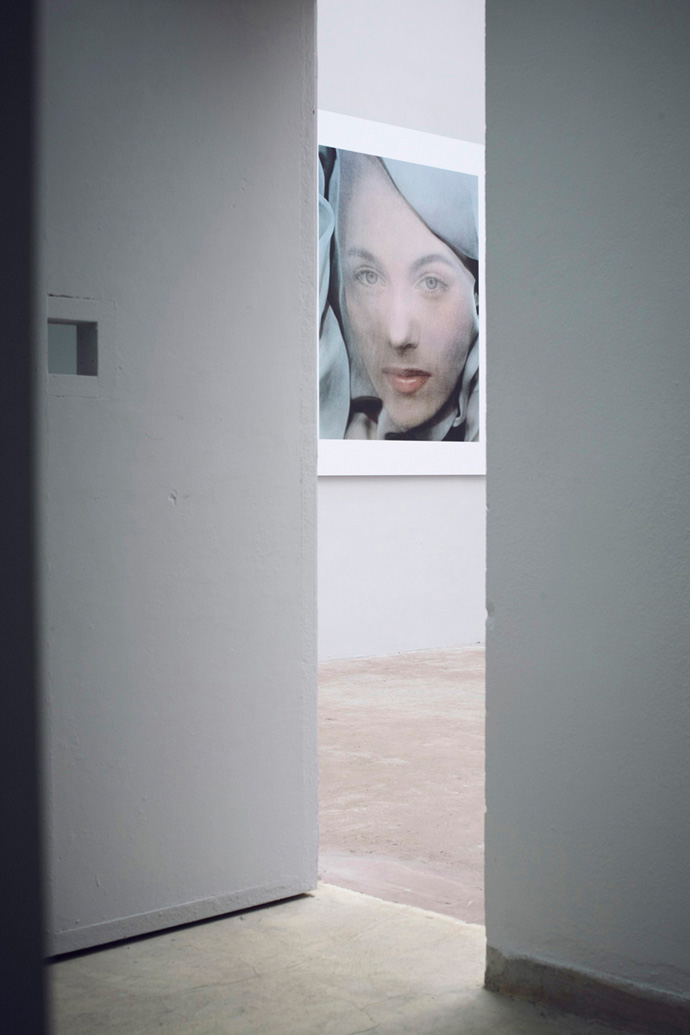
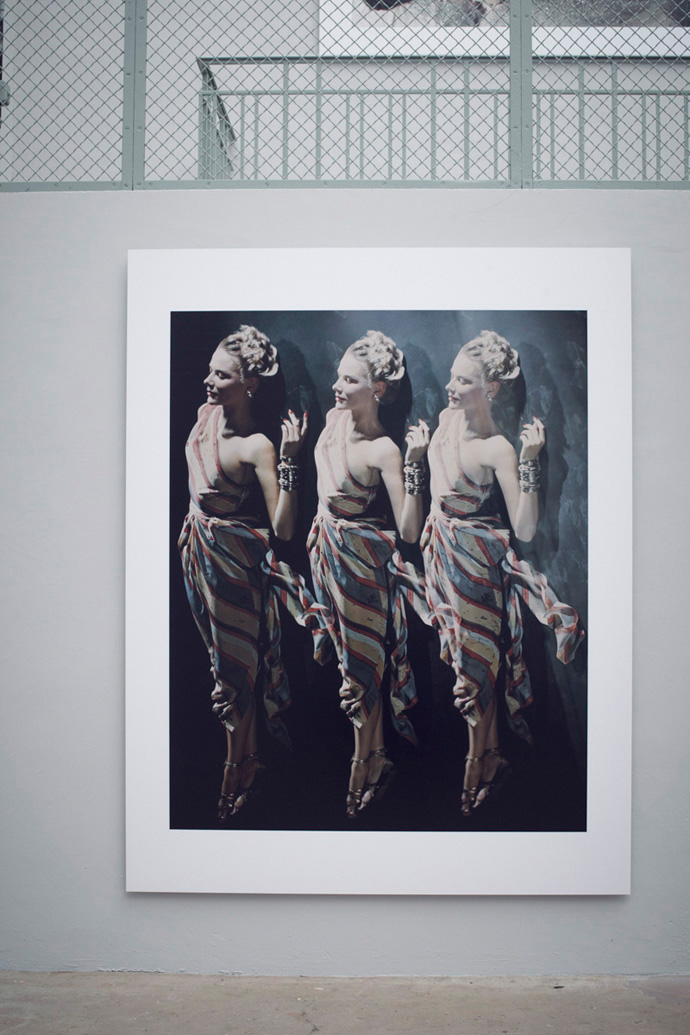 Left: Erwin Blumenfeld BLUE with model Leslie Redgate 1952. Right: Erwin Blumenfeld VARIATIONS, unpublished 1947
Left: Erwin Blumenfeld BLUE with model Leslie Redgate 1952. Right: Erwin Blumenfeld VARIATIONS, unpublished 1947LP: What is the last thing that stimulated you?
HB: What do you mean by stimulated? Something that affected me? Well, the thing that affected me is that my wife, Kathleen, died three months ago. Clearly that affected me. She had been sick, her brain didn’t work anymore. She was going downhill for ten years and in the last two years, she didn’t talk anymore. I don’t know what went on in her head. And three months ago, on the 9th of February, she died next to me…That is the thing that affected me. Also, what affected me was, she died very peacefully next to me. I didn’t realize that she was dead until I felt her and she was still warm and the kin came and said “votre femme est morte”. The morning afterwards, I got the announcement that a second great grandchild had been born. That also affected me. The day afterwards was the funeral and that was quite a moving event–we had five of the grandchildren and they made speeches and my children made speeches and I made a speech. One of the granddaughters filmed it and I now have it on dvd. So, that too affected me. I could tell you more, but maybe that’s enough for the moment.
Kathleen had been very close to my father and she admired him very much. Over the last ten years, she slowly went out of this world.
Thanks to our daughter Nadia, Kathleen had two double page spreads in Match in the last year. Nadia had given the pictures of Kathleen to Roger Viollet and he organized the spread.
RH: What is your work?
HB: I am an elementary particle physicist, experimental! Which is quite different. But I worked first with Cloud Chambers and then with Bubble Chambers and so I surely took more pictures than my father did. Of particles. Millions of pictures.
-

NJA MAHDAOUI: strokes of liberation
-Nja Mahdaoui is one of the most celebrated living contemporary artists in the arab world. His bold and highly rhythmic work, derived from the arabic letter, is internationally renowned and can be found in ther permanent collections of the Institut du Monde Arabe, The British Museum and The Smithsonian Institution just to name a few.
It’s an exuberance of arabesque forms, a visual melody played out of his hand, that remind us of the great gestural and physical richness of action painting. Famous for his meticulous inks on parchment, this “liberated calligraphy” is worked across a variety of extremely different surfaces — from canvas, brass, wood, melamine and papyrus to skin. Though It seems like writing, it is not. It is rather an interlacing of a dialectic relationship, also found within Western abstraction.
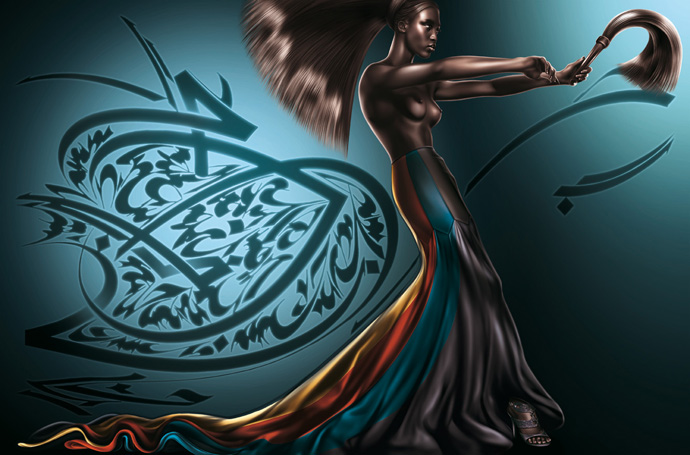 Naomi Campbell in Azzedine Alaïa for Numéro Magazine. A collaboration between Nja Mahdaoui and René Habermacher
Naomi Campbell in Azzedine Alaïa for Numéro Magazine. A collaboration between Nja Mahdaoui and René HabermacherI came across the work of Nja Mahdaoui the first time, while researching calligraphic styles on a project for the French magazine Numéro on a piece about Azzedine Alaïa to which Babeth Djian incited me. The visual impact of Nja’s work struck me at first sight.
Slightly intimidated by the references of the rich body of his work, I first hesitated but then thought to give it a shot, and contacted him. To my surprise he answered me instantly by email, and called me shortly after. Our collaboration was set — and we created a story of imaginary movements around Naomi Campbell as a dark gazelle, in sheer and revealing Alaïa.
But I only met Nja Mahdaoui in person two summers ago in Tunis. It was an all-embracing, hot and sultry August day that lay heavy on the city, matching the emotional state of its people.
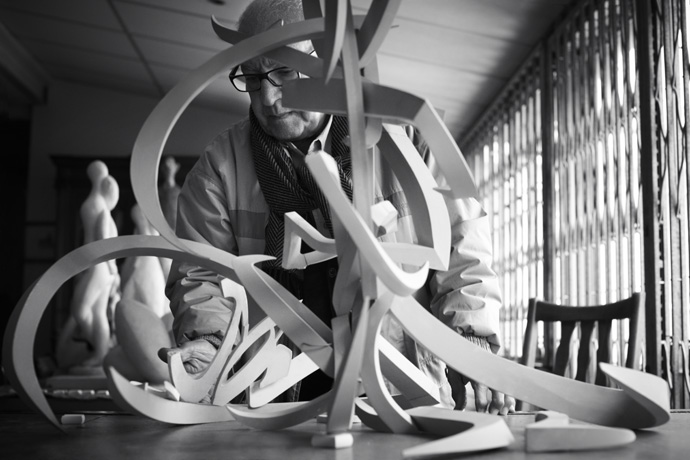 Nja Mahdaoui wit the first prototype of his most recent sculpture. Photography by René Habermacher
Nja Mahdaoui wit the first prototype of his most recent sculpture. Photography by René HabermacherA couple of months after the “Jasmine revolution” took place, Nja arrives in full swing to our meeting at a café in sunny, springtime Paris.
He’d come with his daughter Molka Mahdaoui to work on another of his new projects, yet is consumed with excitement by the events. He reacts immediately and impulsively to the question I usually ask last on conversations for The Stimuleye: What is the last thing that stimulated you?
“Stimulated? You’re asking a Tunisian? (laughs). I don’t know if ‘stimulated’ is the word, but it’s the explosion of a generation, I’m completely into it — for us it’s the event of the century!”
 Nja Mahdaoui: "Graphemes on Arches 2", 2009, Ink on arches paper; 135cm x 135cm.
Nja Mahdaoui: "Graphemes on Arches 2", 2009, Ink on arches paper; 135cm x 135cm.With us at the table are the collaborators involved in the process of making his latest project, a sculpture, the main reason for his trip north. Nja loves collaborations – his eyes glow while he talks energetically about upcoming projects. An energy I felt the first time I saw his bold and highly rhythmic work: “a dance of calligraphy”, with Nja as the choreographer of imaginary letters, to which he refers as ‘graphemes’, devoid of actual textual meaning:
“To a non-Arabic speaker it appears as coherent text. In fact even Arabic speakers assume at first that it’s a text with meaning. But when they start reading it they realise it is not an actual word.” he says and recalls an experience:
“It is not easy to write letters in a disjointed way — that is disjointed to not mean anything — and focus only on the aesthetic. There was a study at the California Institute of Technology in Pasadena. They connected me to a machine in order to test the levels of stress my body was under when I was writing proper words and when I was writing words without meaning. The study showed that my body was 2.5 times more stressed when I was working on words without meaning. So it is a very conscious attempt to create art. I tell people I’m not a calligrapher, but an artist.”
To me his body of work is so vibrant and remarkably innovative that I first had assumed Nja to be in his early 30’s the most, yet he was born in La Marsa, Tunisia, in 1937. As Molka, a filmmaker herself, puts it during our conversation: “sometimes i have to remind myself: Molka, you are thinking older than your own father!”.
 Nja Mahdaoui: Design for Gulf Air 50th Anniversary. Image Courtesy of Nja Mahdaoui
Nja Mahdaoui: Design for Gulf Air 50th Anniversary. Image Courtesy of Nja Mahdaoui -

Out of the box: LEIGH BOWERY
-The other day i was going through boxes of photographs between sheltering sheets of cellophane. I came across a reminiscence from a time when I was obsessed with polaroids: a series of shots that I had taken from artist Leigh Bowery, in what was probably one of his last performances in late May 1994.
Leigh Bowery performing at the RoXY Amsterdam on May 17 1994. Polaroid by René Habermacher.
It was a party at the legendary RoXY club Amsterdam, with Boy George and Robert Owens on the turntables and leading clubbers Sheila Tequila and Stella Stein appearing, to the bemusement of the crowd, nude with pubic wigs only.
That Night Leigh Bowery presented his classc “Birth Show” together with Nicola Bateman-Bowery, whom he had married just 3 days before.As usual for Leigh, the performance, an homage to John Waters “Female Trouble”, would attack the spectators sensitivities- which even worked for the notorious Roxy audience: Leigh would appear to enter the stage in what seemed a rather conservative flower dress to sing with his band Minty, but toward the middle of the song birthed his partner Nicola, who was held under his costume upside down using a specially-designed harness. Nicola then appeared as a very large baby covered in placenta.Leigh died later that year on New Year’s Eve from an AIDS-related illness. A death bed pronouncement by “Modern Art on legs”, as Boy George commented, was: “Tell them I’ve gone pig farming in Bolivia”.
Leigh Bowery and his wife Nicola Bateman-Bowery, then freshly wed. Polaroids by René Habermacher.
It was one of these Spectacles that made the RoXY’s infamous reputation. Not only a club, the RoXY was an Institution. A playground and battlefield for artists. While mingling among the glitterati and club kids of the time I recall seeing there first time the work of Inez Van Laamsweerde and Vinoodh Matadin on a flyer- or a toilet exhibition of Erwin Olafs photographs, an explicit series that was was by far outreached by what was going on in these restrooms…
Founder Pieter Giele’s Motto AB IGNE IGNEM CAPERE (one fire ignites another) came true some years later. The Club that operated from 1987 in a splendid old theatre on Prinsengracht went up in flames the day of Pieter Giele’s Funeral in 1999 and burned down to the ground.
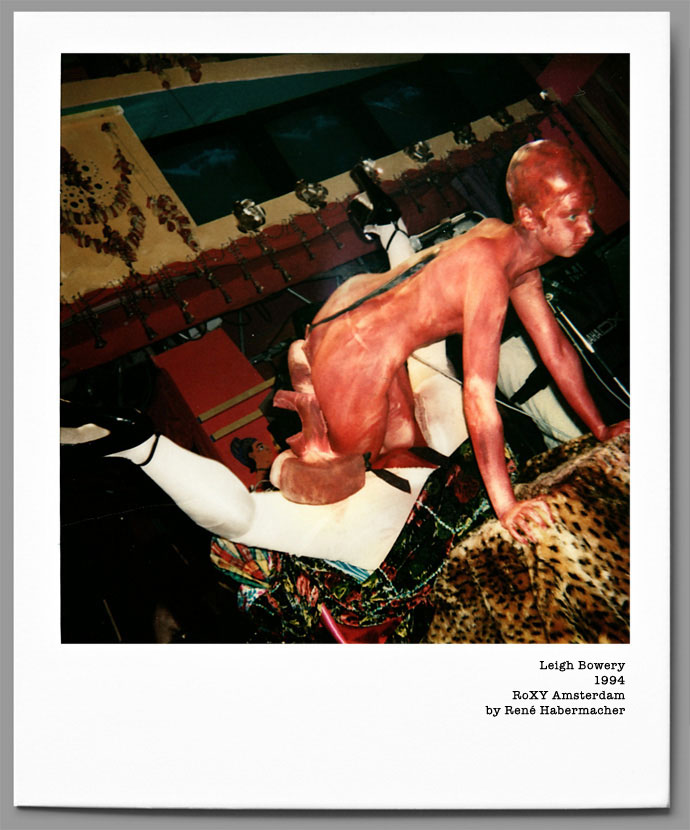
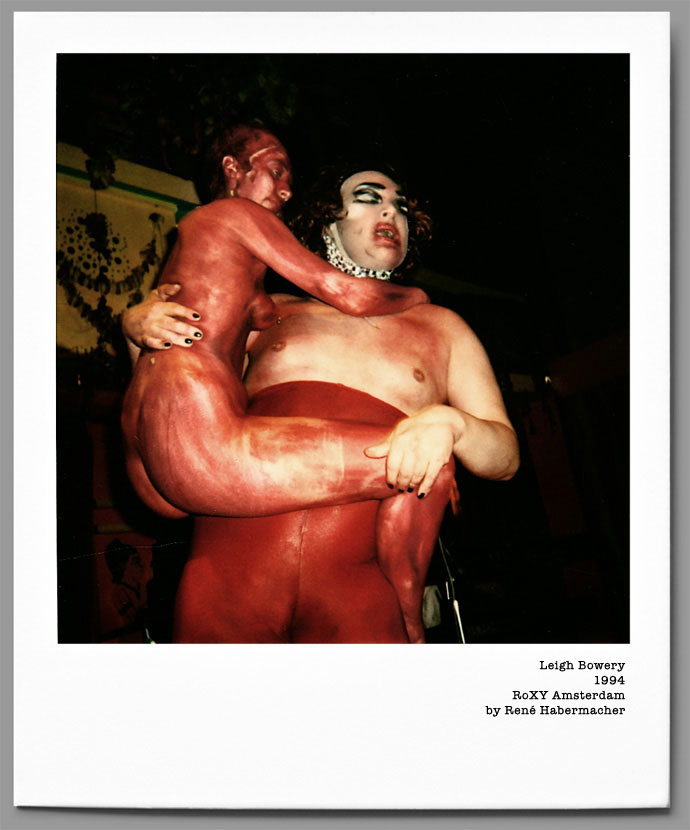
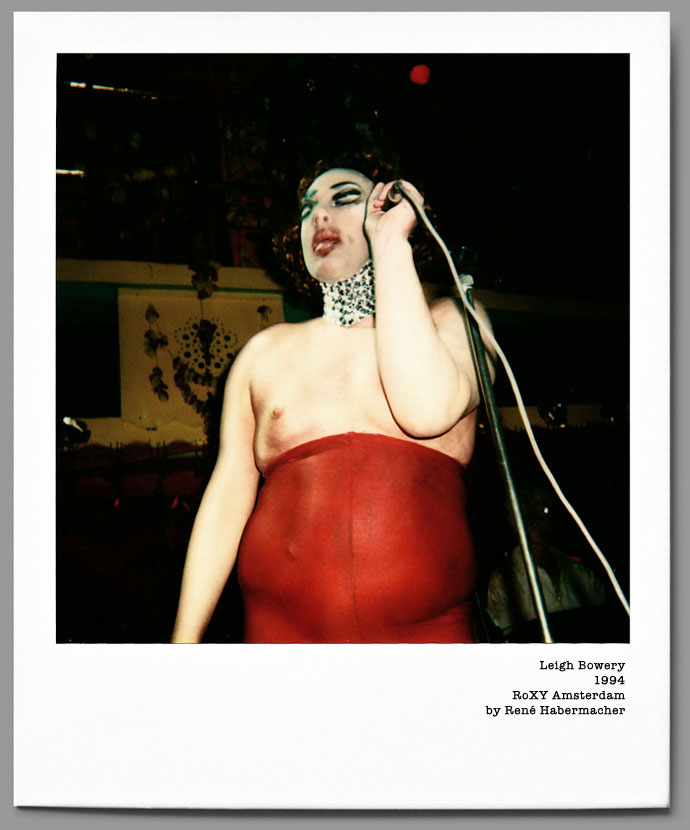
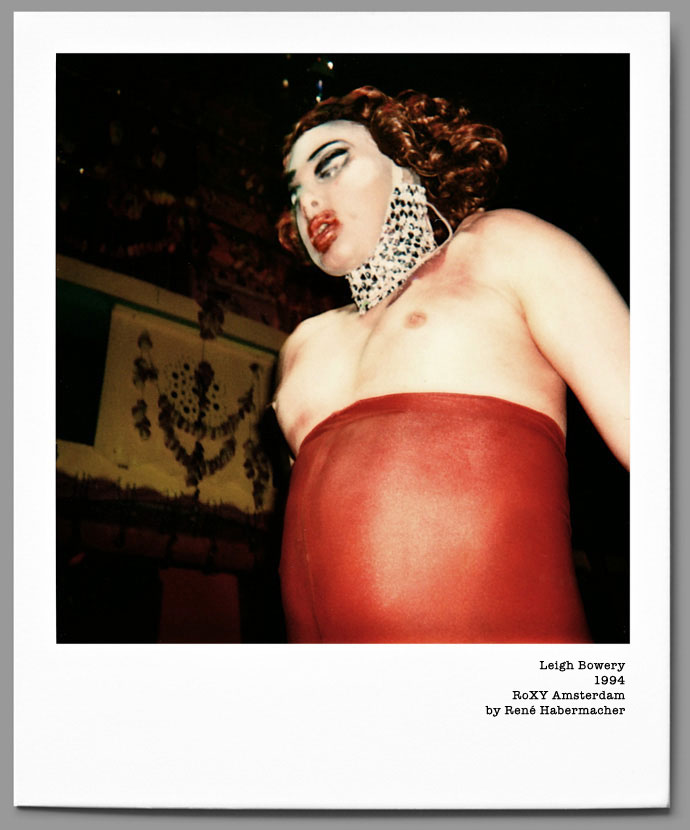
Leigh Bowery on stage with the MINTY. Polaroids by René Habermacher.An exhibition of photos by the club’s photographer Cleo Campert will be on show later this summer at the LUX Photo Gallery Amsterdam from 18 June – 18 July: The RoXY Years / De RoXY Jaren
Cleo Campert: “In this show I emphasize the open sexuality and the indecent exposure which reigned in the famous night club RoXY in Amsterdam in the early nineties.”
